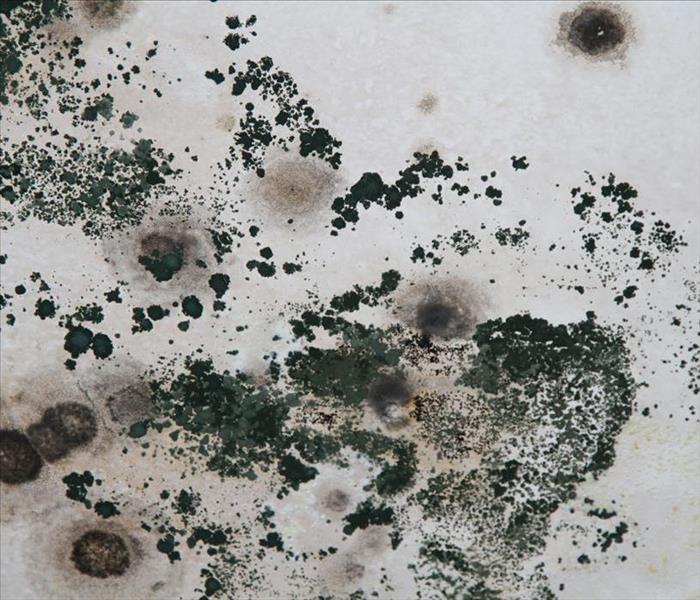Archived Blog Posts
3 Ways To Clean Contents After a Fire
1/31/2022 (Permalink)
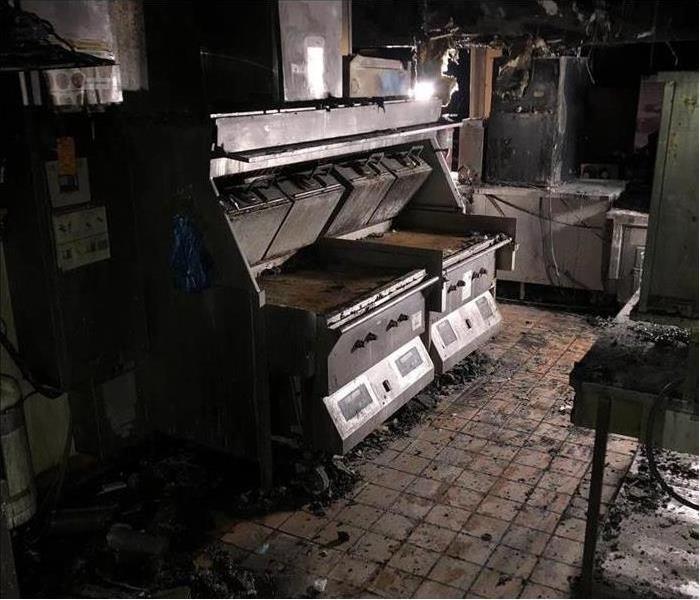 Commercial fire damage in a kitchen in Chalfont, PA.
Commercial fire damage in a kitchen in Chalfont, PA.
Cleaning Your Contents After a Fire
Even without catastrophic structural damage, a fire can wreak havoc on your property. From smoke damage, to water damage from firefighting efforts, there’s a surprisingly long list of ways that fires create a mess. The good news is there are lots of options for cleaning up your content, from elaborate fire restoration to simple dry-cleaning. Here are a few of the ways you can get your Chalfont, PA, property back to normal.
Fire damage typically evokes thoughts of broken windows and burnt through roofs. But fire damage also often includes:
- Smoke damaged clothing and personal property
- Water logged carpets and furniture
- Soot stained upholstery and carpeting
And that’s just for starters. Fortunately, there are professionals there to help.
Dry-Cleaning
This simple process is one of the easiest ways to handle smoke damage. Drapes and other fabrics can be dry cleaned in place to remove the pervasive smell of smoke, soot and burned goods as well as getting rid of stains. Be sure to choose a fire restoration or textile restoration company that specializes in fire damage for the best results.
Fire Remediation
This typically involves removing water - an important part of ensuring your business is safe for use. Water that gets beneath carpet pads and festers in walls can become a breeding ground for mold. Fire remediation firms use suction devices and industrial dryers to get rid of every drop.
Cleanup Services
Typically offered as an add-on to remediation, cleanup services focus more on cleaning, deodorizing and restoring personal property. This can include spray and wipe cleaning, foam cleaning, abrasive cleaning, immersion and much more.
Cleaning up plays a big part in getting back to normal after a business fire. Fortunately, it’s not something you have to tackle yourself. Contract with experts in dry-cleaning, content storage and other fire content cleaning and your property will be as good as new.
A Helpful Guide to Water Heater Flushes
1/13/2022 (Permalink)
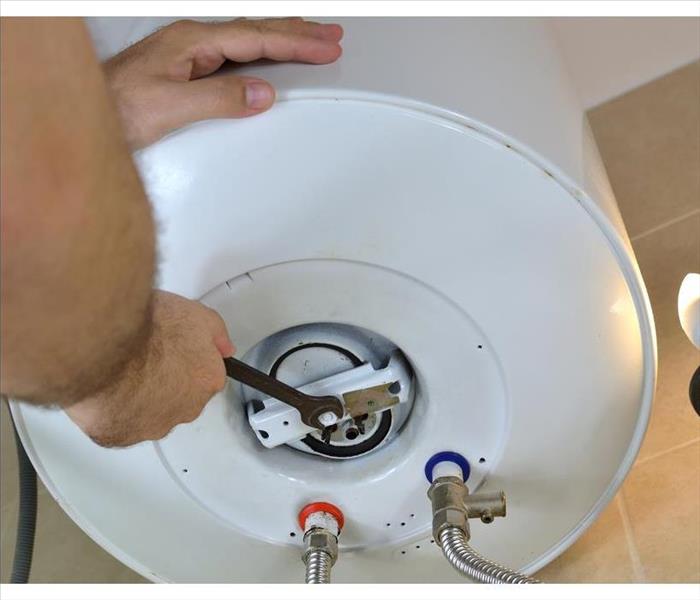 Completing a routine flush can prolong the life of your water heater.
Completing a routine flush can prolong the life of your water heater.
A well-functioning water heater is a key component inside most homes in Doylestown, PA. Like other appliances and systems inside your residence, this important piece of equipment requires routine maintenance. In fact, most professionals recommend a tank flush approximately every one to three years. Although it may sound intimidating, the process is usually straightforward and offers several benefits.
Benefits of a Water Heater Flush
Your home’s hot water source works consistently to maintain an adequate supply. Performing a water heater flush can benefit this device in several ways:
- Rids tank of built-up mineral deposits
- Helps unit run more efficiently
- May prolong heater’s life
An efficient water heater may also reduce energy costs, saving you money in the long run.
Initial Steps
To begin the cleansing process, you should complete a series of essential steps:
- Turn off the thermostat
- Disconnect heater’s power source
- Shut off cold water supply valve
- Open pressure release valve
To help prevent an air vacuum inside your lines, you may want to also turn on a hot water faucet in a sink or tub and keep it open throughout the water heater flush.
Drainage Procedures
To drain the tank, connect a hose to the drainage spigot and open the valve. Placing the other end of the hose inside a large bucket or laying it outside away from your home’s foundation may prevent accidental water damage.
Once the unit is empty, open the water supply valve and allow fluid to flow through the system until all the sediment is removed and the liquid runs clear.
Finalizing the Project
When you’re ready, close the pressure relief and drainage valves and allow the tank to fill. Once it's full, you should reopen the pressure valve to release any air pockets. Then, reconnect the power source and wait approximately 20 minutes for the water to warm.
A Useful Maintenance Procedure
Replacing a water heater can be very expensive. Although every device eventually fails after extensive use, completing a routine flush can prolong the life of your appliance, helping to ensure you have a consistent supply of hot water available.
How To Prepare For a Flood If You Live in a Flood Zone
1/8/2022 (Permalink)
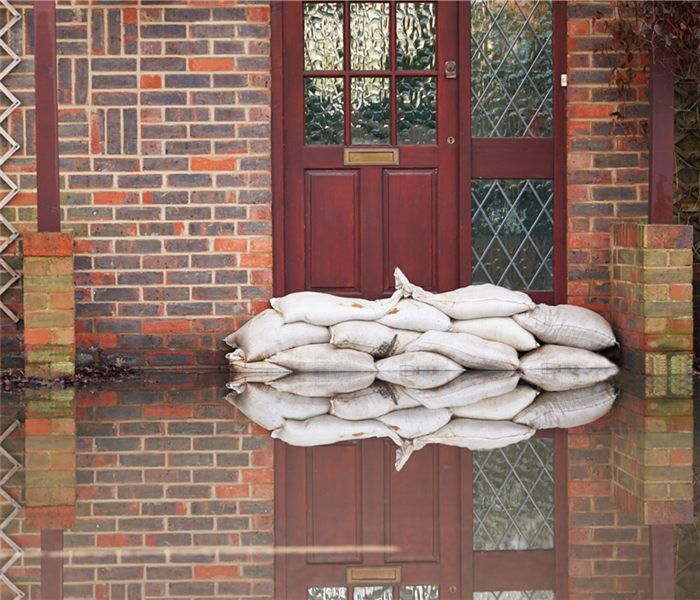 Prepare your home in case of flood damage.
Prepare your home in case of flood damage.
Protect Your Home From a Flood and Financial Security
Many homeowners may assume that their homes are safe from floods if they live away from coastal areas and large lakes and rivers. However, no residence is immune from this potentially devastating threat. To assess your home’s risk, access your community’s flood map on the FEMA NFIP website. If you reside in an area vulnerable to flooding, there are several steps you can take to help protect both your home and your financial security.
Purchase Flood Insurance
One of the best ways to protect yourself from potentially devastating flood damage is to purchase a flood insurance policy. Home insurance policies do not typically cover this peril. Without coverage, you may have to fund expensive cleanup and restoration costs out-of-pocket. If you have questions regarding flood insurance, you should contact your insurance company. You may also find useful information on the FEMA NFIP website.
Be Prepared
To help minimize potential flooding damage, homeowners residing in flood zones should safeguard vital equipment and have essential tools readily available. Adequate preparation should include the following initiatives:
- Elevating HVAC equipment off the basement floor
- Purchasing a sump pump and hose
- Having a functioning backup power source accessible
- Preparing sandbags or obtaining a reusable flood deterrent device
Accomplishing these steps may divert floodwaters away from your home, protect essential equipment from extensive damage if flooding does occur, and help you quickly drain standing water out of your house.
Complete Home Maintenance Procedures
As an additional safeguard, every homeowner in New Briton, PA, should also complete routine maintenance procedures, such as clearing debris from gutters. If you have a basement, you should also check for cracks and holes in the walls and promptly fix any existing issues.
Be Proactive
The FEMA NFIP website offers useful tools that can help educate homeowners about both specific flood risks and flood insurance. Although it may be impossible to fully eliminate your home’s flood risk, completing appropriate proactive measures may help minimize flooding damage or allow you to avoid costly out-of-pocket expenses. Taking preemptive action is particularly essential if you live in an area susceptible to flooding.
No, Your Leaky Toilet Is Not Normal
12/26/2021 (Permalink)
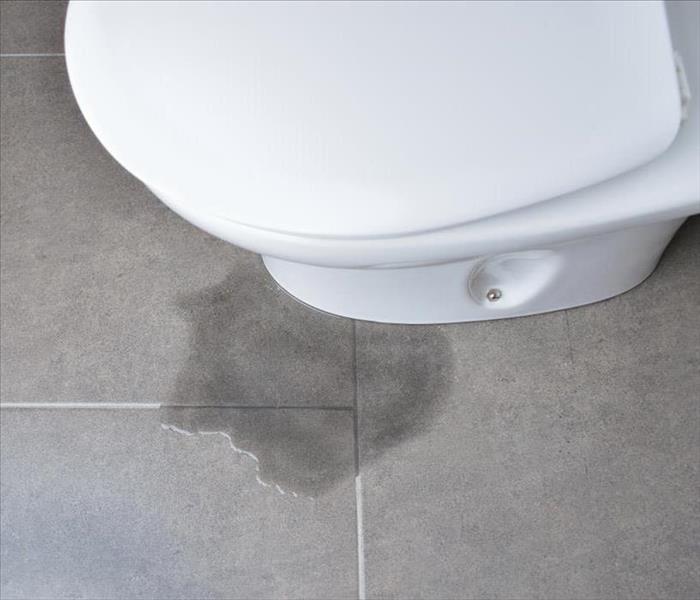 A leaking toilet can cause significant damage to your property.
A leaking toilet can cause significant damage to your property.
A Leaking Toilet Is Not Normal
To get the most out of your Buckingham, PA, home, you need a functional, attractive and comfortable bathroom. Few things can ruin its condition faster than a leaking toilet. If your commode leaks every time you flush, you may have a bigger problem than you think.
Water Leaks Cause Significant Damage
A bathroom leak is not something you can take lightly. In fact, even a small leak can cause serious damage. If you have a leaky toilet, you may find damage to the following:
- Toilet
- Tile
- Carpeting
- Subfloor
- Baseboard
Toilet Leaks Are Common
Leaky toilets are a common occurrence. Generally, assigning blame for a leaking toilet is not difficult. In many cases, a dry wax ring is the culprit. To seal properly, rings must remain moist and pliable. As the ring ages, cracks and brittleness can encourage a leak to form. On the other hand, improper installation may be the reason your toilet leaks. Either way, you should not ignore the problem.
Leaks Often Require Remediation
When you have a leak in your bathroom, you must take certain steps to deal with it. While repairing the toilet may stop the leak, it is still possible that you have serious secondary damage. Specifically, you may need to remove and replace damaged fixtures, flooring and other items. You may also need to address mold and mildew growth. Since containing mold requires specific equipment, knowledge and skill, it’s often a good idea to leave the job to a reputable mold remediation service.
If your commode leaks when flushing, you may think a leaking toilet is normal. It isn’t. Your toilet should not spill water onto the floor, but a leak can also cause significant damage. By understanding the typical causes of toilet leaks and knowing how to prevent them, you can keep your bathroom in tip-top shape.
What Happens When Fire and Water Damage Combine?
12/13/2021 (Permalink)
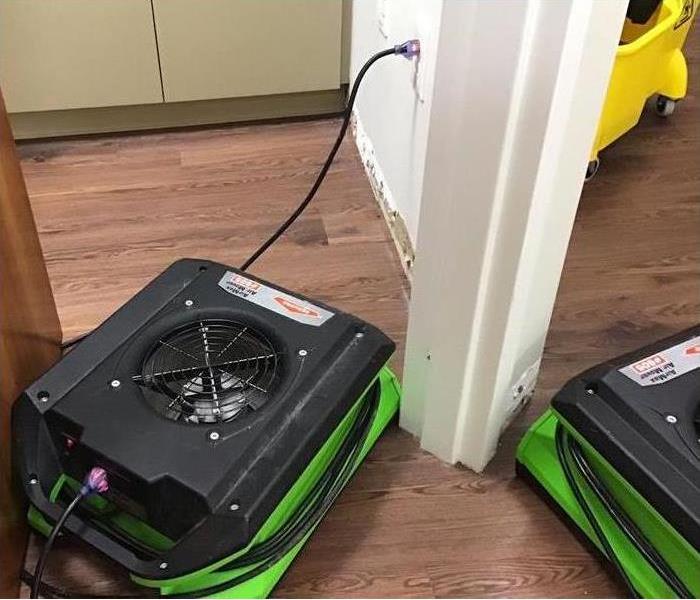 Water cleanup services in Doylestown, PA.
Water cleanup services in Doylestown, PA.
Water and Fire Damage
Fire damage can destroy building materials and contents. Standing water introduced by fire suppression efforts may cause flooring and furniture to warp and lead to mold growth. Each type of damage intensifies the other, giving rise to a situation that may be difficult for homeowners to remedy. Restoration professionals can repair and restore damage caused by this combination of factors.
Damage Caused By Fire
Fire burns building materials and contents in a structure, causing damage due to excessive heat and exposure to smoke. This type of damage calls for specialized mitigation methods, including:
- Removing ash and soot
- Repairing or replacing materials and contents
- Eliminating smoke damage
Cleanup and restoration should take place as soon as possible after a fire. The presence of water leftover from fire suppression efforts may cause a delay.
Damage Caused by Water
A fire hose can dispense anywhere from 300 to 800 gallons of water per minute. Cleaning up after a fire has been extinguished may involve:
- Pumping out standing water
- Cleaning ash and soot residue
- Drying and dehumidifying
It is necessary to remove the water before fire damage restoration can proceed. Restoration experts can do so quickly to limit the amount of combined damage and the risk of mold growth.
Combined Damage
Fire and water damage can ruin delicate or porous contents and materials. The following measures may be necessary:
- Tearing out and replacing building materials
- Using specialized content cleaning methods
- Taking measures to prevent corrosion or rot
The presence of both types of damage can pose a challenge to homeowners. It is best to hire a mitigation and restoration company to get the job done.
Fire damage and water damage are likely to be present after a fire at a home in Doylestown, PA. It is important to act quickly to clean up and mitigate both types of damage to prevent conditions from worsening.
5 Steps To Stop Constant Flushing
12/13/2021 (Permalink)
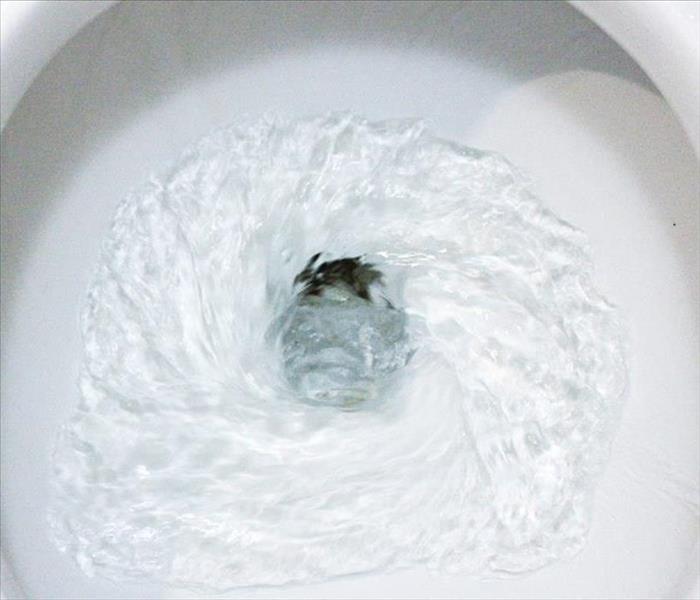 A toilet that flushes repeatedly can cause a lot of problems in your commercial building.
A toilet that flushes repeatedly can cause a lot of problems in your commercial building.
5 Ways to Stop Flushing Constantly
A toilet that flushes repeatedly can cause a lot of problems in your commercial building. It can result in toilet overflow, and it can significantly increase your utility bill. The flushometer is designed to flush a commercial toilet efficiently, but if it malfunctions, it keeps flushing, even when it doesn't need to do so. Here are five steps to fix the problem.
1. Turn Off Water
When you look at your manual flushometer, you should see the slot where the screwdriver head goes. Insert the screwdriver and turn until the water source is shut off. This will help prevent a toilet flood while you are working on it.
2. Take-Off Lid
Remove the lid of the flushometer. You may have to use a wrench to get it started, but after that, you should be able to unscrew it by hand.
3. Reveal the Gasket
When you remove the flange, you should see the gasket. The most cause of flushometer malfunction is a clogged gasket. Right away, you can tell if there is a problem because the gasket and possibly the weep hold will be full of sediment.
4. Clean the Gasket
Remove the gasket and clean it thoroughly to prevent further toilet overflow that has to be mitigated by water restoration professionals. Wash the gasket and, using a small tool such as a pin, clear out the weep hole port.
5. Reassemble the Flushometer
Place the cleaned gasket back into the flushometer. Screw the lid back on, tightening it with a wrench if necessary. Turn the water back on to see if the problem is resolved. If not, you may have to call a plumber in Chalfont, PA, who can stop a toilet from running.
It's important to make sure the plumbing in your commercial building is working properly. To prevent toilet overflow, clean the gasket on your flushometers regularly.
3 Things You Must Do To Repair Your Business’s Leaky Roof
11/23/2021 (Permalink)
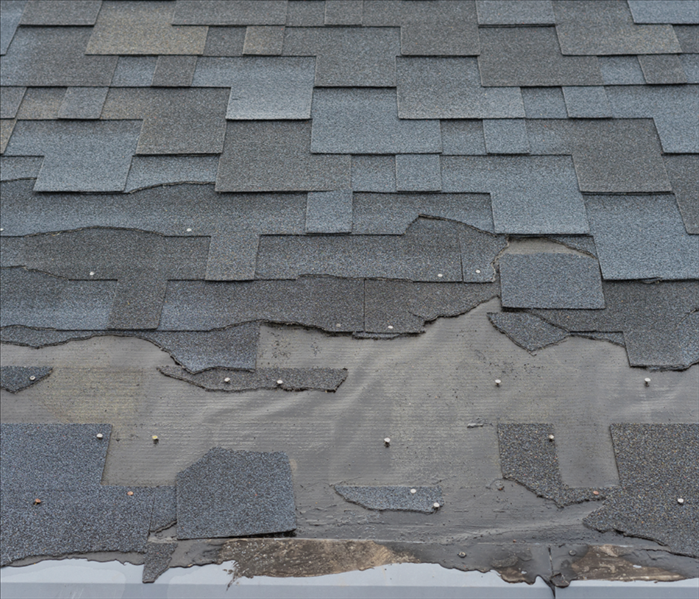 Strong winds and heavy rain can result in missing shingles.
Strong winds and heavy rain can result in missing shingles.
Three Things You Must Do To Repair Your Company's Leaky Roof
If your business in New Brighton, PA experiences a roof leak, it’s important to start the cleanup process immediately. However, you may be uncertain about how to stop further damage and clean up the area. There are several steps you should take to make sure your damaged roof is properly fixed.
1. Remove Wet Materials
As soon as you become aware of a roof leak, it’s important to remove any materials that are wet. Rugs and other items made of cloth are often breeding grounds for mold to grow and moving out anything that has been damaged is necessary to prevent mold growth. By moving all wet items out of the affected area, the cleanup process can happen more quickly and efficiently.
2. Dry and Clean the Area
Once all wet items and materials have been taken out of the affected area, the next step is to focus on drying and cleaning what has not been badly damaged. Depending on the amount of damage sustained, it might be necessary to replace carpeted floors, damaged inventory or other items entirely. However, it is often possible to disinfect items after they have been dried. Floors, walls and other areas can be disinfected with special products as long as they are not badly damaged.
3. Make Needed Repairs
When everything has been dried and it is safe to do so, restoration is the final step to fixing your roof. Unfortunately, a leaking roof often occurs in conjunction with other issues. A combination of strong winds and heavy rain can result in missing shingles, holes in the roof or other problems. To prevent further damage to your building, the structure of your business’s roof will need to be fixed.
A roof leak doesn’t have to cause your business to close its doors if you quickly act as soon as you notice a leak. Working with professionals in water damage restoration will ensure that your business’s roof is fully restored.
Preparing for A Home Adjuster Visit
11/23/2021 (Permalink)
 Work with your home adjuster to process your request.
Work with your home adjuster to process your request.
Preparing for A Home Adjuster Visit
When water invades your home in Doylestown, PA, it can create a need for extensive repairs. Materials need to be tossed. Rooms need to be fixed. Furthermore, in the midst of all of the chaos, you also need to consider how to work with your insurance agency. You'll need some organization, documentation and patience, so consider the following as you prepare for the home adjuster to visit.
1. Establish a Claim
The pipe burst and your room flooded. Everything is soggy, and you just don't know what to do. Contact your insurance company that day. In fact, do it while the plumbers are there. That may seem overwhelming, but you'll need to establish an insurance claim, and you don't want to wait. Your request can be denied if you don't show immediate action. Grab your card, look up the phone number and speak to someone. During this conversation, spend time discussing your policy, asking about procedures and expectations. Because it's a trying time, take notes or record the call. You may need to review it for details later.
2. Document Everything
The home adjuster will ask for lists, so get prepared and start keeping tabs on everything. Create an Excel spreadsheet, or grab a notepad. Whatever you decide make it neat and orderly. Then, write down any money spent on the home repairs. Only make the immediate needs, and hold onto receipts. Jot down contact information and take pictures of the work. Then, begin collecting information on anything that has been ruined because you may have compensation for lost goods. Photograph damaged goods, and then look up the cost to replace each belonging.
3. Gather Bids
Allow the company to review your documents. While this occurs, meet with water remediation companies to discuss the cost of restoration. Each business should provide you with an itemized inventory, detailing materials and costs. Submit these to your insurer, and converse about which company best satisfies your needs.
Work with your home adjuster to process your request. It may take time, but your thorough notes and packet of receipts might help the process run smoother.
4 Fire Safety Tips for Cooking on the Grill
11/9/2021 (Permalink)
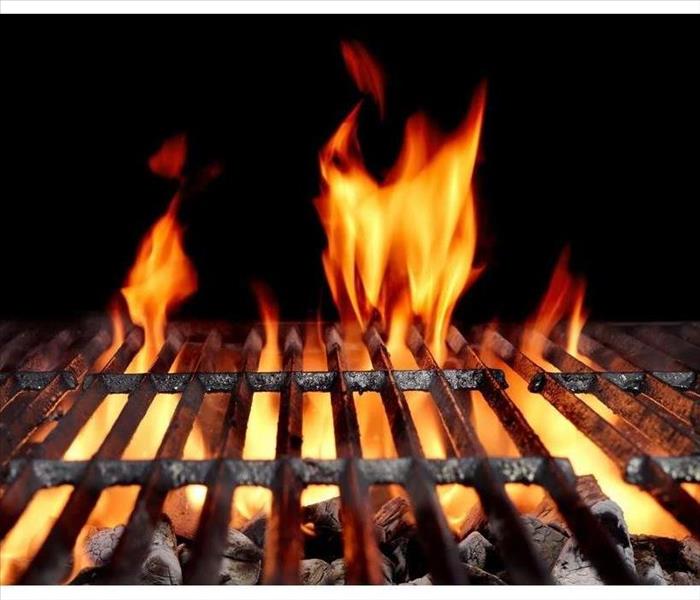 Avoid an outdoor fire while cooking.
Avoid an outdoor fire while cooking.
Avoid Outdoor Fires While Cooking
There are few things as satisfying in the summer as the smell of a good grill fire with your favorite foods on the barbeque. Unfortunately, those great summer experiences can quickly turn into bad memories if the grill isn't used properly and dangerous fires occur. Use the following safety tips to avoid the wrong type of outdoor fires while cooking.
1. Keep Your Grill Away From Combustible Materials
Many Buckingham, PA, homeowners store their grill up against the house or against the deck railings. Don't be tempted to use the grill in that position; if for no other reason than avoiding smoke damage. Make sure there's plenty of space around the grill, including moving it away from overhanging eaves and branches. This should also include keeping children and pets away from gas and open flames.
2. Regularly Clean the Barbeque
One of the easiest ways to avoid a surprise barbeque fire is to remove the buildup of grease and fat that accumulates over a summer's worth of cooking. The sizzle of juices dripping onto hot coals is great while you're attending the fire, but it's nearly as much fun when you're caught off-guard by a grill fire.
3. Don't Leave Your Grill Unattended
Whether you're using a charcoal grill or a gas barbeque, don't assume it can run safely without your supervision. Fire remediation professionals stress than an appropriate cooking fire can quickly grow out of control (even on gas grills), so keep an eye on the barbeque until the unit has been safely turned off and the flames have all been completely extinguished.
4. Contact a Professional If Something Isn't Right
Whether it's the smell of gas or you hear an unusual sound when oy turn the propane tank on, move away from the grill and contact a professional with experience handling a grill fire. Your safety is the most important thing on the calendar during the summer. Protect it by following these safety tips when you decide to cook over an outside fire.
Key Areas to Assess for Mold Growth Inside Your Home
9/27/2021 (Permalink)
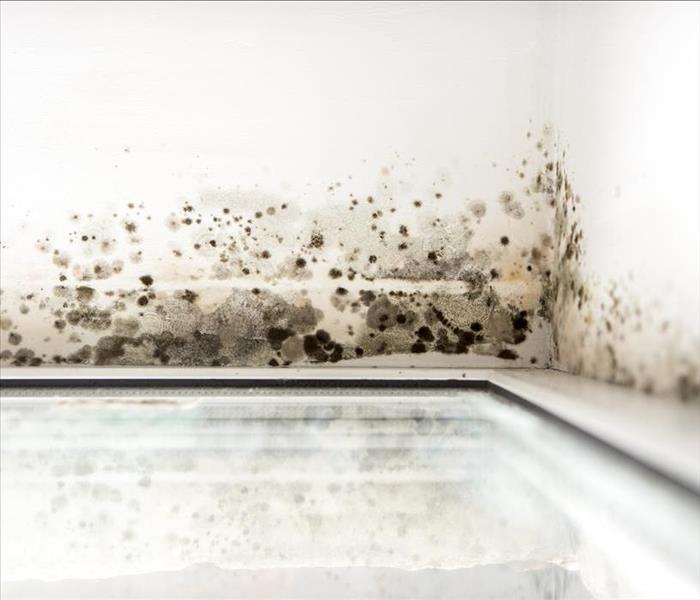 In the event of a flood, a clean-up and restoration specialist can provide professional assistance, including mold remediation.
In the event of a flood, a clean-up and restoration specialist can provide professional assistance, including mold remediation.
Mold spores are very small, and they can grow in numerous areas of your home. The key ingredient for mold growth is moisture. How many items in your home encounter water on a regular basis? Your list may include dishes, the toilet, bathtub, shower, and dishwasher, and each of these items and many more are indeed susceptible to mold.
Appliances
Two appliances in your home that regularly utilize water are the dishwasher and washing machine. If you keep the doors or lids of these devices continuously closed, moisture may be constantly present, creating a potential breeding ground for mold. To reduce the risk, you should routinely clean these appliances according to manufacturer recommendations.
The Bathroom
Nearly everything you do inside your bathroom involves water, so it’s not uncommon for mold to grow in this area. Specific locations that you should routinely check include:
• Tile floors and showers
• Inside and around sinks
• Toilets
• Toothbrushes
To reduce the risk of mold in the bathroom, you should use mold-resistant caulking around your tub and sinks. You can also turn on the vent while taking a shower and wipe down the shower’s surface when you finish. To prevent mold growth on your toothbrush, you should replace it approximately every three months.
Hidden Spots
Mold can also find hiding places inside your home that are not readily visible. If your home floods from excessive rainfall or a burst pipe, you must quickly remove wet items and dry the affected area. Failing to remove saturated building materials may result in moldy drywall and mold-infested carpets. If moisture is not efficiently eliminated, you may also find mold on wooden cabinets and under laminate flooring.
A Manageable Problem
Mold growth is an unpleasant find for any homeowner in Chalfont, PA, but monitoring potential hiding spots inside your home can help you quickly address the issue, if it arises. Additional prevention strategies include efficiently addressing leaks and eliminating excessive moisture. In the event of a flood, a clean-up and restoration specialist can provide professional assistance, including mold remediation.
6 Ways to Reduce Your Home’s Flood Risk
9/16/2021 (Permalink)
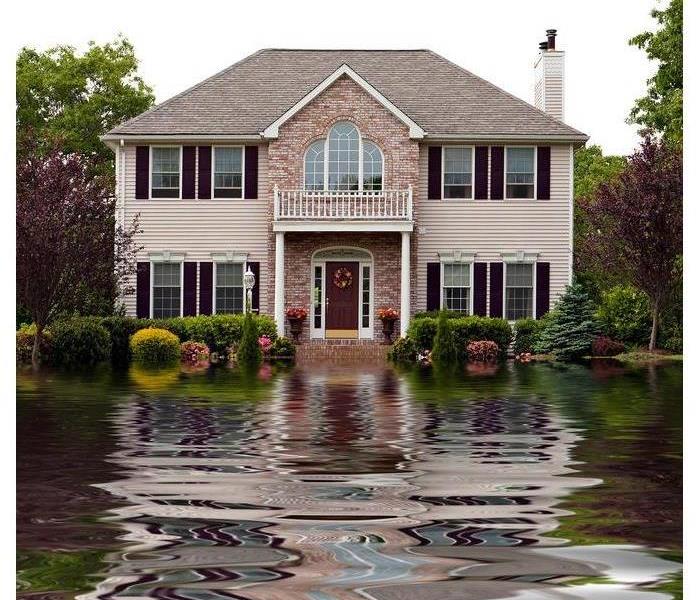 Following these seven flood safety tips helps reduce your home’s flood risk.
Following these seven flood safety tips helps reduce your home’s flood risk.
Floods are often unavoidable. Although you may not be able to fully flood-proof your home, every homeowner in Doylestown, PA, can take proactive prevention and flood safety measures to protect their properties against extensive flood damage.
1. Prepare Sandbags
If you receive adequate warning of an approaching storm capable of producing significant rainfall, such as a hurricane, create an external barrier with sandbags, which can divert water from your residence.
2. Install a Sewage Water Backstop and a Sump Pump
A sewage water backstop is an efficient flood safety device that prevents backwater from flowing into your basement. A sump pump is another beneficial machine that can drain water out of your home.
3. Assess Basement Windows and Your Foundation
A cracked foundation may enable water to flow inside your basement. Water can also seep through basement windows. To secure these areas, ensure that windows are properly caulked and sealed and repair any existing foundation issues.
4. Maintain Gutters
Routinely clean your gutters to prevent blockages that may restrict water flow. In addition, install downspout extensions to direct water farther away from your home’s foundation.
5. Plant Grass and Use Mulch
Both mulch and grass absorb water. So planting grass around your home and placing mulch around external foliage provides an additional flood safeguard. However, to ensure retained moisture does not damage siding, keep mulch at least six inches away from your home’s exterior.
6. Properly Grade Soil
Grading the ground away from your home is another efficient safety tip that also helps divert water away from your foundation.
Peace of Mind
Following these seven flood safety tips helps reduce your home’s flood risk. However, it is impossible to fully eliminate the threats of extreme weather and bursting pipes. For this reason, the best flood safety measure is a flood insurance policy, which provides financial security and ensures that you have funds available to cover cleanup and restoration costs and replace destroyed property.
How To Prepare Your Company for a Possible Fire
9/9/2021 (Permalink)
 A fire preparation plan can help you protect both your assets and your workers during an emergency.
A fire preparation plan can help you protect both your assets and your workers during an emergency.
Protect Your Company From a Fire Disaster
A commercial fire can disrupt your Chalfont, PA, business in several ways. Your inventory or equipment could be destroyed. You also may have to temporarily shut down the premises while cleanup and restoration professionals rebuild the property. This could greatly reduce your cash flow and put your company at risk of closing. That is why you need a proper fire preparation plan.
Making a strategy in advance can limit the impact a fire will have on your business. Below are some ways you can protect your company from a fire disaster.
1. Create Recovery and Emergency Plans
Everyone in your company should know what to do when a fire or similar disaster strikes. Managers should have specific assignments, and employees should understand how to safely escape the building.
Your disaster preparation plan should also describe the steps for recovery. Specifically, the plan should detail how you will reboot your business once the crisis has ended.
2. Check Your Insurance
A proper insurance policy can prevent a fire from bankrupting your business. Make sure that your assets such as computers are insured for their replacement costs. You may want to buy separate equipment or building insurance as part of your fire preparation strategy, as well.
A business interruption policy can also be valuable. This type of insurance gives you cash to help your company stay afloat during the restoration.
3. Perform a Risk Analysis
It is easier to mitigate a disaster if you know what to expect. You should thus do a risk analysis to see how fire damage would impact your business. You can do this analysis for other types of emergencies such as floods and windstorms, as well.
No matter how hard you try to keep your building and employees safe, a disaster can still occur. A fire preparation plan can help you protect both your assets and your workers during an emergency.
How To Deal With a Pipe Break in 4 Easy Steps
8/19/2021 (Permalink)
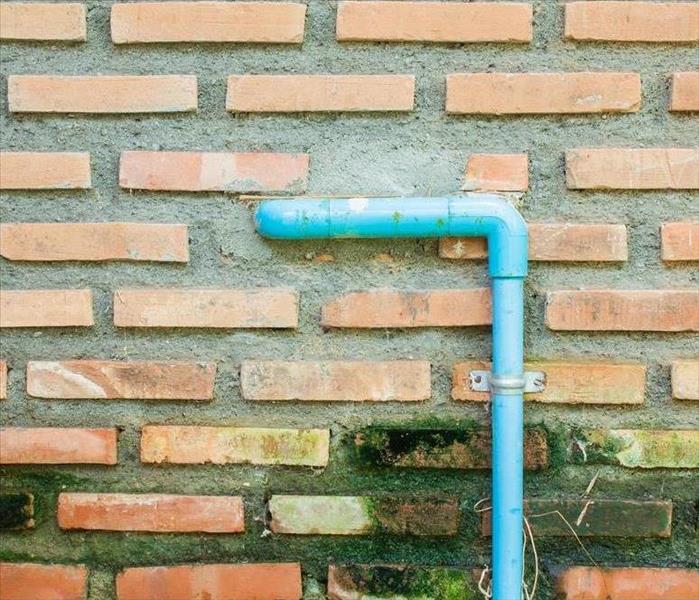 Water damage can lead to serious problems. SERVPRO can help you.
Water damage can lead to serious problems. SERVPRO can help you.
How To Handle A Pipe Break In 4 Simple Steps
Has a pipe burst in your Doylestown, PA, home? Bursting pipes can lead to loads of issues and stress. Knowing what to do in this type of situation can make the restoration process go a little smoother. Use the following tips to help you deal with flood waters from broken pipes.
1. Call in Professional Help
Water damage can lead to serious problems. You need the help of a plumber and a water restoration team to really deal with the issue. However, professionals might not be able to get there right away. Even after you've called in some help, do the next steps to help mitigate damage done to your home. If you simply wait for help to arrive, the flooding in your house could get a lot worse.
2. Stop the Water
Bursting pipes can lead to lots of water filling your home. Reduce the flooding damage by cutting off the water supply. You can shut off the water to your home by turning off the valve at the meter and the valve off of the meter. Turning off the water supply at both locations makes it more likely that the water will remain off.
3. Increase Safety
Before you can get someone in to fix a broken pipe, you need to make sure it is safe to walk through the standing water. This means turning off the electricity in your home until you have assessed the safety of the water. If you fail to do this step, anyone who walks into the standing water could get zapped.
4. Move Important Belongings
Once the relative safety of the water has been determined, you can start moving your personal possessions out of the waterlogged area. Start by moving your most important possessions to a high position. If you have time, you can move other pieces out of harm's way as well.
No one wants to deal with burst pipes. However, if the situation arises in your home, it's better to know how to deal with it than to be left scratching your head. Fast responses can help reduce the damage done to your home.
4 Reasons To Hire a Certified Mold Remediation Company
8/19/2021 (Permalink)
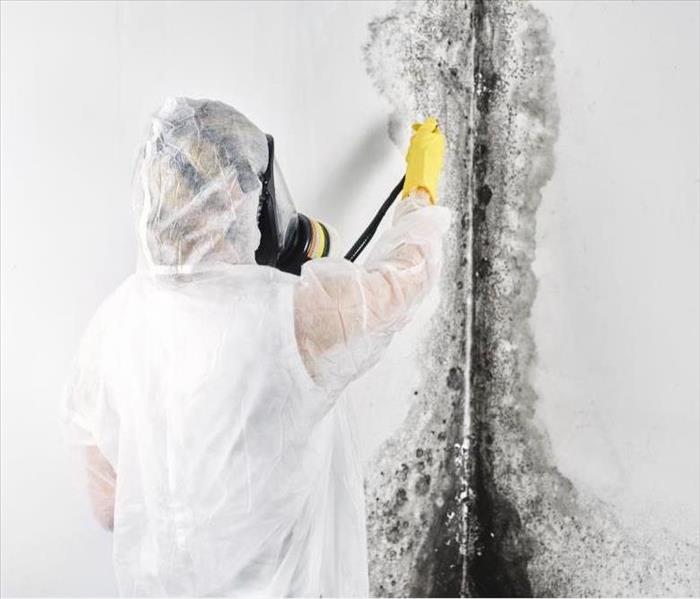 SERVPRO can help you stop the growth of mold in your home.
SERVPRO can help you stop the growth of mold in your home.
Four Reasons to Hire a Certified Mold Removal Company
A certified mold remediation company can help you stop the growth of mold in your home. Some uncertified general contractors offer mold services, but you should consider hiring a company with up-to-date mold certification. A certified mold service in Chalfont, PA, can save you time and money by making informed choices at the right time.
1. Insurance companies prefer to work with mold remediation specialists that hold an Institute of Inspection Cleaning and Restoration Certification. This certification is based on current professional standards for water damage restoration and mold remediation.
2. A company that holds IICRC should be able to provide the best mold remediation services available based on the consensus of experienced and knowledgeable scientists and health experts. Hygienists, microbiologists, and public health professionals work together to set these standards.
3. When you hire certified mold experts, you can count on their awareness of the best practices for mitigating mold as quickly and effectively as possible. It is important to contact a service as soon as you suspect that mold may be a problem, ideally within 24 hours after conditions conducive to mold growth occur anywhere in your home.
4. A reputable remediation company should follow established protocols for mold testing, diagnosis, containment, removal, disposal, and restoration. They should provide the services necessary to get rid of the mold in your home and not try to upsell unnecessary services. You may wish to obtain the opinion of an independent hygienist to consult before and after remediation.
These are just a few reasons why a certified mold restoration company is the best choice when you need to eradicate mold from your home in Chalfont, PA. The difference between having inexperienced contractors or experts with mold certification attempt remediation can significantly impact whether these repairs are covered by insurance as well as the long-term results of the mold restoration process.
3 Ways Hail Can Cause Damage to Your Commercial Building’s Roof
8/10/2021 (Permalink)
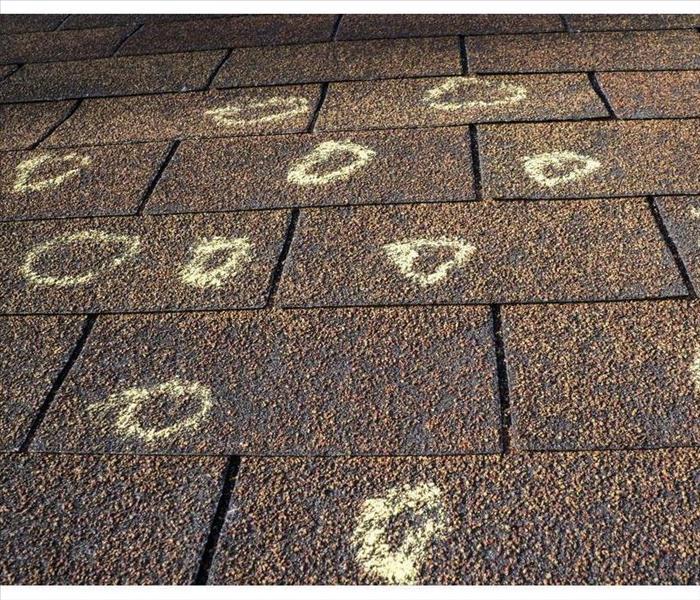 Hail damage on roof.
Hail damage on roof.
Three Ways Hail Can Damage Your Commercial Building's Roof
Hailstorms that move through Buckingham, PA, can wreak havoc on your commercial building. One of the most common results of hail is roof damage, which might contribute to other issues like leaks and water stains on ceilings and walls. There are several ways hail can impact your building’s roof and being aware of them might help you better assess the damage the next time a storm occurs.
1. Cracked or Broken Shingles
One common result of hail damage is cracked and broken shingles. This can be especially common when the hailstones are large. Cracked shingles may allow water to seep in between the flashing or the tar paper and the roof, which may weaken those areas. Broken shingles may peel away completely and leave sections of the roof vulnerable to wind and rain. A commercial restoration service can repair and replace shingles to restore your roof’s integrity.
2. Water-Damaged Insulation
When roof damage occurs as the result of a hailstorm, melted hailstones can seep in under cracked tiles and reach insulation in your building’s attic. Over time, the insulation may weaken or begin to rot, depending on the amount of exposure. This can cause unpleasant musty odors and drafts as the insulation begins to fail. If your area experiences frequent hailstorms, you may want to have your insulation checked several times a year.
3. Increased HVAC Leaks
Large hailstones can damage your roof’s HVAC system and increase leaks each time you run it. Hail can bend or dent fan blades and impact the system’s condenser coils. An HVAC system that leaks may eventually weaken the roof surrounding it and cause water damage around the building’s interior vents. A noisy unit may clue you in to hail damage, especially if you notice new sounds after a storm.
Buckingham, PA, hailstorms can cause considerable roof damage and disrupt your business. Being aware of potential issues caused by these storms can help you be better prepared to deal with them if they should arise.
What is Black Water, and Why Is it a Problem?
7/27/2021 (Permalink)
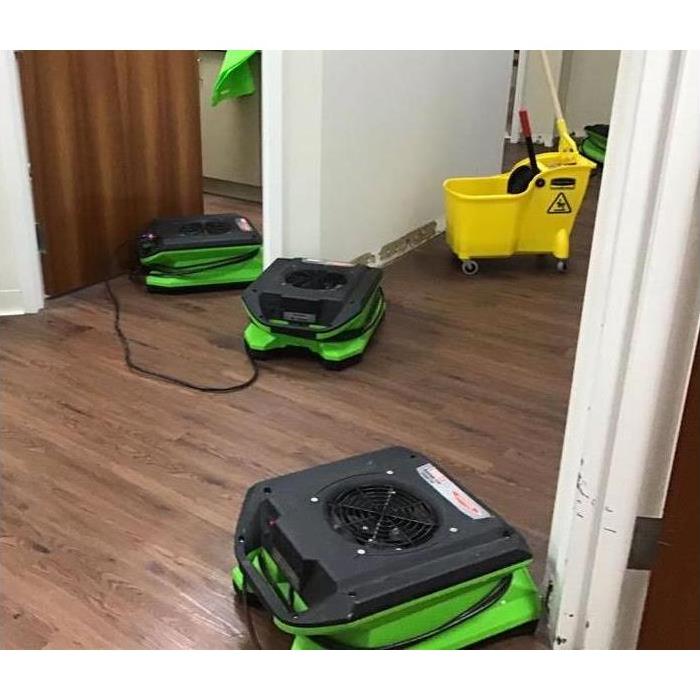 Storm damage cleanup services.
Storm damage cleanup services.
While areas of the world are more prone to flooding problems than others, water damage can occur in any home. You may not think too much about these issues, but if you understand the potential consequences of a flood, you would do everything in your power to protect your home and property. One of the biggest concerns you should have is sewage getting into your Chalfont, PA, home.
Black Water Facts
Black water is so named because it is flood water mixed with raw sewage. It is formed when sewage lines break or when excess water finds its way into sewers and then makes its way into homes or onto streets. This type of water can also come from overflowing toilets.
The Dangers
When water creeps into your home—whether it’s a small amount or a few feet deep—you should worry about water damage to your flooring, walls and possessions. But sewage in the water can be just as problematic. Because this type of water carries feces, urine and other harmful substances, it poses a major health risk to you and everyone in your home. If you come into contact with this water or ingest it, you could experience serious health effects.
What Can You Do?
The best way to prevent sewage from getting into your home is to call upon a specialist to examine your plumbing. A technician can ensure that your septic system and all the plumbing systems in your home are sound and intact. If this water still infiltrates your home, call a professional immediately to clean it up. Also, leave the affected area as soon as you can.
If your home experiences flooding, be on the lookout for water damage and for the potentially devastating black water. Follow these guidelines to identify this type of water and to protect yourself from it.
Top 6 Fire Safety Tips For Children
7/15/2021 (Permalink)
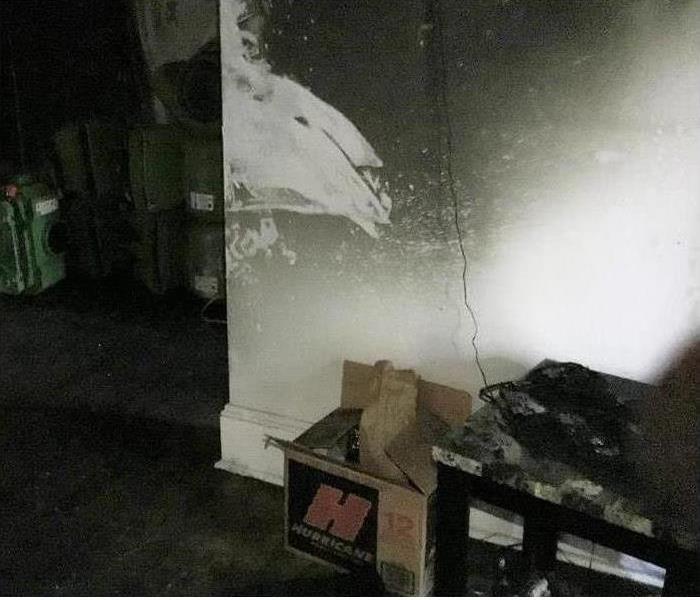 You can help your children by properly educating them on fire safety.
You can help your children by properly educating them on fire safety.
Safety Tips For Children
If the fire alarm went off in your home, would your children know what to do? Would kids know where the family could go for safety? Parents often forget that children are not intuitively aware of how to escape from the building during a home fire. Nor are children aware of how quickly a fire can spread. To help ensure kids safety, take time to review these top eight fire safety tips for children.
1. Windows can be escape routes. Small children may not be able to open a window, but they can be taught to go to a window and wait for help.
2. Practice feeling the way out of the house. Check with your local fire repair professionals to see if they give classes to older children on how to exit a house at night in the dark.
3. Find the ladder to escape from upstairs. Teach children where to find a fire escape ladder on the second floor and how to navigate the rungs.
4. Smoke detectors can be your friend. Explain what the noise is when the smoke detector goes off, and let children know what to do when they hear the sound.
5. Don’t open doors and stay low. Children of all ages need to know not to open doors during a fire. Little ones should also understand that kids safety can depend on crawling along the floor instead of standing up.
6. Once you get out of the building, stay out. Often children want to go back into the house for a favorite toy. To prevent this, explain the necessity of staying out of your home and gathering at a prearranged meeting place.
Teaching your children these six escape tips can make the difference in how the little one copes in a disaster scenario in Chalfont, PA. Practice can also ensure the children are familiar with the potential situation and know what steps to take rather than standing and yelling for a parent. Kids safety can be difficult to ensure, but you can help them understand how to find a safe way out of the building.
13 Surprising Facts About Mold
7/15/2021 (Permalink)
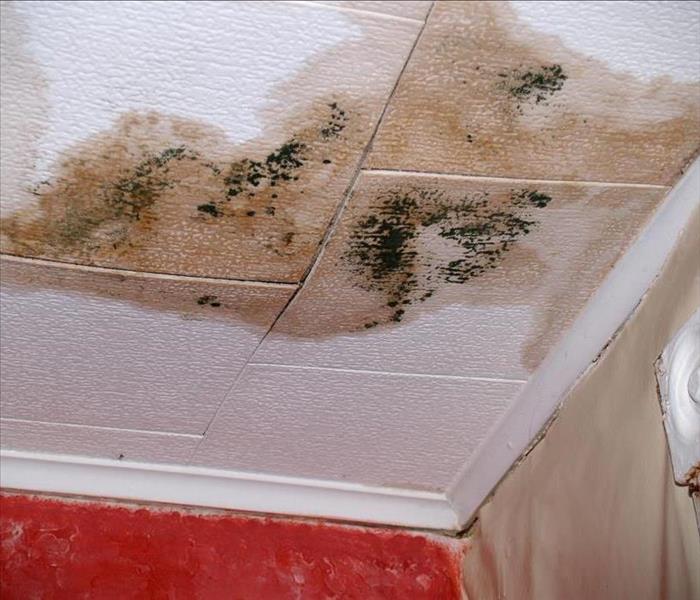 Mold can be a pesky and persistent problem in almost any commercial building in Doylestown, PA.
Mold can be a pesky and persistent problem in almost any commercial building in Doylestown, PA.
Have You Ever Wondered What Mold Is and Why It Exists?
The mold invading your property is part of the Fungi Kingdom and is related to mushrooms, yeasts, and the mold that develops on bread. Mold is a very efficient microorganism that our ecosystem uses to break down and clean up dying flora and fauna. Whether it is white mold or black mold, nature uses it to refresh the earth by removing dead organic matter. Here are some other surprising facts about mold.
1. Only a small amount of moisture is needed to bring mold spores to life.
2. Colonies of fungus can develop within 48 hours after water damage occurs.
3. Mold spores are almost always present in the air around you, even indoors.
4. Air movement as slight as a cough or sneeze can send mold’s microscopic spores into the air.
5. High humidity can encourage and support mold growth.
6. No matter how much mold cleanup you do, the colony will return unless the water source is removed.
7. There are over 100,000 varieties of mold.
8. Mold has an earthy and musty odor.
9. Mold eats organic materials, even inside your home.
10. Mold can look slimy, furry, powdery, or crumbly.
11. Molds from fungi have been used for hundreds of years to create cheese.
12. One of the first antibiotics was discovered by using mold.
13. There are many types of black mold, and most of them are harmless.
Mold can be a pesky and persistent problem in almost any commercial building in Doylestown, PA, and it is almost impossible for the layman to tell which type of mold is invading your property. One thing you can be certain of though when mold appears there is probably a moisture problem that must be dealt with. A mold removal and remediation team can stop the leak, remove the mold, and sanitize the area to prevent future black mold growth. Stop mold from eating its way through your building by fighting back today.
Important Maintenance To Prevent Water Damage
6/22/2021 (Permalink)
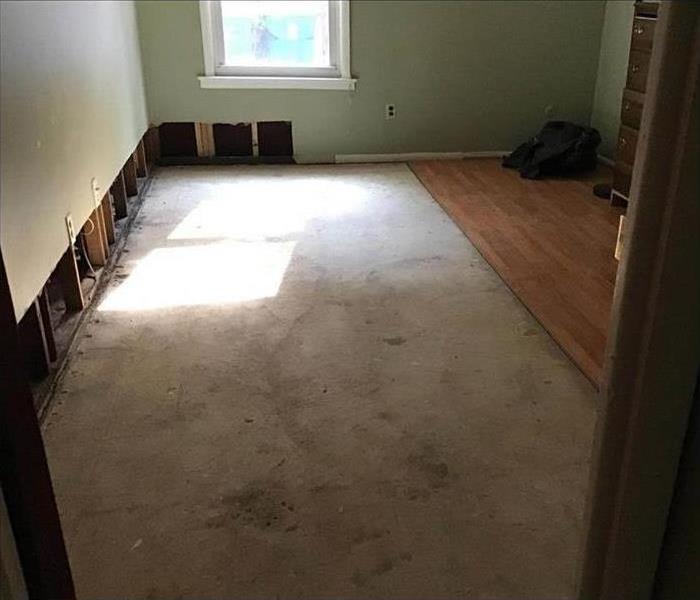 Water damage in a bedroom
Water damage in a bedroom
Prevent Water Damage
You never want to find water in a home where it doesn't belong. Standing water in your basement, bathroom, or living space can be a big headache. You have to call a residential water cleanup crew to get the long process of cleaning your New Briton, PA, home started.
- Assess the damage.
- Make a cleanup plan.
- Remove standing water.
- Replace damaged building materials.
With so much to do after a water-related disaster, it's easier to do whatever you can to prevent the damage.
Plumbing Components
A broken pipe can easily turn into a major disaster. If you have the plumbing components in your house inspected regularly by an expert, you may be able to avoid cracks and leaks that could lead to flooding. Not only do you want to check out the pipes, but you also need to have the toilets, tubs and other fixtures in your house inspected for faults.
HVAC Systems
The heating, ventilating and air conditioning of your house also has to be inspected. You should try to have the unit looked at in advance of whichever season it needs to be used. This will help you ensure you don't see water dripping, draining or leaking from the unit, which could cause excess water in a home.
Appliances
Even the appliances in your home have to be maintained to avoid unexpected water damage. Washing machines, refrigerators, water heaters and dishwashers could have cracked hoses, aging gaskets or faulty connections. If you have the appliances inspected annually, you'll be able to repair damages before they turn into leaks that cause a buildup of water in a home.
Doing maintenance on your pipes, HVAC and appliances call help you avoid the need to do a pipe cleanup after water floods into the livings spaces of your home. When you want to avoid working with a professional remediation team, you need to do whatever you can to keep disaster from striking your house.
4 Important Pieces of a First Aid Set
6/22/2021 (Permalink)
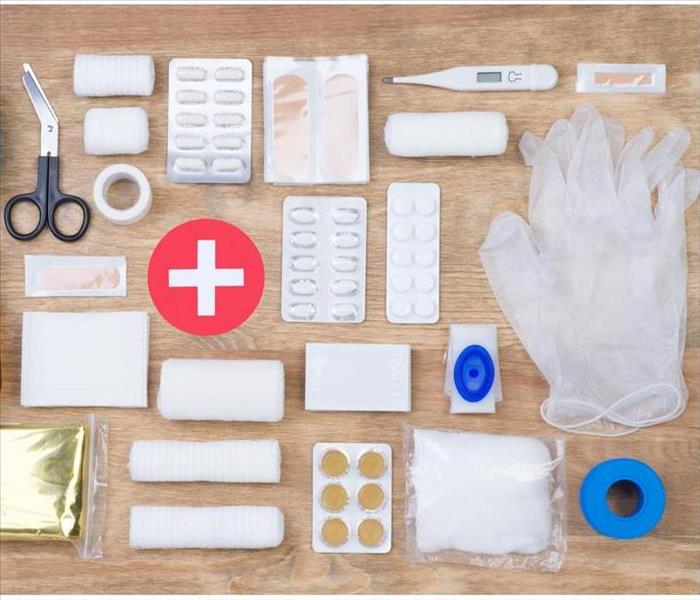 First aid kit supplies
First aid kit supplies
4 Important Pieces of a First Aid Set
As a building owner in Buckingham, PA, it is your responsibility to make sure the occupants of the space are prepared for emergencies. This can include having a commercial restoration team on speed dial to ensure your business can get back up and running after a flood or storm damage. It can also mean preparing an escape route for a fire. You should also create a first aid kit that stays on site.
Your emergency kit can contain a wide variety of products. According to the Occupational Safety and Health Administration, your set should include the following items to meet the minimum criteria.
1. Bandages
Your kit should be ready for basic first aid emergencies. You can stock it with various sized gauze pads, adhesive bandages, roller bandages, triangular bandages and wound cleaning solutions to ensure all minor cuts and scrapes can be properly taken care of right away. Including adhesive tape and scissors will help ensure anyone who uses the kit can get the bandages cut down to size and stuck in place.
2. Resuscitation Equipment
No first aid kit is complete without some sort of resuscitation equipment. This can include a pocket mask or resuscitation bag. This emergency equipment can help your employees clear a person's airway.
3. Safety Gear
You may want to include some personal protective gear, such as gloves, tweezers, splint, elastic wraps and blankets, in your set as well. This type of equipment ensures everyone can safely handle emergency situations.
4. Guide
Finally, you want to make sure to include a list of important phone numbers in your emergency kit. These directions for emergency assistance make sure your well-trained staff never forget who to call for each type of emergency. You could also include a map of evacuation routes as an added precaution.
Creating a well-rounded first aid kit can help improve the safety of your building. Once you have your kit stocked, make sure you check it regularly to replace missing or outdated items.
3 Reasons Mold May Keep Returning To Your Home
6/10/2021 (Permalink)
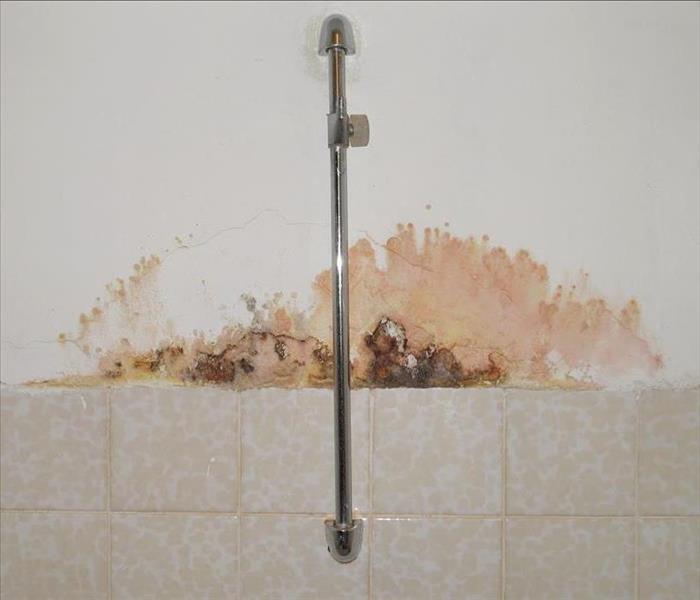 Mold damage in Buckingham, PA.
Mold damage in Buckingham, PA.
Why Does Mold Keep Returning Back?
When mold invades your Buckingham, PA, home, the results can be distressing. This can be especially true of black mold, which tends to grow quickly after a flood and may be difficult to remove. Understanding why this occurs and how to handle it may assist you with banishing this foul fungus from your home for good.
1. Using Bleach To Clean Mold
While bleach may seem like an effective mold cleanup solution, it can only make the problem worse. Mold thrives on moisture and the high water content in bleach usually only increases favorable conditions for growth. While bleach can change the color of mold patches and appears to affect it, it is likely the fungus will return and even grow faster afterward.
2. Leaking Pipes
Leaking pipes hidden away from sight, such as those in your basement, can cause black mold to return, even after repeated cleanings. Interior wall pipes in your basement and under kitchen or bathroom sinks that leak out of sight can cause mold patches to grow repeatedly. Checking hidden pipes at least a few times a year can resolve this issue and banish mold for good.
3. Ineffective DIY Solutions
Using mold solutions you can find at a local home hardware store may remove mold, but few stop it from returning. Mold spores may also travel through your home's heating and cooling pipes when you use do-it-yourself cleaning products, allowing those spores to settle elsewhere and grow anew. Contacting mold remediation and cleanup service can ensure any mold patches are cleaned up with commercial-grade solutions and that knowledgeable mold technicians provide you with long-term solutions that prevent fungi from re-invading your home.
It may seem that black mold appeared at your Buckingham, PA, home without warning after the initial cleaning. However, fungi can return quickly when the cleaning methods are not as effective as it needs to be, especially in the case of more serious growths.
How To Train Employees In First Aid for Burns
6/2/2021 (Permalink)
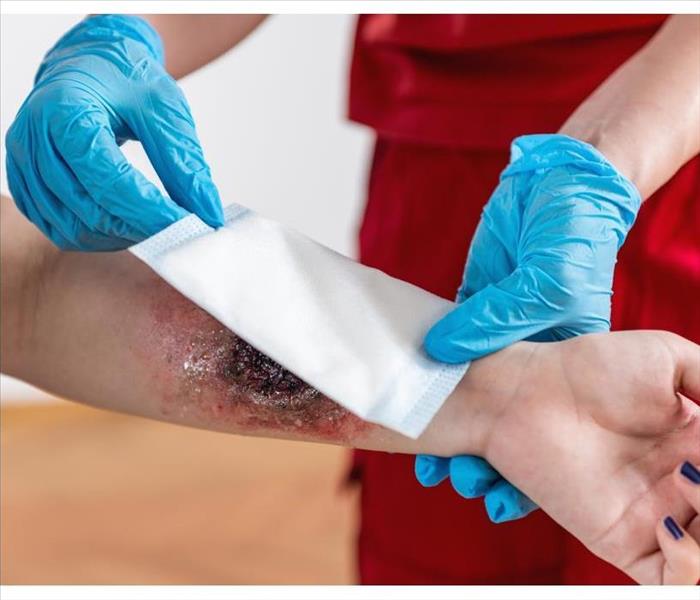 Treating burns requires skillful first aid and supplies.
Treating burns requires skillful first aid and supplies.
Learn How To Care For Minor and Major Burns
First aid is an essential aspect of disaster response. In the event of fire damage, early care can prevent burns from becoming more severe. Learn how to care for minor and major injuries and provide medical response training for employees.
Caring for Minor Burns
A minor burn covering an area no larger than three inches in diameter should be treated as soon as possible after the injury has been sustained. An employee should be prepared and equipped to take the following steps:
- Apply a cool compress
- Hold the burn under cool running water
- Remove tight jewelry or garments
- Do not break blisters
- Apply soothing moisturizer
- Lightly cover the burn
These measures can limit cellular damage. If a blister breaks, clean the area and apply antibiotic ointment before re-bandaging with sterile gauze. With proper burn first aid, minor burns may not require emergency care.
Protecting Major Burns
Major burns suffered during fire damage require medical attention. Ensure the safety of the injured individual until emergency help arrives. Remove any restrictive items and cover the burn with a moist sterile gauze bandage or clean cloth. Elevating the burn above the heart level may be helpful, but immersion in cool water is not advisable. Severe burn victims may require rescue breathing and could be at risk of going into shock.
Training for Medical Response
A business or commercial property owner may want to schedule medical response training. This training should be conducted by a qualified expert. The medical response is an important aspect of limiting damage due to disasters.
Treating burns requires skillful first aid and supplies such as sterile gauze bandages, soothing moisturizers, and antibiotic ointment. Whether fire damage to a commercial building causes minor burns that can be handled on-site or major burns that require emergency medical help, medical response training supports the health and safety of a workplace located in Buckingham, PA.
Answering 3 Common Questions About Commercial Flood Insurance
5/12/2021 (Permalink)
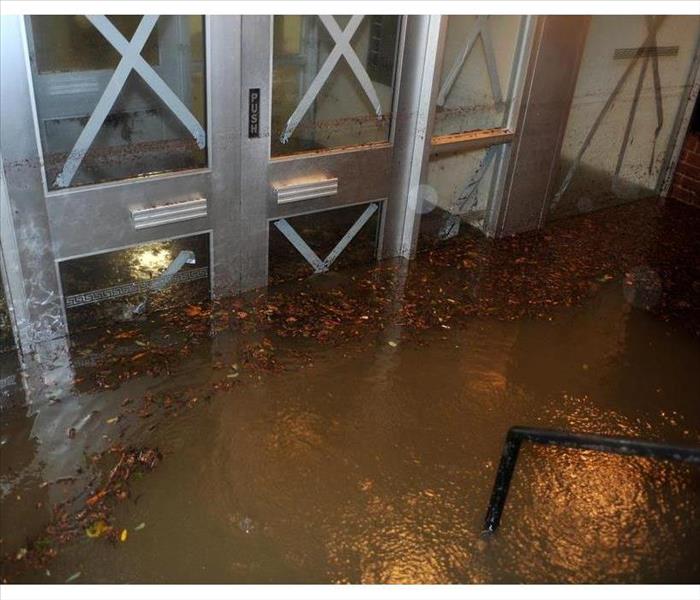 Flooded business in Chalfont, PA.
Flooded business in Chalfont, PA.
Commercial flood insurance can be a bit confusing. You have to purchase it separately from your regular property insurance. There are also some exclusions to most flood policies. Here are the answers to some common questions about this type of insurance.
What Is a Flood?
Essentially, a flood occurs when water accumulates on dry land. However, the NFIP has a more detailed definition. The NFIP describes a flood as the complete or partial inundation of water on a normally dry area that contains either two or more properties or two or more acres. It can result from mudflow, runoff, or an overflow of tidal waters. Common causes of floods include:
- Broken levees or dams
- Heavy rain
- Fast-Melting snow
- Post-hurricane storm surges
What Does This Insurance Cover?
As its name implies, flood insurance protects your property from flood damage. You can only purchase it from the NFIP, which offers up to $500,000 in-building coverage and up to $500,000 in personal contents coverage. This money can go toward emergency restoration services.
Building coverage includes harm that occurs to the actual structure, including the HVAC, plumbing and electrical systems. Contents coverage, meanwhile, pays for damage to furniture, equipment and other items inside the property.
While flood policies are fairly thorough, there are certain exceptions. Any property outside your building, including company vehicles, is typically excluded. Insurance also will not cover damage to precious metals or currency.
Who Has To Buy This Insurance?
Many business owners should consider purchasing flood coverage since it is not included in typical commercial insurance policies. However, if your company is in a high-risk flood zone and has a mortgage from an insured or federally regulated lender, you are required to purchase flood insurance.
The NFIP lets business owners purchase flood coverage for both their building and the items inside it. This insurance could keep your Chalfont, PA, company afloat following a storm.
3 Common Types of Fire Damage
4/29/2021 (Permalink)
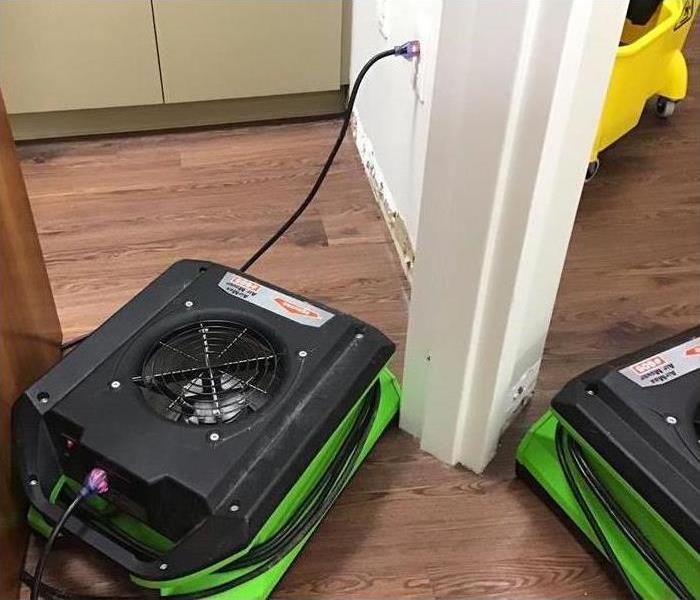 Fire and water damage in Doylestown, PA.
Fire and water damage in Doylestown, PA.
Three Types Of Damage Caused By Fires
One of the reasons that fires tend to be so destructive and expensive to recover from is that they usually cause multiple types of damage, requiring a variety of restoration services, such as water cleanup. These are three types of damage commonly caused by fires.
1. Smoke Damage
Almost all building fires generate a substantial amount of smoke, which can permeate structures and contents causing damage such as odors and stains. Smoke cleanup is often required to completely remove lingering smells and prevent additional damage. When smoke isn't completely removed, odors can persist for months or even years after a fire. Additionally, smoke residue can act as a corrosive agent, causing structures to deteriorate over time.
2. Water Damage
Water is an essential component of any attempt to put out a commercial fire. Most commercial buildings employ sprinkler systems, which can greatly reduce the spread of fires, but also cause substantial water damage to the building and contents. In addition to repairing the affected property, it is important to quickly employ water cleanup services to dry out the property. Otherwise, the excess moisture can cause additional damage and lead to other problems such as mold growth.
3. Fire Damage
The most obvious type of damage is the damage caused by the flames themselves. Fire can rapidly destroy the structural integrity of a building and cause severe damage to any property or inventory stored inside. The debris left behind often requires extensive fire cleanup. In some industrial settings, fires may cause explosions or the release of hazardous chemicals, making it important to immediately contact emergency services in Doylestown, PA.
Businesses need to be prepared to deal with more than just damage from flames when making fire preparation plans. Smoke and water cleanup may also be needed to fully restore the property to preloss condition and prevent additional damage from occurring to the property.
4 Things You Should Do After a Fire in Your Commercial Building
4/17/2021 (Permalink)
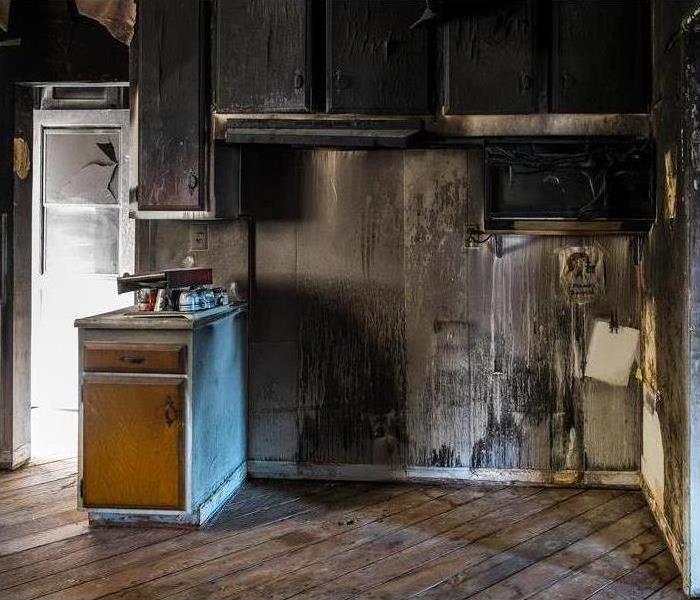 After an emergency, fire restoration should be done quickly.
After an emergency, fire restoration should be done quickly.
The Following Are Some Things You Should Do After A Fire
It can be easy to panic when a fire occurs in your Doylestown, PA, building, but you should try to stay as calm as possible in this situation. Doing so will allow you to think more clearly and take the necessary steps toward fire restoration once the emergency has passed.
1. Stay Out of the Building
Because a fire can affect the structure of the building, it may not be safe for you to go inside right away. Some areas may have been weakened and could possibly collapse. For this reason, you should stay outside until you are told otherwise. An inspection will need to be done first.
2. File an Insurance Claim
Particularly if there is a large amount of damage, but even if the affected area is small, you will need to start a fire insurance claim as soon as possible. Cleanup and repairs can be costly, and you don’t want to have to pay for these out of pocket.
3. Contact a Restoration Service
When a fire occurs, the flames are not the only thing that can cause damage to your building. Soot and smoke cleaning will need to be done because these elements can travel through the air and may affect a large area even if the fire was contained. If a hose was used, you will be dealing with water damage as well.
4. Document the Damage
It is important to document your loss and make a list of affected items. This information can be used by your insurance adjuster to help determine the amount of your claim. A fire damage remediation company can help with this task before they begin work on mitigation and fire restoration.
After an emergency, fire restoration should be done quickly. This process will include cleaning, rebuilding and odor removal to return your building to its previous condition. The sooner it is completed, the sooner you can return to business as usual.
The Importance of Backup Power
4/17/2021 (Permalink)
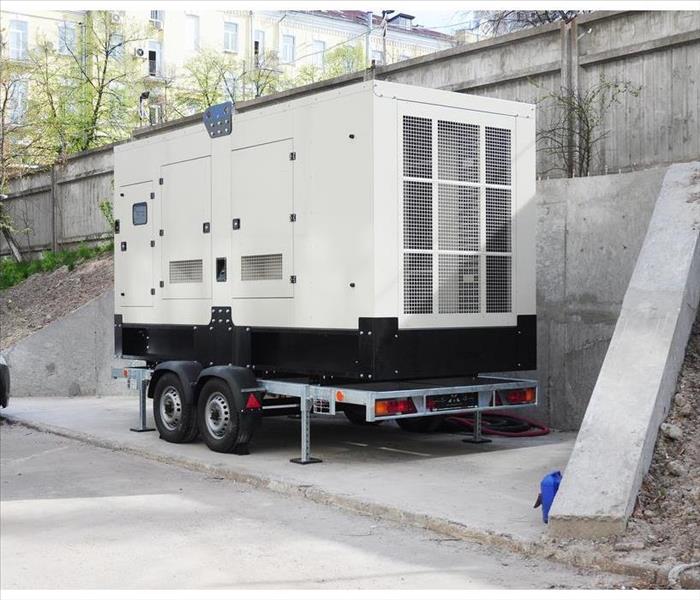 It's a good idea to have backup power for your business.
It's a good idea to have backup power for your business.
It's a good idea to have backup power for your business in Doylestown, PA. You never know when a big storm or a power outage will affect your company. One smart step to take is buying a commercial generator that is big enough and powerful enough to run either all of your company or at least keep critical systems going. The initial cost for this equipment can be significant, especially if you buy a large one or one that kicks on automatically when the lights go out. Your electrical system may need to be altered or upgraded to accommodate the new equipment.
When Is a Commercial Generator Needed
Numerous reasons exist that can knock the power out in your building. Here are just a few of the situations that can result in a disruption to your power grid:
- A major storm
- A substantial flooding event or plumbing issue
- An accident that takes down the power supply
- An earthquake
- A municipal blackout
- A power overload in your building
Many of these situations may be brief and will be taken care of through time or by a visit from an electrician. Others, though, such as a powerful storm or flooding, may last longer. By having a strong backup plan, your business can still serve customers and keep the lights on.
How Can a Generator Be Maintained?
To avoid generator problems, you should keep a few things in mind. Proper maintenance will extend its lifespan, which can be as long as 5,000 hours of use, and make sure it will work when needed. Only use the device as indicated in the owner's manual. Make sure all guidelines for ventilation are followed.
Being prepared is all part of being a successful business owner. You never know when a disaster will strike. Therefore, look for a company that is Faster to Any Size Disaster to help you with storm damage recovery and cleanup.
What To Do If You Smell Natural Gas In Your Home
4/8/2021 (Permalink)
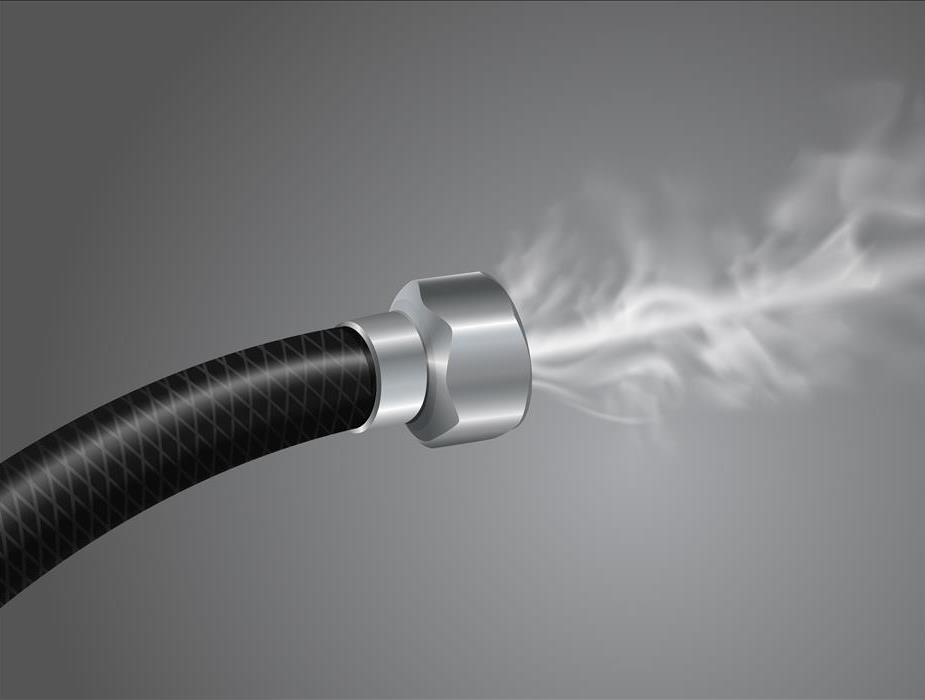 Natural gas is odorless, colorless, and nearly impossible to detect.
Natural gas is odorless, colorless, and nearly impossible to detect.
Ways To Prevent A Gas Fire From Breaking Out
Have you ever smelled natural gas? That’s a bit of a trick question. In its raw state, natural gas is odorless, colorless, and nearly impossible to detect. It’s also highly flammable — a dangerous combination. To reduce this danger, gas companies add a non-toxic chemical called mercaptan into the gas before distribution. Mercaptan is the source of that distinctive, “rotten egg” smell that most people associate with gas. The scent is unpleasant, but it makes a gas leak much easier to detect. If you ever smell mercaptan in your home, follow these precautions to prevent a gas fire from breaking out.
1. Keep the House Dark
Depending on the severity of the leak, any electrical current could spark a gas explosion. Don’t turn on any lights or other electrical devices. This includes battery-operated devices such as cell phones and flashlights. Never ignite a lighter or match.
2. Check Your Stove Knobs
A gas stove is one of the most common culprits of a gas leak, since bumping a knob can accidentally turn on the gas. Check the knobs on your stove to ensure that they are all in the “off” position.
3. Open Windows and Doors
Ventilating your home may help release some of the gas buildups that could lead to a gas fire. Open doors and windows, but only if you can do so quickly.
4. Get Out of the House
Evacuate the house, including pets. Do not start your car, especially if the car is in an attached garage. Don’t turn on your phone until you are a safe distance from the house.
5. Contact Authorities
When you are your family are safe across the street or down the block, call 911 or other emergency response service for Buckingham, PA, then call your gas company. Stay nearby and wait for help to arrive.
A home fire can be devastating, and fire damage cleanup is often long and arduous. Sticking to these tips will help minimize your risk of a gas fire.
Keeping Office Workers Safe and Productive During a Snow Storm
4/8/2021 (Permalink)
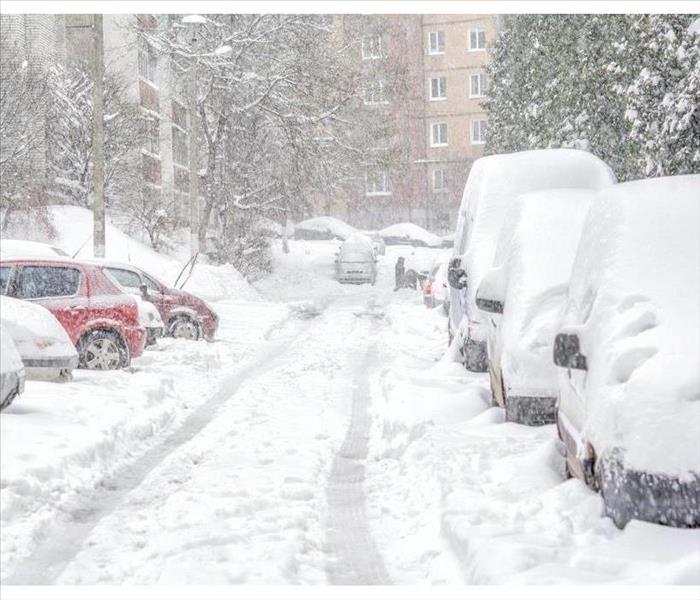 A massive snowstorm has the potential to cause severe workplace disruptions.
A massive snowstorm has the potential to cause severe workplace disruptions.
A massive snowstorm has the potential to cause severe workplace disruptions. Thankfully, technological advances have enabled offices to keep running even during inclement weather. During these times, always instruct workers to remain at home, where they can be both safe and productive.
Emergency Snow Kits
It's recommended that someone still arrive on-site in New Briton, PA, to watch for damage caused by intense freezing, such as a pipe burst. As soon as you identify a problem, contact a building repair specialist to repair the issue.
Those tasked with observing offices need winter weather emergency supplies stashed in their cars. Every vehicle needs:
- Jumper cables
- Flashlights
- Bottled water
- Sand
- Warm clothes
- Non-perishable snacks
These items can help assure safety even under the most perilous situations. Before hitting the road during a snowstorm, make sure your tank is full and your phone fully charged. These simple measures can make a world of difference.
Emergency Snow Warnings
The longer it takes to inform employees that they should remain in place, the greater the chance they will head out and fall into danger. Here are some tips for spreading the word as fast as possible.
Official storm warnings are generally issued between 12 and 24 hours before an imminent weather event. Tune into radio broadcasts and television stations with coverage that you trust and know will interrupt pre-scheduled programming. Create presets for The Weather Channel or your local weather station so you can quickly access the information you need. Install weather apps on your phone and turn on push notifications.
Have a list of everyone who works in your office. Make sure their phone numbers and email addresses are up-to-date and get in touch with them immediately after receiving news of impending winter weather.
Employees need to remain safe during a snowstorm, but they may still be able to work from home even under the snowiest conditions. With safety being the priority, early notification remains key.
The Consequences of a Plumbing Failure
3/3/2021 (Permalink)
 Water damage cleanup services in Chalfont, PA.
Water damage cleanup services in Chalfont, PA.
It is hard to overestimate the importance of the plumbing system in your home. When it is working properly, it carries hot and cold water to your appliances with ease. Just as importantly, when things go awry as in the case of a pipe break, the consequences are life-changing, at least for a little while. Water is spilled into your home in Chalfont, PA, threatening to cause damage to walls, flooring and personal belongings. Therefore, it makes sense to pay attention to what your plumbing system is telling you. Several signs indicate it is time for a plumbing inspection or regular maintenance on your pipes.
The Importance of Listening to Your Plumbing
Just as with a vehicle, sounds are sometimes the first sign that something is wrong, that a pipe break or some other calamity is imminent. The following noises in the plumbing indicate trouble:
- Whistling when a water faucet is turned on
- Chattering or banging
- Squealing
Your first option when you sense trouble is to try and troubleshoot the problem yourself. The more experience you have at this, the more likely you will be able to avoid a disastrous pipe burst by your efforts. Secondly, calling in a licensed plumber is often a good option. While this might be more expensive, it could save you the trouble of a major water spill in your home.
The Value of Professional Water Damage Mitigation
Any time water spills into your living space, it is smart to consider the services of a water damage restoration company. Highly-trained technicians will arrive on the scene quickly and work to fix broken pipe and take other actions. They will remove any standing water with the help of powerful pumps and vacuums. An experienced crew has the goal of restoring your home to its original condition. Experts can help you minimize the consequences of a pipe break in your home.
How To Know if Belongings Should Be Restored or Replaced
2/19/2021 (Permalink)
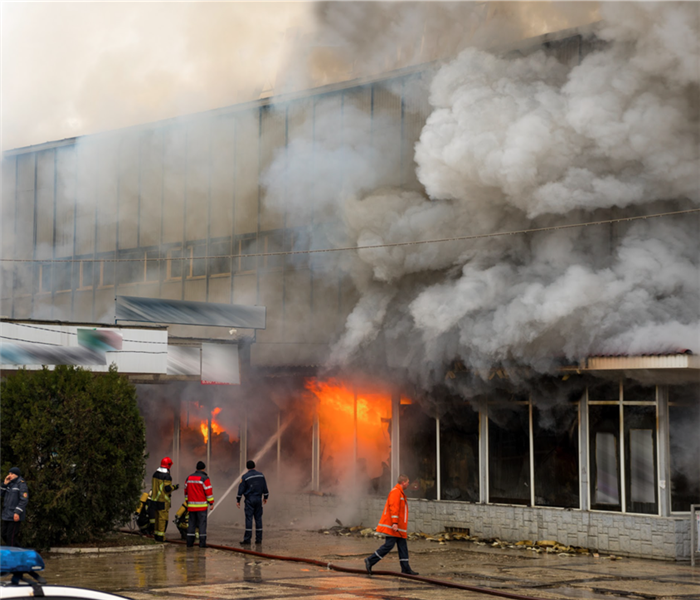 Commercial fire and water damage in Doylestown, PA.
Commercial fire and water damage in Doylestown, PA.
How To Know if Belongings Should Be Restored or Replaced
If your business in Doylestown, PA, has suffered from water or fire damage, you may be struggling to figure out what items should be replaced and what items should be restored. It can be difficult to figure out which option will be more cost-effective. SERVPRO's pretesting methods can help determine what can be restored to keep your insurance claim as low as possible.
Restoration
This water and fire restoration service can repair many different types of items, including:
- Upholstered furniture
- Photos and documents
- Fabric
- Electronics
- Carpet and rugs
They are able to clean soot off of surfaces, sanitize items, freeze-dry documents, prevent mold growth, and more.
Pretests
Insurance companies tend to prefer restoring items as opposed to replacing them. SERVPRO performs pretesting on items before attempting to restore them. This testing allows them to determine if an item can be restored before spending any time or money on efforts to restore the item. If they are able to restore an item, they will. If an item cannot be restored, they will recommend replacing it instead.
Insurance
Restoring belongings is generally less expensive than replacing them. SERVPRO of Doylestown, PA, saves you money by repairing as many items as possible, so you don't have to replace them. Testing belongings before restoring them also allows you to create a more accurate list of the costs associated with damages for your insurance agent. It also lowers your insurance claim by avoiding unnecessary restoration costs.
If your belongings have been damaged by water or fire, a restoration service that pretests damaged items can help. Pretesting is an important part of the restoration process. It allows the restoration service to determine what belongings can be restored before attempting to repair anything. This maximizes the number of items that are restored and minimizes costs associated with replacing items and unnecessary restoration attempts. Keeping those costs down lowers your insurance claim.
The 3 Types of Water Damage
2/10/2021 (Permalink)
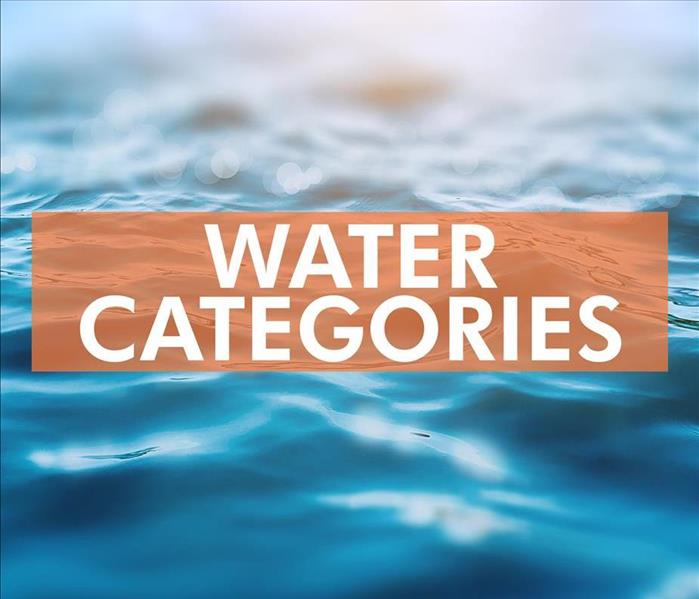 No matter what category the water is, you should promptly hire a remediation team to perform the cleanup.
No matter what category the water is, you should promptly hire a remediation team to perform the cleanup.
Types Of Water Damage
Whether you experience a water pipe repair job gone wrong or a sewage backup, you must immediately remedy the water damage. The first step to fixing your New Briton, PA, business's damage is to hire a water cleanup company. They will categorize the water, so the proper remediation steps are taken.
1. Category 1 or Clean Water
Category 1 water damage is the least worrisome and is often caused by a broken pipe, overflowing sink, or appliance malfunction. This is considered clean water because it is free of toxins and sewage. Typically, the restoration following the water pipe repair will be quick, and there will be few side effects for the building. However, have remediation performed as soon as possible to prevent further damage and mold growth.
2. Category 2 or Greywater
Category 2 damage is caused by greywater. This includes water from a toilet, washing machine, or sump pump backup. While the water may not necessarily be harmful, it is important to have a water pipe repair performed and follow it up with prompt restoration and sanitation to avoid potential health concerns and further damage. This type of remediation will involve water cleanup and sanitation.
3. Category 3 or Black Water
Category 3 damage must be remedied immediately and is the most dangerous of the water categories. This includes water from sewage, storm surges, seas, rivers, and other bodies of water. When this occurs, most of your items will need to be removed for cleaning, and it will take extensive disinfecting to make your business safe again. It is also probable that you will not salvage some of your items and building materials.
If you have recently experienced a flooded business, you should take action quickly. No matter what category the water is, you should promptly hire a remediation team to perform the cleanup. Otherwise, you could endanger yourself and have further damage to your building.
How To Prevent Mold Damage in Your Commercial Building
1/26/2021 (Permalink)
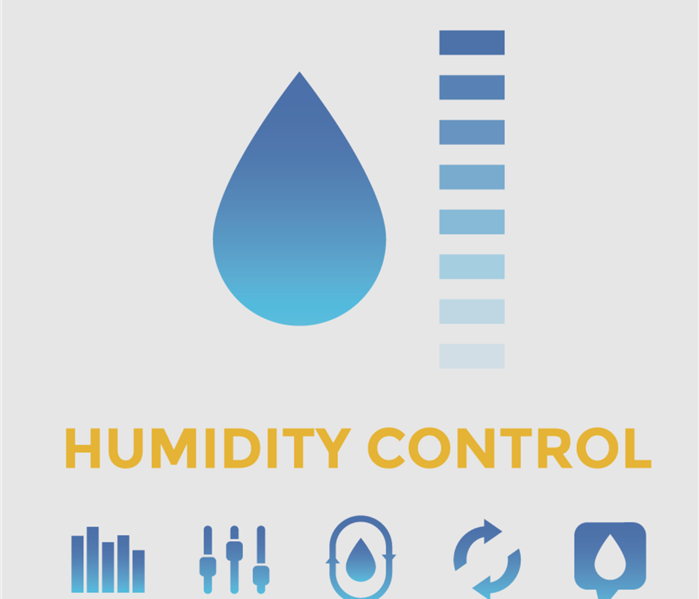 The humidity level inside your building should be no more than 60 percent
The humidity level inside your building should be no more than 60 percent
Mold Prevention Tips
Whether you own a large commercial building or a small store, you do not want mold to spread unabated throughout your Buckingham, PA, property. Mold growth can occur anywhere, including
- Above ceiling tiles
- Inside walls
- Around pipes
If an infestation occurs, you may have to temporarily close your building while experts perform mold cleanup and remediation. This shutdown could cost you a lot of money. Luckily, there are some simple ways to avoid extensive mold problems. Since the fungus thrives in wet areas, most mold prevention tips involve limiting water damage.
Addressing Water Issues
Start by surveying your property for signs of leaks. Plug those leaks immediately before they cause further harm.
You may also want to waterproof parts of your property. This could be expensive, but a mold infestation would be even more costly.
Pay special attention to sections of your building that are prone to flooding. If a flood does occur, have the water removed within a day or two.
Reducing Moisture
Mold does not only spread following major water damage. Even everyday moisture can encourage the growth of this harmful fungus. If your property uses stoves or dryers that create moisture, make sure those appliances are vented properly. You may also want to run an exhaust fan or open a window when these items are in use.
Indoor humidity is another common cause of mold growth. The humidity level inside your building should be no more than 60 percent. Use a moisture meter to monitor the humidity within the property.
Condensation is often a sign of excess humidity. Any drops of moisture on pipes or windows should thus be dried immediately.
To prevent mold in your building, you should reduce the excess moisture throughout your property. You should also clean up any water damage immediately. While the above tips will not completely eradicate the mold inside your building, they should prevent the fungus from becoming a major issue.
My Basement Flooded...What Now?
1/12/2021 (Permalink)
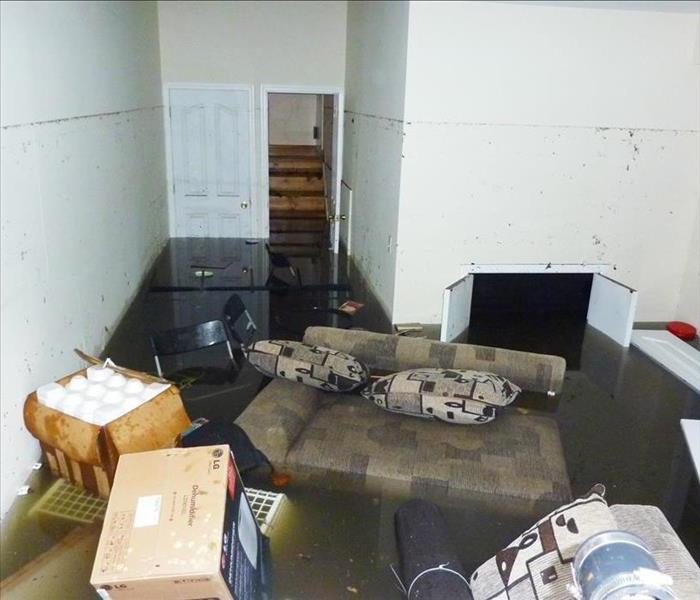 Flooded basement in Chalfont, Pa
Flooded basement in Chalfont, Pa
My Basement Flooded...What Now?
Whether caused by a rainstorm or a broken pipe, a basement flood is an awful event to discover. Homeowners' insurance often doesn't cover natural disaster or weather-related flooding, but it's worth it to hire professionals to make repairs and restore your basement to its former glory. However, there are a few steps you should take before they get there that can help smooth the process.
1. Stop the Leak
Verify the source of the flooding as best you can, without going into the water. If you can see where the water is coming from, turn off the supply to that pipe, or possibly even the whole house. If a failed sump pump caused it, try to get ahold of a backup and plug it in away from the water to start alleviating the flood.
2. Call for Help
Homes are full of electrical wiring and gas appliances that don't do well with water. If you have any reason to believe electrical outlets or wiring has been compromised, do not go into the flooded area and turn off the electrical supply. If you can't shut off the electrical supply without going into the water, call your local fire department, who can disconnect your home from the electrical grid and pump the water out. Be sure to turn off gas lines as well, which should be accessible from outside the home. These are both important because shorted wiring or appliances can turn your basement flood into a house fire.
3. Call Your Insurance Agent
Once your home is safe, you can start the process of recovery. Your insurance agent should be your first call to verify insurance coverage, file a claim if necessary, and get recommendations for contractors. If the flood was due to rainwater, it may not be covered, but your insurance agent can often help guide you through the repairs process.
If you discover you've had a basement flood in Chalfont, PA, don't panic. These first steps can help you get through the immediate aftermath and start you on the path to restoring your home.
3 Ways to Combat Smoke Damage to Your Commercial Building
1/12/2021 (Permalink)
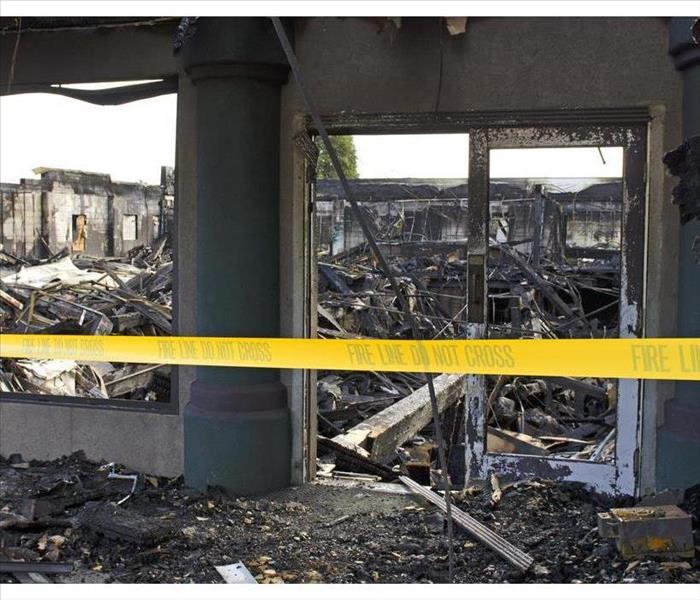 Commercial fire damage in Buckingham, PA
Commercial fire damage in Buckingham, PA
3 Ways to Combat Smoke Damage to Your Commercial Building
Has your commercial building in Buckingham, PA, suffered from a fire? Fire damage is a serious issue by itself, but smoke damage usually accompanies it. This is a problem that must be addressed.
1. Be Informed
We've all seen it on TV: The smoke that billows out of buildings as a fire burns. As a fire rages, it causes the build-up of large amounts of smoke. This is an issue for a number of reasons, and many business owners don't understand the importance of smoke cleaning after a fire. Know that smoke alone can cause fabrics, walls, wallpapers, and even electronics to degrade over time. The properties of smoke allow it to act as an acid of sorts that degrades most materials.
2. Contact Your Insurance
This one's a no-brainer after a fire, but it's best to be informed about what portion of smoke damages your insurance will cover. It's also important to know if they cover any type of restoration service or smoke cleaning.
3. Call a Professional
To get your business back to working order, you must get in touch with a professional fire damage and restoration service. These experts restore homes and businesses back to their former state in a matter of a few days. They even come specially equipped with tools such as powerful vacuums to clear the smoke odor from upholstery and furniture. Most specialists arrive with sensitive odor-detecting tools to ensure that they get to the source of the smells. This way, you can be sure that the odor is gone for good. The last thing anyone wants is for their building to smell faintly of smoke for years to come, especially if you plan on keeping any furniture from the fire.
Smoke cleaning is an important step, and with some information under your belt and a professional by your side, your building is back to normal within a few days.
3 Tips for Removing Odors Caused by Flooding
1/12/2021 (Permalink)
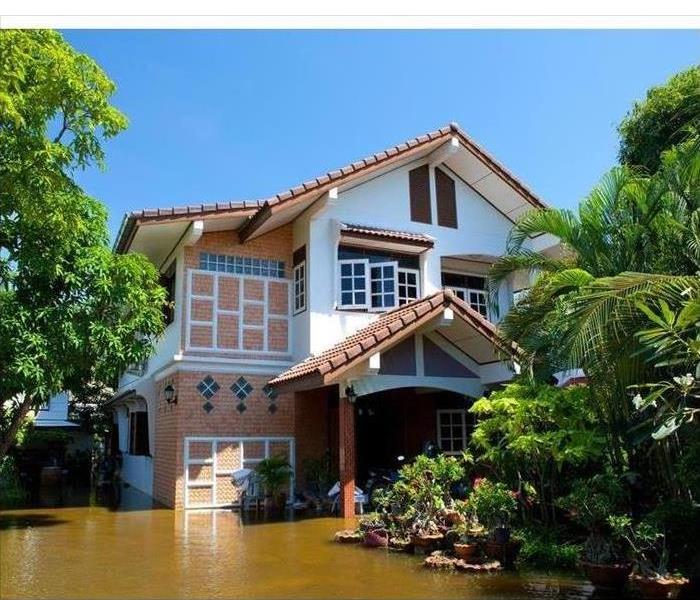 Flood damage in a New Briton, PA home
Flood damage in a New Briton, PA home
Three Tips To Help You Remove Odors From Your Home After a Flood
A home that has been flooded may retain lingering odors long after the physical damage to the property has been repaired. This musty smell is often caused by mold growth but may be caused by sewage loss or other issues. These three tips will help you remove odors from your home after a flood.
1. Throw Out Items Made From Porous Materials
Flood water can seep into porous materials, such as the fabric of upholstered furniture, causing mold and bacteria to grow. It is difficult to completely dry out and clean items such as upholstery, carpet pads, and mattresses, so it is best to discard them. However, you may want to check with your insurance company before you make any final decisions on what to keep and what to salvage.
2. Remove Mold
Mold growth is one of the most common sources of musty odors after a flood. This is because mold flourishes in the sort of dark, damp conditions that exist in most flooded homes. Mold can grow on any surface of your home, including furniture, clothing, cabinets, carpets, walls, and curtains. Even your children's stuffed toys can be a fertile breeding ground. Widespread mold is difficult to eliminate without the proper equipment and training. A professional mold remediation company in New Briton, PA, can assist you with the mold removal process.
3. Clean Your Contents
If you attempted to wash and dry your water damaged contents yourself, you may have some items that look clean, but harbor mold and bacteria that is causing your odor problem. You can try cleaning them again with an anti-bacterial cleanser, but you may have more success by utilizing a professional content cleaning service. Make sure you thoroughly dry anything you clean before you bring it back in the house.
Lingering odors due to mold growth or bacteria can be an extremely frustrating consequence of flood damage. These three tips can help you remove unpleasant odors from your home.
How To Prepare Your Business for a Severe Snow Storm
12/26/2020 (Permalink)
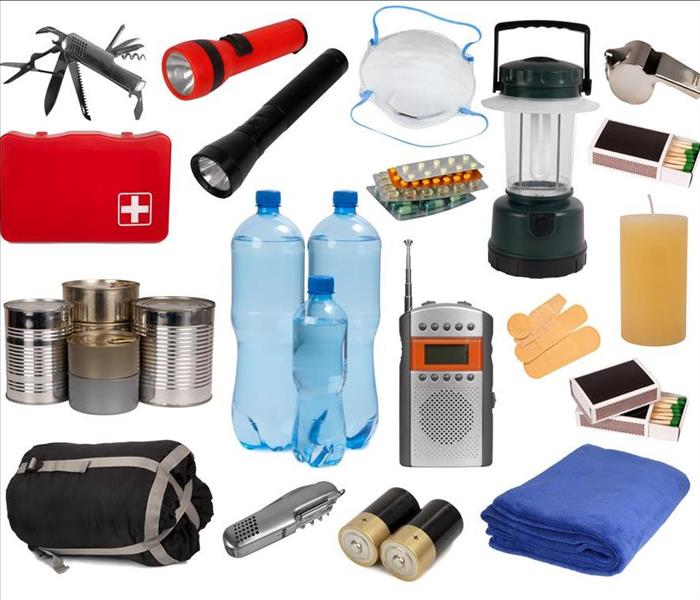 Create an emergency kit for you and your employees
Create an emergency kit for you and your employees
Here Are Some Steps To Make Sure You're Ready For The Worst
When a severe snowstorm is predicted to hit your business in Chalfont, PA, it's important to make sure you and your organization are prepared for the worst. After all, it's better to be over-prepared than under in case there is an emergency. Here are some steps to take to make sure you're ready for the worst.
1. Secure Your Building
It's important to make sure that your building is ready for the extreme cold by sealing windows and doors with caulk and weather stripping. You should also insulate your pipes and drain any exterior ones to avoid a pipe burst. Have a generator ready and inspect your carbon monoxide detectors so that you know they'll alert you if something goes wrong with your heater or generator.
2. Create an Emergency Kit
Snowstorms can knock out power lines and shut down roads, so it's important to be ready to be stuck inside your building without power. Stock up on nonperishable snacks, bottled water, flashlights and batteries, and extra blankets for you and your employees. You should also make sure your gas tank is full and you have jumper cables, a warm coat, and boots, and gloves in your car in case you need to drive in the storm.
3. Watch the News
As a snowstorm is approaching, make sure you're watching the news carefully. It might be in you and your employees' best interest to have everyone go home early or work from home if the storm is bad enough. Tell everyone to take their work equipment home the night before the storm just in case, and then alert them of your decision before they begin their commutes so that they don't have to go out unnecessarily.
It's important that you protect both your business's building and employees when a severe snowstorm is approaching. Even if it is much milder than anticipated, it's better that you were prepared for the worst than to be caught by surprise and have to pay for storm damage restoration or put your employees in danger.
Will Insurance Cover a Broken Pipe?
12/26/2020 (Permalink)
 Homeowners' insurance often covers repairs for water damage caused by unexpected, sudden occurrences
Homeowners' insurance often covers repairs for water damage caused by unexpected, sudden occurrences
Will Insurance Cover a Broken Pipe?
A flood is sudden and almost impossible to prepare for. Cleaning up after suffering water damage can be a costly burden you were not expecting. Thankfully, homeowners insurance often covers such damage, depending on how it occurred.
1. Covered Occurrences
Damage caused by broken pipes, or sudden collapse, are generally covered by insurance. Leaks from malfunctioning washing machines or refrigerators are also included. Plumbing is considered part of general home maintenance. When your pipes and appliances break and cause damage despite normal upkeep, insurance can provide relief as you recover and clean up the mess.
2. What Is Covered
Insurance covers damage to your floor, floor coverings, walls, drywall, furniture, and belongings. Professional water damage cleanup services required to restore your home are also included in coverage. As well as services needed to achieve prompt drying of everything affected by the flood in order to prevent mold growth. Although the specifics of what is covered under every policy varies, the purpose of insurance is to help you restore your home when disaster strikes.
3. What Is Not Covered
Damages caused by gradual leaking over an extended period of time are generally not covered by insurance. Problems caused by wear and tear from regular use are also typically excluded from insurance coverage. The homeowner is responsible for keeping plumbing working properly and fixing issues as they occur. When damage happens despite these efforts, insurance may help. However, if you allow problems to fester over time so that they cause damage, you hold responsibility. While insurance does help with cleanup and restoration after leaks, insurance will often not pay to actually fix a broken pipe. It only pays for the damage caused.
Homeowners' insurance often covers repairs for water damage caused by unexpected, sudden occurrences. If you experience damage due to a leaking pipe, a flood, or a malfunctioning appliance, check with your insurance provider in Buckingham, PA, to see if you are covered.
3 Ways Rain Can Lead to a Mold Problem
12/26/2020 (Permalink)
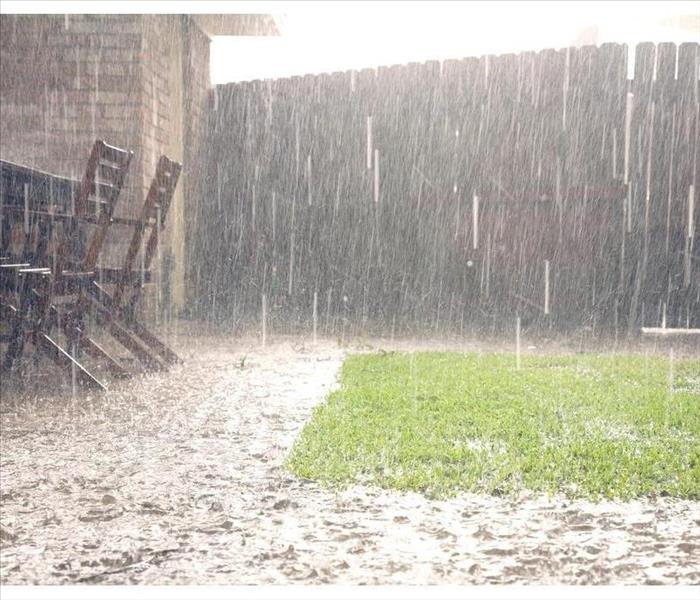 Heavy rains can lead to mold growth in your home
Heavy rains can lead to mold growth in your home
3 Ways Rain Can Lead to a Mold Problem
All kinds of mold, including black mold, depend on moisture to grow. When it rains in New Briton, PA, your home becomes exposed to moisture. Normally, this is not a problem, since houses are designed to exclude moisture very effectively. When parts of your home are improperly maintained, however, moisture can infiltrate your home and cause a mold infestation.
1. Leaking Roofing
Deteriorating roofing is often responsible for water infiltrating residential buildings. Mold that develops as a result can spread from an attic to the rest of your house if not properly stemmed. While it may seem like thoroughly cleaning the surface of your roof is enough to prevent further leaks, this is often not the case. Roofing is a critical element of your home that needs to be fixed in order to avoid a moisture problem.
2. Leaking Drainage
Water vessels from outside can lead to black mold and other molds entering your home. Make sure to carefully inspect all of your drainage systems in order to ensure that no water is leaking in through cracks, drill holes, or contacting surfaces. If you do find a serious leak that has already caused water damage, it may be necessary to tear out and replace damaged surfaces.
3. Flooding
Severe weather events often lead to flooding that goes unnoticed by homeowners. During a storm, you should always check low areas in your home to see if water has seeped in. Make sure that your sump pump is working properly by testing it regularly. Basement flooding that goes undetected can lead to large-scale mold cleanup, so you should take preventative measures ahead of time.
News stories about black mold may have you concerned for your home and family. In truth, removing a mold infestation is possible after even the most serious weather events your family is likely to face. If you require a cleanup, contact a mold restoration company who will be able to deal with an infestation efficiently and safely.
How To Minimize Mold Exposure
12/14/2020 (Permalink)
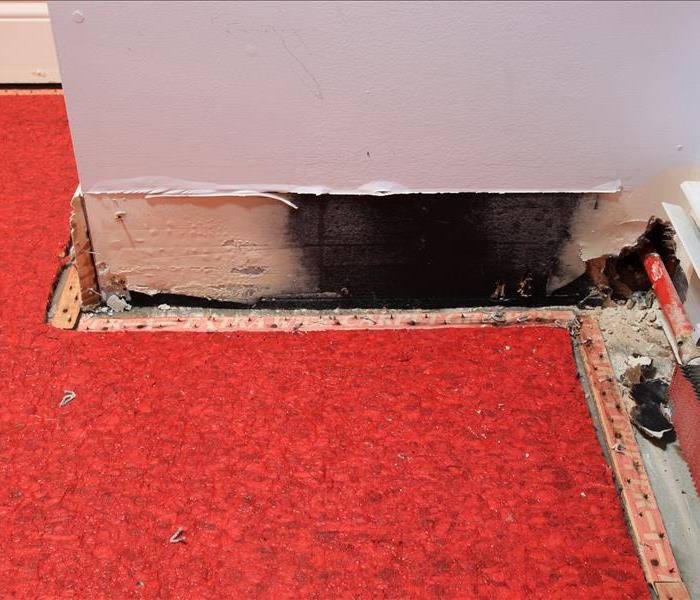 Black mold damage in Doylestown, PA
Black mold damage in Doylestown, PA
As Soon As Anything Is Spotted, Complete The Following Three Steps
Discovering black mold on the property doesn't mean that the place is a total loss. Commercial owners in Doylestown, PA, can work to minimize the hazard, particularly if swift action is taken. By implementing certain actions, the spores may be limited to an area, permitting faster and more efficient cleanup.
1. Locate a Specialist Quickly
Infestations can be much deeper than surface level. The microscopic organisms penetrate porous objects. Surface level observations could miss a concern. For a thorough understanding of the trouble, contact a mold cleanup company to evaluate the room. They can pinpoint how much should be treated. If something is left unattended, then the first cleaning is useless. The mold can simply regrow, causing future problems.
2. Cut Off the Water Supply
Fungus requires certain properties to reproduce. When the spores interact with fluid and organic material, they have the perfect combination to foster additional black mold. It's essential, then, to eliminate the food source, turning off the water. If a pipe burst occurs, shut off the main valve. Leaks in the ceiling should be patched and fixed as soon as possible.
Strive for dry space. Any excess should be wiped up. Run dehumidifiers to extract humidity from the air, walls, and flooring. Tear out drenched structures. It's better to dispose of them and replace them with something new.
3. Establish a Containment Barrier
With the moisture problem under control, begin to secure the premises. Limit movement in and out of the affected zone. Spores can be moved through your own footsteps and clothing. The specialists should block off the room. In addition, shutting off the air circulation is important in keeping other sections from having issues. The ducts should be examined and scrubbed.
Black mold is a serious matter. Don't try to tend to it yourself. Use the help of professionals to mitigate the circumstances.
4 Steps to Take When Your Pipes Burst
12/14/2020 (Permalink)
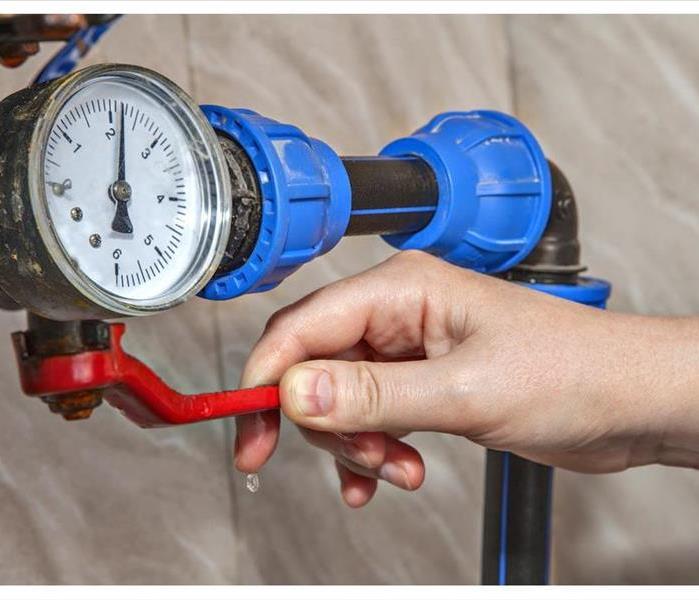 Find the main valve and turn it off
Find the main valve and turn it off
4 Steps to Take When Your Pipes Burst
If your business in Doylestown, PA, is located in a cold-weather region, you probably know that extreme temperatures in winter can lead to water damage, especially from frozen, bursting pipes. However, pipes can also burst in warm weather due to clogs, corrosion or even from tree roots growing through the pipe walls. Discovering you have water spraying or flooding everywhere can wreak havoc with your nerves, but don't panic - here's what to do:
1. Shut Off the Water
Find the main valve and turn it off. When water freezes, it expands and creates pressure that can weaken and crack the pipes, and there may be multiple areas affected. Once you have it shut off, it’s a good idea to turn off the electricity as well, so you don’t have an even bigger problem on your hands.
2. Call a Plumber
You will need someone to replace or fix the broken pipe before you can turn the water back on again. Unless you have expertise handling these kinds of emergencies, it’s best to call in a professional who deals with bursting pipes all the time. He or she can properly assess the cracks and recommend how to proceed so you can avoid further damage to your property.
3. Contact a Water Remediation Service
If you have any significant flooding, you’ll need help from the experts. Remediation is the process of extracting the water, cleaning, sanitizing and thoroughly drying the area, as well as repairing any structural damage.
4. Call Your Insurance Company
Unless your flood occurred as a result of neglect, your insurance should cover the expense of repairs and cleaning, along with any loss of equipment or supplies. Your agent will lead you through the process of filing a claim and be able to answer any questions you might have.
Bursting pipes can’t always be avoided, but if you’ve suffered commercial water damage, there are many resources to help you get back in business as soon as possible.
How To Use A Fire Extinguisher?
12/14/2020 (Permalink)
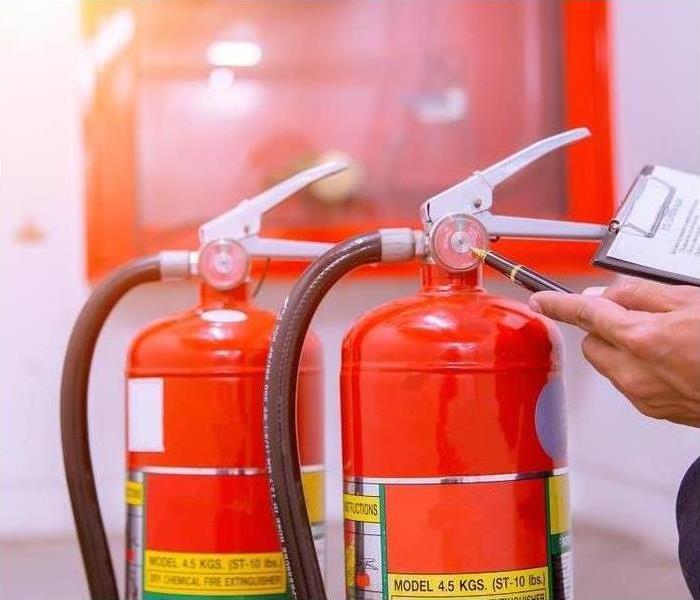 Everyone in a household should know how to use a fire extinguisher
Everyone in a household should know how to use a fire extinguisher
How To Use A Fire Extinguisher?
One of the things everyone in a household should know is how to use a fire extinguisher. Hopefully, you will never have to use this knowledge, but the proper application of a fire suppression device can prevent a lot of heartache later on.
Step 1: Decide What's Best
Your first decision should always be whether you should try to use an extinguisher or get safely out of the home. If the fire is very small and unlikely to spread, use it. If the fire is spreading rapidly, get to safety. Never try to extinguish a fire that is completely out of control. Suffering fire damage is much better than getting hurt.
Step 2: Check the Type
Get the right type of extinguisher. If you have a fire extinguisher in your home, chances are you have one for common house fires. Common extinguisher types include:
- Type A - wood, paper, rubber, cloth, and plastic
- Type B - gasoline, paints, and solvents
- Type C - electrical fires
- Types D and K - industrial chemicals and oils like those used in businesses or restaurants
Most household devices are labeled A, B, and C. If you don't remember the types, just make sure yours is a multi-use extinguisher. This step is particularly important in a kitchen fire because some types will not put out a grease fire.
Step 3: Use the PASS Method
The PASS method stands for pull the pin on the fire extinguisher. Then aim the nozzle and squeeze the handle. The final step in PASS is to sweep the spray from side to side. If your instruction manual says something different, always follow the instructions that came with your extinguisher.
Step 4: Clean Up the Mess
Even if you use fire suppression devices, you will still have smoke and some fire damage. In this case, you are best off calling a company that specializes in fire cleanup in Doylestown, PA.
No matter what, it is always better to call the fire department than it is to get hurt. Never try to put out a fire that is spreading fast or seems out of control.
How Fire Damage Is Estimated
11/4/2020 (Permalink)
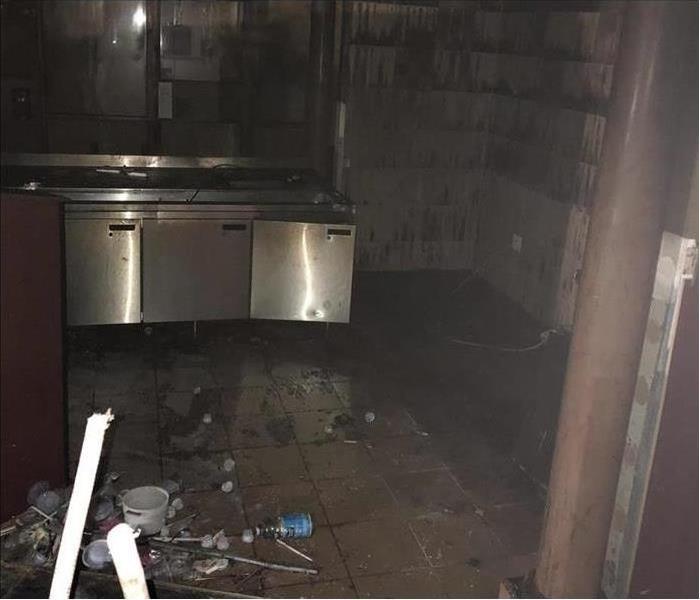 Kitchen fire damage in New Briton, PA
Kitchen fire damage in New Briton, PA
How Fire Damage Is Estimated
After your commercial property in New Briton, PA, suffers a fire, you need to find a fire restoration company that can help restore your structure to safe conditions. A fire damage estimate involves more than simply items and property damaged in the fire. Here are some of the additional services considered in that figure.
1. Emergency Adjustments
If there is water damage from the fire department putting out the fire, all water will be removed before your building is sealed up. Any missing pieces of the roof will be covered with a temporary tarp. Windows, doors, and damaged walls will be boarded up. Closing up the structure prevents theft and any additional damage from the weather.
2. Cleaning
Once your structure is protected from intrusion, the property will be assessed for fire and water damage. The estimate will include all cleaning, deodorizing and packing needed in order to start rebuilding. It will include all chemicals and products needed to perform the removal of odors from smoke and fire. The physical removal of hazardous debris is an essential piece of the process.
3. Reconstruction
After cleaning comes rebuilding. All damage will be assessed to determine what can be repaired and what will need to be rebuilt. Removing and storing furniture and other salvageable items so that reconstruction can safely occur is part of the process. Anything that has been damaged beyond repair will be rebuilt to restore your property to safe conditions.
Make sure any estimate you are given after a commercial fire includes all aspects listed above so that you are not surprised by additional charges later. Check with your insurance to see if you are covered for fire damage. A good fire restoration company will work with you or your insurance adjuster throughout the process to make sure that you have a full inventory of all damage and reconstruction required so that you may file a timely insurance claim.
What To Do After a Pipe Breaks
11/4/2020 (Permalink)
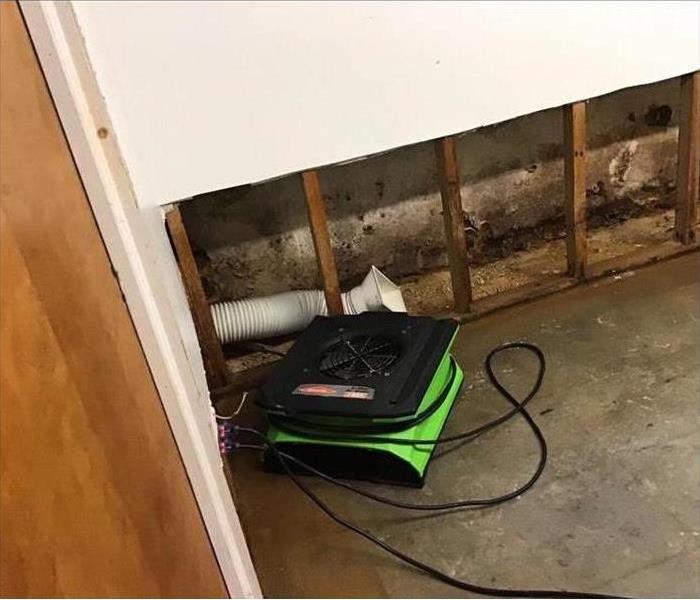 Commercial water damage in Doylestown, PA
Commercial water damage in Doylestown, PA
Consider The Following Steps To Lessen The Damages
Pipes that freeze due to inadequate insulation or poor placement frequently burst and cause havoc. Thankfully, most insurance companies do cover damages caused by bursting pipes. Check with your insurance to see if your business in Doylestown, PA, is covered. If you do ever suffer a burst pipe, there are steps to take to help lessen the damages.
1. Shut Off Water and Electricity
Whenever you encounter any type of catastrophic leak or flooding, shut off the water supply as soon as possible to stop the flow of water. Knowing where your water shut off valve is ahead of time is a good idea. It's not something you want to frantically hunt for in the midst of a flood. You should also shut off the electricity in any part of the building where flooding has occurred.
2. Call a Plumber
Once you've cut off the water and electricity, immediately call a plumber. Bursting pipes due to cold weather are common, and plumbers are often inundated with calls during winter storms. Do not delay in contacting a plumber. Plumbers are specially trained and equipped to safely and reliably fix broken pipes. Plan ahead and research plumbers, electricians, and other tradesmen available in your area who can help in an emergency before you actually need them.
3. Start Cleanup
After a plumber has been contacted and scheduled, begin removing the excess water. Use mops, buckets, towels, and anything you have available to dry the area. Repairing water damage can become costly and complicated. If water is not removed quickly, mold and mildew become a threat. An expedient cleanup aided by a restoration specialist after water damage helps to lessen the occurrence of mold growth and keeps total damages low.
Bursting pipes are caused when water freezes and expands. Weak pipes that are poorly insulated are most susceptible to this problem. Pay attention to your water flow in colder months and act quickly if you suspect that your pipes might be frozen.
How To Turn Yard Depressions Into Storm Runoff Solutions
10/20/2020 (Permalink)
 Build a rain garden
Build a rain garden
Do You Have Low Spots In Your Yard That Build Up Water and Cause Flooding After Every Rain Storm?
Are you worried about what kind of damage all of that water could cause? Before you back in a load of topsoil and start leveling, consider these two options for making troublesome lawn depressions into outside flooding solutions with curb appeal.
Build a Rain Garden
One answer to that annoying swamp in your front lawn is to make it a permanent part of the landscaping. Filled with plants that do well in regions with heavy precipitation, rain gardens not only allow water to absorb into the ground slowly but filter the water, too. According to This Old House, a well-built rain garden has three plant zones:
Bottom zone – plants that can handle standing water for long periods of time
Middle zone – plants with moderate water tolerance
Top zone – plants that prefer mostly dry soil
There are many plant species, such as ferns and wildflowers, that do well in rain gardens. By doing your research and selecting the right plants, you can create a beautiful water basin to help with outside flooding.
Carve Out a Swale
Once your rain garden is built, you can utilize a well-placed swale, sometimes called a ditch, to redirect excess rain drainage away from your home and into the flower bed. A swale will also slow runoff and allow it to seep into the ground. Lining swales with stones to form a “bed” for water to flow over makes water dispersal even better, and planting shrubs along the sides will help absorb water, too. Some swales are small projects and can be done by homeowners, but bigger projects might need a professional to ensure runoff gets where it needs to go.
Creating a cohesive landscape that works to slow outside flooding will help you get through storm season in Buckingham, PA, without making too many calls to your local storm damage company.
Top 5 FAQs About Mold
10/6/2020 (Permalink)
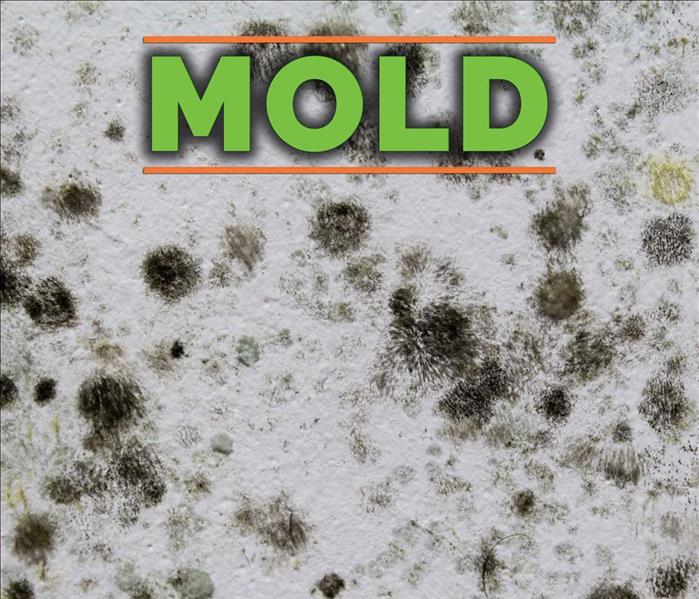 Stachybotrys chartarum is one of the most common types of residential mold
Stachybotrys chartarum is one of the most common types of residential mold
Study The Following Frequently Asked Questions
Mold growth is an extremely common issue that many homeowners do have to face at some point. Attempting to solve a mold issue can be daunting, especially for first-time homeowners. Study the following frequently asked questions if your home in Doylestown, PA, has fallen victim to a black mold problem.
1. What is Black Mold?
Stachybotrys chartarum is one of the most common types of residential mold. Much like the name implies, it's typically black or dark green in color and looks like a dark stain spreading across the surface of the affected area.
2. What Causes Mold Growth?
Mold needs moisture in order to thrive. Water damage, flooding, excessive moisture, and other water-related issues are common causes. You're also likely to find mold growing on spoiled food items in your fridge or pantry.
3. Where Does Mold Usually Grow?
You're most likely to find mold growing in your bathroom, kitchen, laundry room, basement, or any other areas of your house that come into frequent contact with water.
4. Does Mold Go Away By Itself?
Mold is a living organism so it's natural to assume that you could kill it by depriving it of its vital nutrients. Unfortunately, this isn't the case. Cutting off the mold's access to moisture and organic matter could potentially prevent it from spreading, but only temporarily. It won't actually kill the mold.
5. How Do You Get Rid of Mold?
Larger issues do require assistance from mold remediation experts. If your problem is smaller, you can tackle the issue by creating a non-toxic mold cleanup solution using equal parts water and white vinegar. Scrub the affected areas with a kitchen scrub brush dipped in this solution.
Black mold is tenacious, so you have to be tough when attempting to tackle the issue. Failure to resolve the problem quickly and correctly can only result in subsequent mold damage. The only way to be absolutely certain that your mold problem has been taken care of is to contact mold remediation experts.
5 Steps To Handling a Leak in Your Kitchen
10/6/2020 (Permalink)
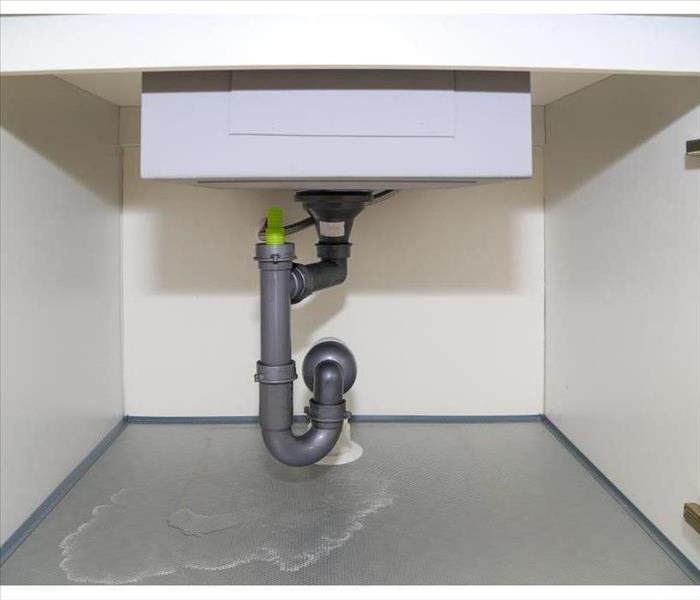 Leak under kitchen sink
Leak under kitchen sink
Dealing with a leak under your kitchen sink can be a huge hassle, and it is important to handle the problem as soon as you discover it. A leak in your kitchen can lead to flooding and water damage, and knowing what to do when you spot one can help you prevent unnecessary damage and repair costs in Chalfont, PA.
Here Are 5 Steps To Follow If You Find a Kitchen Sink Leak
1. Shut Off the Water
If you have identified a leak under your sink, turn off the main water valve immediately to stop the leak and prevent any additional flooding from the pipes.
2. Remove Excess Water
It is important to remove any excess water in your home to prevent water damage and mold. You can remove water by mopping or blotting with a towel, but do not use a vacuum cleaner. Calling a professional cleanup service is recommended for major leaks.
3. Remove Valuables
Move any valuable items and non-waterproof belongings from your floor and transfer them to a safe place to avoid additional damage. Keep electronics turned off and remove them if they are at risk of coming into contact with any water.
4. Call Your Insurance Provider
Find out what your insurance policy will cover before you begin your kitchen repair. Homeowners' policies often cover losses from frozen or broken pipes, including the cost to repair the pipes and any personal belongings that are water-damaged beyond repair.
5. Call a Professional
A professional water cleanup and restoration services company will ensure that your kitchen leak is fixed quickly and properly. They have professional equipment to dry and dehumidify your home, clean and sanitize your space, and restore your kitchen to its pre-damaged condition.
A leak under your kitchen sink can be a huge headache to deal with, and taking swift action is crucial to minimizing water damage and excess flooding. Shutting off the water, removing your valuables, and enlisting the help of professionals will ensure that you return your home to good operating condition as quickly as possible.
How Often Should I Clean My Furnace?
9/25/2020 (Permalink)
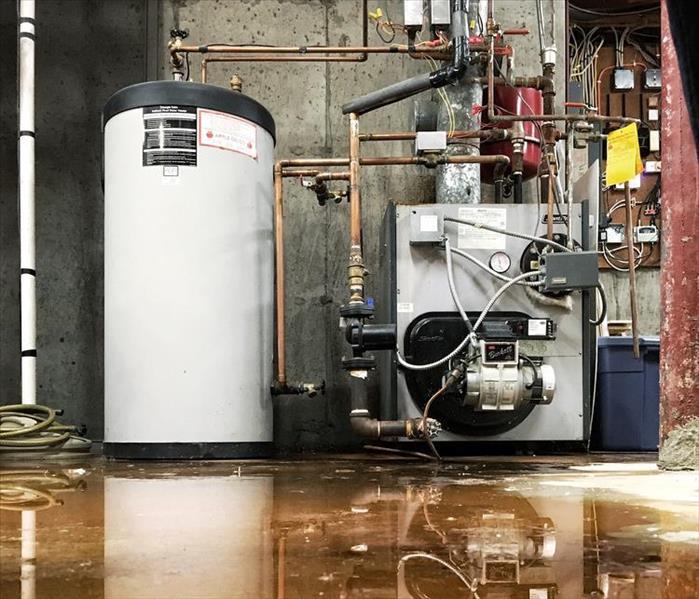 Keep your furnace clean and maintained to avoid any flood
Keep your furnace clean and maintained to avoid any flood
Like any system with moving parts, furnaces need maintenance. Those that are maintained will run smoothly and rarely need repair. Regular maintenance is not hard to do, so keeping up with a cleaning schedule should be fairly easy. To avoid unnecessary risk of damage or fire, cleaning the unit should happen on a schedule, allowing for a warm, comfortable environment in New Briton, PA, for many years.
There are Four Main Types of Furnaces:
- Electric
- Natural gas
- Oil
- Propane
When is the best time to clean a furnace?
At the beginning of the Season
Dirt is the enemy of a heating system. A neglected system can be overloaded, so to avoid compromised airflow and the risk of fire, cleaning the unit is essential. The filter, blower, and blower motor are the critical areas to keep clean. If the homeowner is not familiar with disassembling the unit, a professional HVAC service can help. The filter should be changed at the start of cooler weather before the furnace runs on a regular basis.
Once a Month During Continuous Use
The filter traps dirt, dust, pet hair, and tobacco smoke, cleaning the air before it enters the unit. Pets, children, and tobacco smokers influence how often the filter will need changing. Remove the filter and inspect it in the light. If it appears very dirty or clogged, replace it.
At the End of the Season
As the season changes to warmer weather, look over the unit's critical areas. See if continuous use has caused any dirt to settle inside. Change the filter.
While there is a low risk of a furnace causing a fire, cleaning and inspecting the system on a regular basis will help prevent a dangerous situation. If the unexpected happens and there is a fire around or near the unit, file a claim with your insurance company and ask for authorization of a fire remediation company. A furnace unit that has been inspected and maintained will give homeowners comfort during many cold-weather seasons in New Briton, PA.
4 Ways To Protect Your Building Against Flood Damage
9/14/2020 (Permalink)
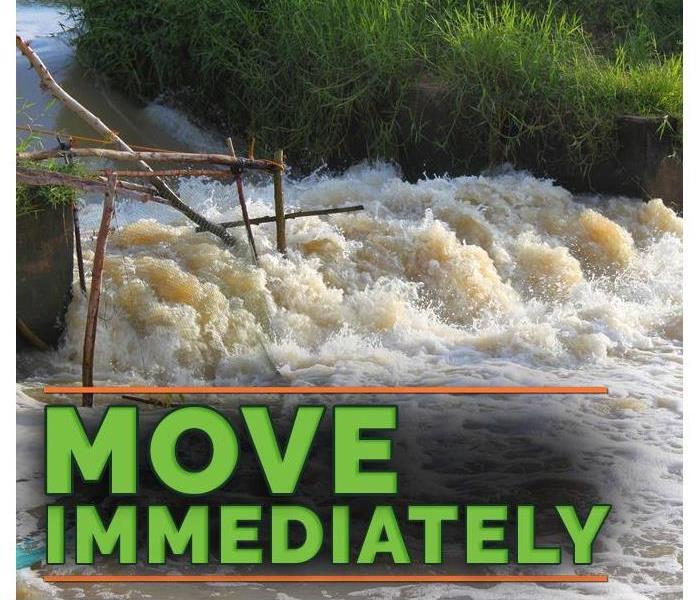 If there is a chance of flash flooding, move immediately to higher ground.
If there is a chance of flash flooding, move immediately to higher ground.
Four Ways To Protect Your Building
Some businesses operate in designated flood zones, but even if you do not, there is always the possibility of flood damage. The key to limiting the extent of the damage is to understand how to prevent it in the first place. While a storm remediation professional in Buckingham, PA, may have a more extensive list of suggestions, the following four ways to protect your building is an excellent place to start.
1. Elevate Items Above Flood Levels
The primary objective of protecting your business from storm damage is to be aware of the possibility of an impending flood. Most forecasters will offer suggestions of flood depth and likelihood. If you know how deep a flood may be, then make sure to raise all sensitive equipment and files above that threshold. If your company has a second floor or attic space, consider temporarily moving items to these locations.
2. Build Temporary or Permanent Barriers
Another excellent way to avoid flood damage is to construct temporary barriers out of earthen materials, like sand or soil. Piling bags of sand is a common tactic against rising waters. Again, make sure that the barrier you create is higher than the projected flood levels. Some companies may also find it beneficial to build permanent walls, using landscaping or humanmade materials to defend against the possibility of a flood.
3. Install Flood-Proofing Equipment
Sometimes, the greatest defense against flooding, especially minor floods, is the use of flood-proofing equipment, like sup pumps and backflow valves. Installing plumbing equipment can ensure your facility stays dry, but you may want to consult with a plumbing professional to discuss the most beneficial options.
4. Move or Build Elsewhere
While not a viable option for every business, moving to higher ground or building in a dryer climate are the best options for protecting your company against possible floods. You can review flood zone maps to find the locations to avoid.
No business owner wants to deal with flood damage. Contact a local mitigation company to discuss preventative options.
Finding Hidden Mold
9/2/2020 (Permalink)
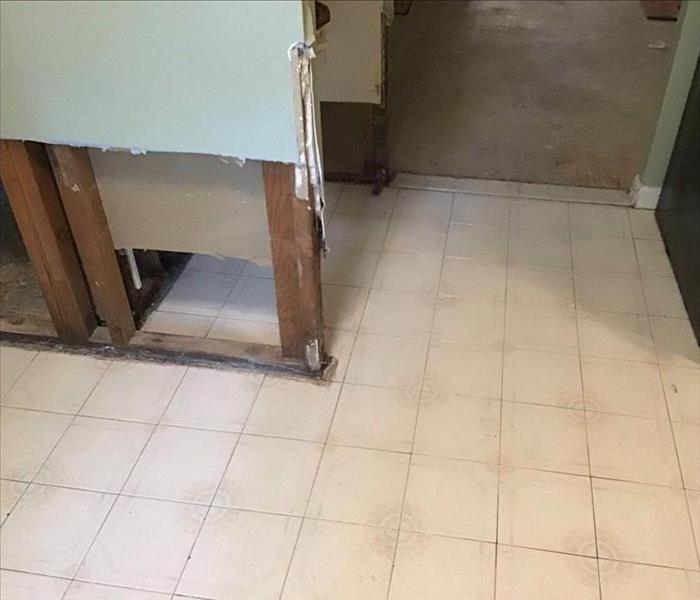 Dealing with mold can be an ongoing issue, especially if the source can’t be found.
Dealing with mold can be an ongoing issue, especially if the source can’t be found.
When you enter your Doylestown, PA, home and there is a musty odor, it means you have mold growth. Unfortunately, unless there has been known water damage, that fungi colony could be steadily growing out of sight. Along with checking known areas for dampness, seeking the help of an indoor environmental specialist can help you locate the problem and its source.
Signs of Hidden Damage
Along with the odor, there are some known areas for mold to lurk. Check walls and ceilings for cracks, soft spots, or signs of water damage. Also, inspect the following areas:
Behind the refrigerator
Under stacked newspapers or cardboard
Below sinks and faucets and around pipes
Wallboard around windows
Ventilation ducts
Carpet or rugs that have been wet
Nonvisible side of ceiling tiles
Drywall between studs or areas that have been flooded
If you find mold in any of these areas, it’s time to call mold remediation and restoration professional to return your home to normal. If you still can’t find the source of the odor, consider having a mold test done.
Testing for Mold
A professional indoor environmental specialist has an array of tools to locate hidden mold and water damage and different tests to its presence. These include:
Air Testing – Air samples are taken to test mold spore concentration, which can help determine the extent of the hidden problem.
Surface Testing – Samples from various surfaces are taken to test for spore deposits and growth. This can help pinpoint areas with a higher concentration.
Bulk Testing – This test involves taking materials from the home to be examined at a lab. This method can tell the concentration of particles.
Culture Tests – To determine the species of mold, particle samples are allowed to grow in the lab.
Dealing with mold can be an ongoing issue, especially if the source can’t be found. An indoor environmental specialist has the latest tools to conduct tests and assessments to help get your home back to normal.
What To Expect From the Professional Mold Elimination Process
8/21/2020 (Permalink)
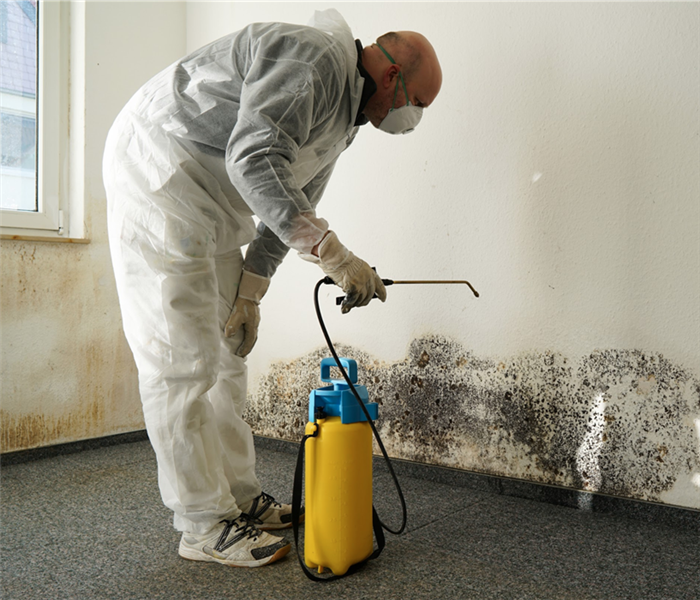 Mold remediation in Chalfont, PA
Mold remediation in Chalfont, PA
Five Steps To Make Sure Mold Is Completely Removed
Have you discovered black mold in your Chalfont, PA, commercial building? It could be just the tip of the iceberg. A small mold problem can get out of hand fast, so it’s best to hire professional help when it comes to mold remediation. Experts take the following five steps to make sure the mold is completely removed and stays away for good.
1. Locate
First, the source of the moisture must be discovered. If the moisture is limited to a certain area (e.g., under a sink), that’s probably the extent of the growth. Faucets, fixtures and exposed plumbing are checked for leaks and/or water damage.
2. Protect
Personal protective equipment is important for personal safety and to keep cross-contamination at bay. A respirator made specifically for mold remediation is crucial. Also, ventless safety goggles and disposable gloves and shoe covers will be worn. Clothing should completely cover the skin.
3. Contain
Next, the area needs to be contained to prevent cross-contamination. Anything that moves the air (e.g, air conditioning and fans) has to be turned off and windows and doors closed. The smallest draft can send black mold spores flying through the air. Doorways often are sealed with plastic sheeting and painter’s tape. All vents should be sealed in the same fashion so that mold spores can’t make their way into the ductwork.
4. Eliminate
The professionals will then begin the mold elimination process. Industrial-grade equipment and cleaners are used to remove the infestation; different techniques are employed to clean different areas and surfaces.
5. Clean
Mold-infested materials must be carefully removed from the affected area to avoid cross-contamination. Finally, the whole area is thoroughly cleaned before opening doorways and unsealing vents or running fans.
You can feel confident that all of the black mold is eliminated from your building when you hire mold cleanup experts. They can return your property to its pre-mold condition as quickly as possible.
Drying Out Your Commercial Building After a Flood: 3 Tips
8/21/2020 (Permalink)
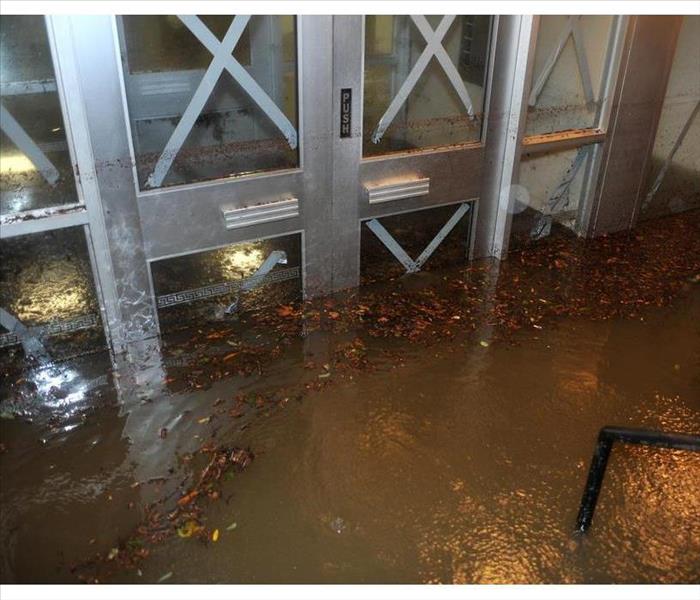 Flood damage in New Briton, PA
Flood damage in New Briton, PA
Damage Tips To Keep In Mind As You Restore Your Business
Flood damage to your New Briton, PA, business can be unexpected and affect you in a variety of ways. From rooms filled with standing water to ruined building materials, you may not know where to begin when it comes to effective cleanup. Ensuring that each area is completely dry after a flood can prevent secondary damage, such as mold growth, and there are a few damage tips you can keep in mind as you work to restore your business.
1. Decrease Humidity
If a pipe burst and caused flooding in your building, the standing water can create humid conditions that may cause mold to develop on walls and ceilings. Reducing the humidity in affected areas may lower the risk, and there are several ways you can accomplish this. First, turn off your building’s air conditioner and open windows to allow humidity to escape. You can then use ceiling and floor fans to keep air circulating until help arrives.
2. Move Items To Dry Areas
When it comes to cleaning tips, removing important items to higher ground may seem obvious, but you may not think about it in the aftermath of a flood, especially when the damage seems extreme. If it is safe to enter a flooded area, salvage sodden documents, furniture, and other important items and allow them to dry. You may want to freeze wet papers until you can contact a restoration service.
3. Call in a Water Damage Service
Some types of floodwaters, such as those caused by a clogged toilet or sewer backup, may contain toxins and solid waste that could harm you. Calling in a flood mitigation and cleanup service can help you recover from this type of issue, as flooding technicians might be able to provide you with additional damage tips as they work to dry and restore your building.
When flooding affects your New Briton, PA, business, beginning the drying process can seem daunting. However, learning a few water damage tips may give you the confidence to proceed.
Top 5 FAQs About Flood Insurance
8/19/2020 (Permalink)
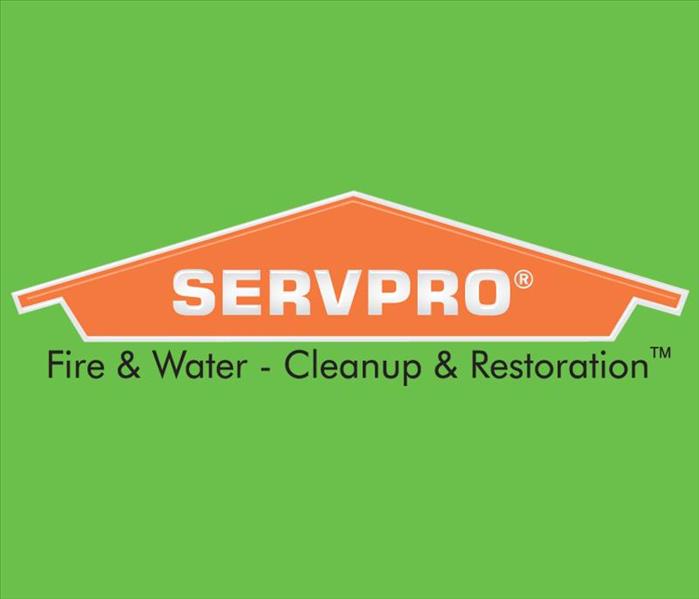 Water damage can quickly cause subsequent issues if it's not resolved quickly.
Water damage can quickly cause subsequent issues if it's not resolved quickly.
Preparation is key when it comes to protecting your commercial business from natural disasters, such as floods, heavy rain, and high winds. There's no telling when or where a flood could occur, so the best way to make sure you're protected is to purchase flood insurance. Study the following frequently asked questions regarding commercial insurance to help keep your building in Doylestown, PA, safe.
1. Is Flood Coverage Mandatory?
All commercial business owners are required to purchase a separate insurance policy if their building is located in a high-risk flood area. This is especially so if you have a mortgage from an insured or federally regulated lender.
2. What Does The Insurance Policy Cover?
Your policy protects you from flood damage to your building and the property within it. The cause of the flood typically doesn't matter; it can be from heavy rains, overflowed rivers, snowmelt, blocked drainage systems, or anything else. In order to be considered a flood, however, the water must affect at least two different properties or cover two total acres.
3. Does Flood Coverage Protect You Right Away?
Flood insurance typically has about a 30-day waiting period before it comes into effect. It's best that you obtain a policy as soon as you can so you're protected.
4. How Much Money Does Your Policy Give You?
Commercial insurance policies against floods normally can grant you about $500,000 to cover the building itself, along with an additional $500,000 for the building's contents.
5. Is Mold Covered in the Flood Policy?
Flood coverage policies only insure against mold growth if it was a result of the flood itself. Because of this, mold coverage is typically a case-by-case basis. Any mold that was there before the flood is not covered.
Water damage can quickly cause subsequent issues if it's not resolved quickly and obtaining a flood insurance policy can help keep your business afloat in the event of a disaster. Contact your local storm remediation experts for more information regarding commercial insurance and other flood coverage policies.
Maintaining a Sump Pump
8/11/2020 (Permalink)
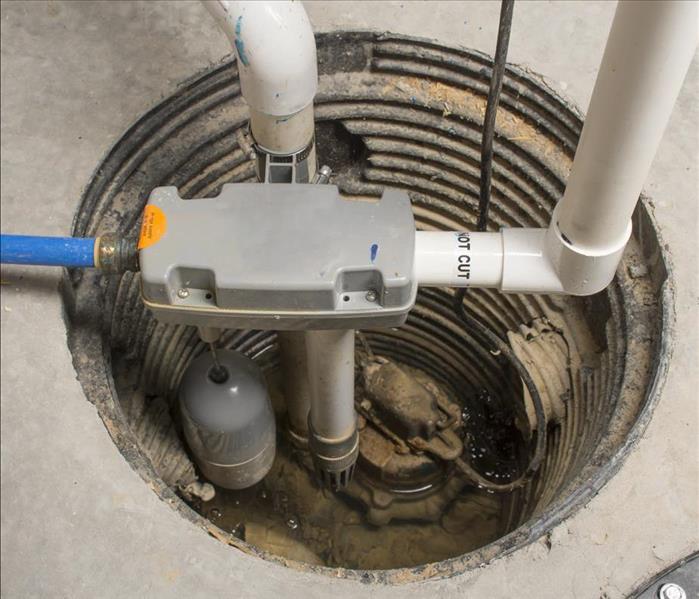 A sump pump can be a great way to get rid of excess water during heavy rains and flooding
A sump pump can be a great way to get rid of excess water during heavy rains and flooding
Pump Maintenance
Many people install a sump pump if they live in an area with high water tables, such as New Briton, PA, have poorly draining soil, or have cracks in their home's foundation. Additionally, many homeowners who live in high-risk flood zones install these pumps in preparation for any flooding. These machines will spit any excess that enters your basement out into your yard and prevent you from having to worry about the costs of flood damage and cleanup. Because they have such unusual operating schedules, it is necessary to perform regular pump maintenance to keep your appliance working at peak performance.
Every 3-4 Months
It is a good idea to run through a simple series of tests every three or four months to make sure that your pump is still operating at its best. The tasks you should perform include:
- Cleaning the pump inlet screen
- Checking the power cord for nicks or kinks
- Testing the outlet to make sure the pump has electricity
- Dumping a bucket of water to raise the float and make sure the pump drains properly
Every Year
Once per year, you should perform a more thorough examination of your machine. Begin by removing your pump from where it has been submerged. Thoroughly clean both the machine and the hole in which it was submerged. While you have the pump out, check the owner's manual to see if you should grease or oil the bearings. If so, follow the instructions in the manual to complete this task properly. When you have finished, put the pump back into the hole where it normally sits. Since you are already working on your sump pump, this may be a good time to perform your regular tests to make sure the pump still works properly.
A sump pump can be a great way to get rid of excess water during heavy rains and flooding. However, it is important to perform regular checks and maintenance to ensure that your machine keeps working at peak performance.
Can a Fire Sprinkler Activate Accidentally?
8/5/2020 (Permalink)
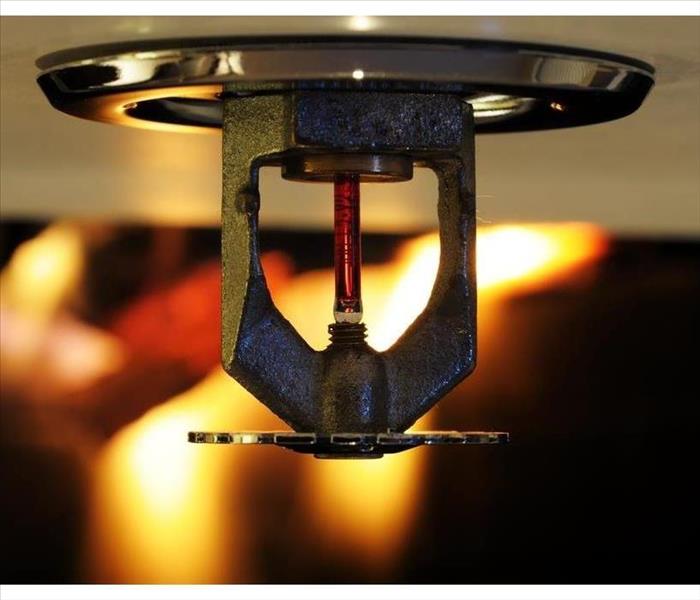 Keep your fire sprinklers well-maintained to reduce the risk of flooding on your commercial property.
Keep your fire sprinklers well-maintained to reduce the risk of flooding on your commercial property.
Every business owner in Doylestown, PA, should invest in fire sprinklers for their commercial property. When sprinklers work as designed, they can significantly reduce the damage created by a fire. Because sprinklers emit much less water than a fire department hose, they also reduce the chance of significant flooding in the building.
Accidental Activation of Sprinklers
Sprinklers are rarely triggered unless a fire is nearby, but there are a few instances in which a sprinkler can be activated by accident.
Accidental overheating - Sprinklers become activated by high heat, so you don't need to worry about burning your pizza in the oven. However, if sprinklers are located near an area of high heat, such as close to heaters or skylights, they could potentially be set off. To eliminate possible flooding caused by a sprinkler that is located in a high-heat area, you can purchase high-temperature-rated sprinklers. These will only be activated at temperatures over 200 degrees.
Corrosion to parts of the sprinkler - If a sprinkler is very old, it could become corroded. This can weaken parts of the system that release water. It's important to conduct regular inspection and testing of your sprinklers to avoid potential water damage.
Damage to the mechanism - Improper installation can potentially damage the mechanism of the sprinkler, which can cause parts of the system to loosen over time. Always make sure that sprinklers are installed by a professional with proper training.
In addition to conducting a routine inspection of your sprinklers, you should also have them inspected annually by a professional. This will greatly reduce the risk of accidental activation. It's also important to note that if water does damage your property, you must contact a water damage repair professional as soon as possible. Experts are trained to safely and effectively remove the water and dry the structures in your building.
Keep your fire sprinklers well-maintained to reduce the risk of flooding on your commercial property.
5 Crucial Steps for Mold Cleanup
7/25/2020 (Permalink)
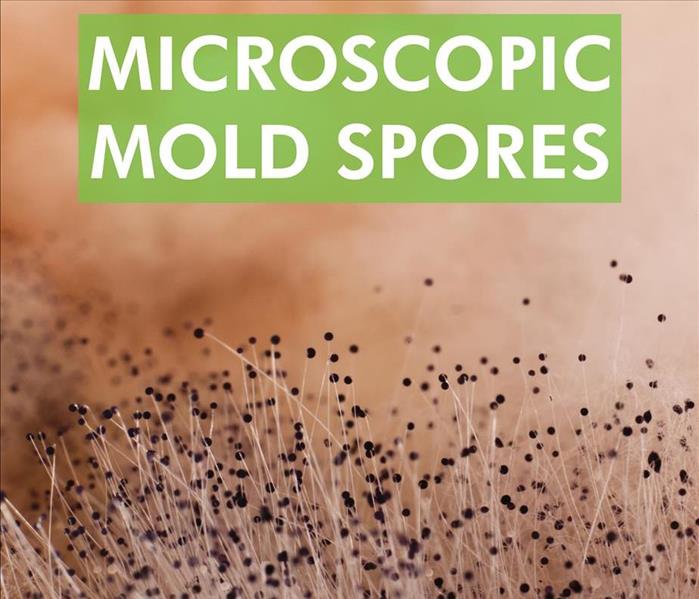 Our specialized filtration equipment allows us to capture microscopic #mold spores out of the air
Our specialized filtration equipment allows us to capture microscopic #mold spores out of the air
5 Key Steps For Mold Cleanup
Removing mold from your home in Buckingham, PA, is a coordinated process that includes many critical steps. This is true whether your home harbors black mold or another strain of the invasive fungus. A professional mold mitigation company uses highly-trained technicians and state-of-the-art equipment to clean a property of mold. Five key steps are at the heart of each successful mold cleanup.
1. Inspection and Assessment. A team of technicians arrives at your home quickly and gets to work. In a short time, they determine if mold is present and how extensive the outbreak is. They also begin to put together a plan for mold remediation.
2. Water Treatment. The presence of black mold or other strains of mold often indicates a water problem. Therefore technicians seek to locate a reason for high levels of humidity. Treating a water problem is critical to eliminating the conditions that allow for mold growth in your home.
3. Mold Containment. Microscopic mold spores are easy to spread throughout a home. Technicians use physical barriers and negative air chambers to contain mold. They are cautious about air currents and the use of the HVAC system as these actions can contribute to mold spread. By containing the mold, the cleanup process is quicker and less expensive.
4. Air Filtration. Special filtration equipment enables workers to capture the mold spores floating in the air. Powerful "air scrubbers" and HEPA vacuums are utilized to make sure as much mold as possible is removed from the property.
5. Restoration. Black mold and other strains of mold can cause significant damage to your home. The final step of the process involves repairing your home from the effects of mold. In some cases, this consists of doing some touching up of impacted areas and some painting. In homes with more extensive damage, this involves replacing drywall, installing new carpeting, and reconstructing a room.
Why Quickly Repairing a Leaking Roof Prevents Mold Growth
7/23/2020 (Permalink)
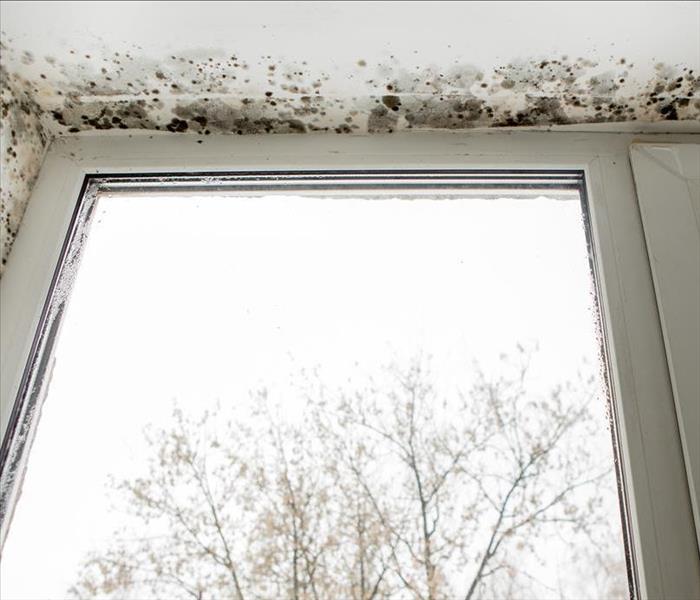 Excess moisture can also lead to warped wood and drywall.
Excess moisture can also lead to warped wood and drywall.
Even a small ceiling leak can lead to mildew, black mold, and other issues that can damage your business in Chalfont, PA. According to the Federal Emergency Management Agency, mold can grow on a surface in as little as 24 hours after being exposed to water. Mold needs just air and organic material — such as insulation, paper, and wood — to grow.
Where Can Water Come In?
Places where roofs leak include:
Broken shingles
Cracked flashing
Clogged gutters
Damaged skylights
Heavy snow or ice buildup
If there’s been a heavy wind or rainstorm in your area, look at your roof to make sure all the materials are in good shape and nothing is creating areas of standing water.
What Does Mold Damage Look Like?
Leaks can show up in different ways. You may see water spots, patches of dark paint, or plaster that’s bubbling. Excess moisture can also lead to warped wood and drywall.
If you discover a ceiling leak, look for:
Brown or gray spots on the ceiling
Visible mold growth
Musty smells, almost like rotting leaves, near the leaking area
What Should I Do if I Have a Roof Leak?
Quick action is your best bet against mold damage. Fix any leaks, keep water from continuing to build up, and start drying out the area.
If you decide to clean up the mold yourself, wear protective clothing, masks, and goggles to stay safe. Seal off the area with tarps or other plastic sheeting to keep the spores from traveling through the rest of the building. You can use store-bought mold and mildew removers or combine baking soda and white vinegar to make your own. After you’ve finished cleaning, run fans to dry the area thoroughly.
If there’s a lot of damage from black mold, get in touch with a mold remediation company. They can safely repair and restore your roof so you can get back to business.
How Digital Filing Systems Can Expedite Claims
6/25/2020 (Permalink)
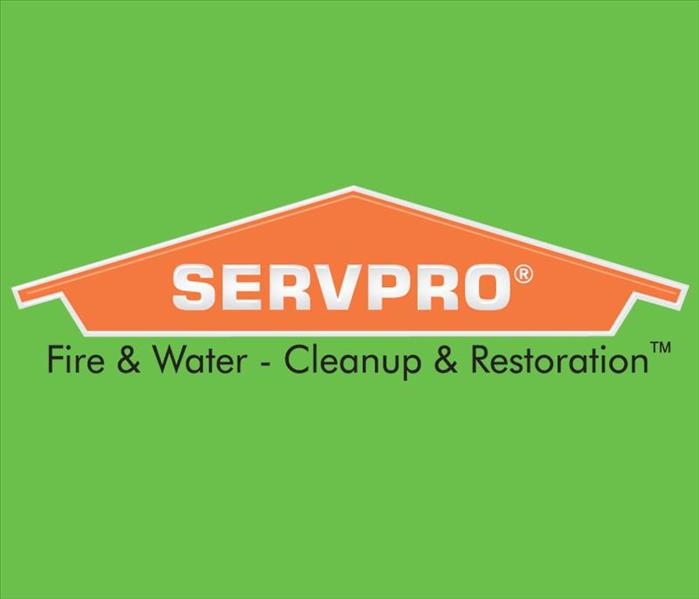 The SERVPRO Claims Information Center is a useful tool that allows you, the insurance agent, to manage and organize project files.
The SERVPRO Claims Information Center is a useful tool that allows you, the insurance agent, to manage and organize project files.
As an insurance agent, are you still using manual methods for research and claims management? Do you have a filing cabinet filled to the brim with open cases? Don't you think a digital filing system would ease the congestion and make your job less chaotic? SERVPRO, a disaster restoration specialist in Buckingham, PA, wants to make everyone's life easier with the Claims Information Center, which creates a more streamlined approach to the insurance claim process and even speeds it up. There are at least three reasons a faster claims process is better for everyone.
1. Expedited Settlements
2. Increased Efficiency
3. Improve Customer Satisfaction
Expedited Settlements
The quicker you can move on from one insurance claim to the next, the more money you save your company. When a claim is slowed down because of backlog and miscommunication, a company will spend more on litigation and resolving other changes and complications.
Increased Efficiency
A system like the Claims Information Center allows for greater efficiency and fewer redundancies. All parties involved in the claim process can access the project files and add any necessary information. For example, a client can upload proof of loss documentation, the restoration team can file their estimate for the complete project and the insurance adjuster can research similar claims, all within one cohesive system.
Improved Customer Satisfaction
When dealing with commercial clients, it is crucial to get the funds sooner rather than later. The longer a business is interrupted, the greater the financial loss and disruption. Therefore, if you can get a client claim settled quickly because of a tool, then you will inevitably breed customer satisfaction, which leads to client retention.
The SERVPRO Claims Information Center is a useful tool that allows you, the insurance agent, to manage and organize project files. The organizational help means that you can move through the insurance claim process quicker, leading to satisfied clients and employers.
What Is and Isn’t Covered After a Fire
6/23/2020 (Permalink)
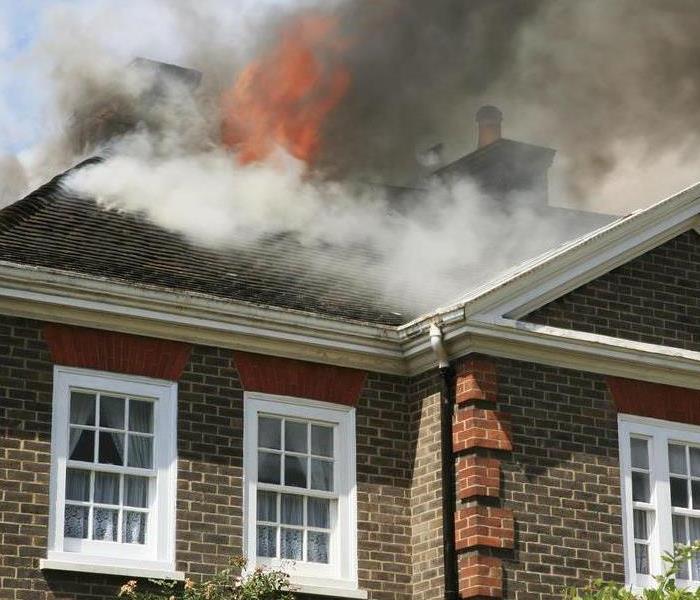 A home fire can be a devastating event.
A home fire can be a devastating event.
If a home fire breaks out, homeowners in Buckingham, PA, can usually depend on their home insurance to help them through the trying time. Understanding how much help and what is and isn’t covered is important to know before an incident even happens. Although every policy is different, standard policies usually have similar coverage.
What Is Covered?
For people residing in the property they own, a basic policy will provide coverage in the case of an accidental fire or lightning strike. It often includes four categories.
Main Dwelling: Both partial and complete damage may be covered. Insurance will assist with the cost to rebuild or repair the home. If there isn’t a complete loss, fire and smoke remediation and restoration expert will need to be contacted for proper repairs.
Other Structures: If your property includes sheds, detached garages, or other unattached structures, they are typically covered by insurance. That usually includes repair or rebuild costs, as well as debris removal.
Personal Property: Most policies have a maximum limit for personal belongings, which may include furniture, electronics, and clothing. Some items, such as jewelry, often require an additional policy.
Loss of Use: Even a small fire creates massive repairs. From eliminating the smoke damage to replacing walls, it can take a while before your home is livable. Many policies provide living expenses during the repairs. This may include the cost of a hotel or rental and groceries.
What Isn’t Covered?
While the typical home fire is caused by accident or nature, arson is another story. If a homeowner purposely sets a house ablaze, don’t count on insurance providing any assistance. For homeowners with multiple properties or in the middle of a move, a vacant home fire may not be covered. Homes that will be vacant for more than 30 days will likely require a vacant homeowners insurance policy. While it is an added cost, it does provide peace of mind against vandalism.
A home fire can be a devastating event. While hopefully, one doesn’t happen, understanding your insurance policy beforehand makes recovering a lot easier.
Mold and Insurance Claims
6/17/2020 (Permalink)
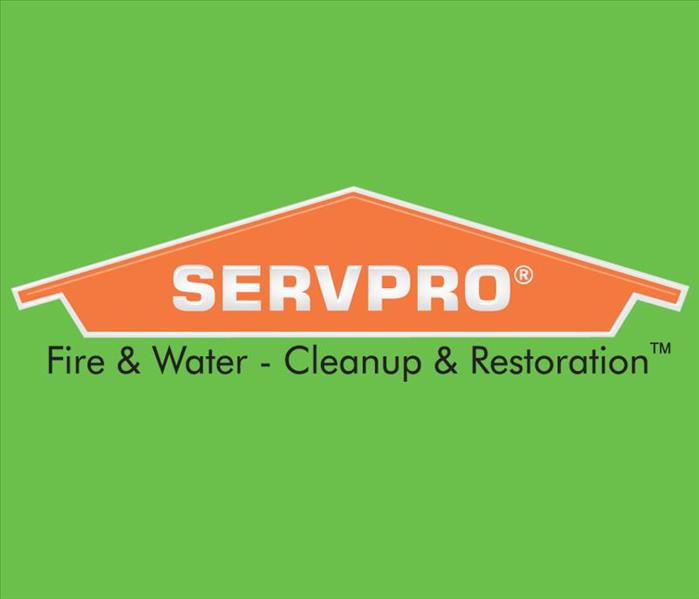 Odor removal techniques may be necessary to rid the building of the musty smell associated with mold.
Odor removal techniques may be necessary to rid the building of the musty smell associated with mold.
The situation with mold insurance claims is anything but simple. Will a commercial insurance policy cover a claim? the shortest answer is, it depends. A long time ago, mold damage was more readily covered than it is today. After an increase in the number and expense of claims in the 1990s, the insurance industry installed a fungus exclusion to commercial policies. The main point is that only in certain circumstances is fungus damage, repair, and cleanup covered. Two areas are typically covered: they include situations where water damage was the cause of mold growth and situations where water from fire-fighting equipment resulted in mold growth.
A Look at a Mold Claim
Many companies in Doylestown, PA, have fire sprinkler systems installed on their property. Sometimes this equipment leaks or accidentally discharges. The added presence of moisture could result in mold growth that requires cleanup from a professional mold mitigation franchise. In scenarios such as this, mold insurance claims may cover the following items:
Direct physical loss or damage
The expenses related to cleanup and replacement of materials
The cost of testing throughout the process
Even in cases that are covered, the company must show that it acted swiftly once a problem was discovered. For example, a slow leak that should have been repaired, and that eventually resulted in a mold problem, could be denied because the company did not take action to stop the leak.
A Look at Mold Remediation
The process of mold restoration involves a number of steps, many of which should be undertaken by certified technicians. Testing is critical to determine if mold is present in high concentrations and to identify the mold strain. A plan of action includes mold containment and removal and cleaning and sanitizing of all affected surfaces and belongings.
Odor removal techniques may be necessary to rid the building of the musty smell associated with mold. For more about mold insurance claims, it is best to talk with an agent.
A Moldy Situation: How To Fight Commercial Mold
6/10/2020 (Permalink)
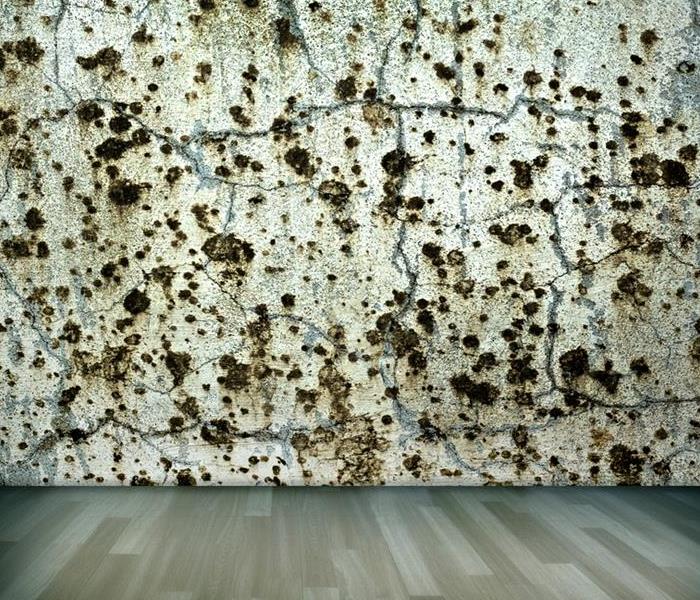 Mold removal is not a DIY project.
Mold removal is not a DIY project.
Mold spores are a part of life in Chalfont, PA, but they do not have to be a part of your commercial property. From carpet cleaning to disinfecting surfaces, fighting mold isn’t a one-person job. Controlling the moisture inside your building prevent mold damage, but that's only the tip of the iceberg. Here are four steps that can keep your property mold-free.
1. Just Keep Cleaning
Mold needs two conditions to thrive: darkness and dampness. Regularly cleaning your facility is essential to prevent excess moisture from building up and causing more mold to flourish. Make sure your commercial building is as dry as a desert, especially after a flood or other unexpected influx of water.
2. Don't Forget the Vents
Always inspect your air ducts for evidence of mold. They're one of the places where mold likes to hide the most. Airflow should be smooth and free. Regularly cleaning your air ducts can be vital to preventing mold problems.
3. Remember: It’s a Jungle Out There
The carpeting may warm up your commercial property, but it's also a desirable place for many microscopic creatures to call home. Chief among these unwanted residents is mold, and that is why it is crucial to do a deep carpet cleaning to evict mold spores from your carpet for good.
4. Know When It's Time To Bring Out the Big Guns
If you don’t want mold in your property, you may want to invest in a HEPA vacuum. It has a filter that your standard vacuum does not and that allows it to pick up virtually every itsy-bitsy thing that you cannot see.
Mold removal is not a DIY project. It can fester on surfaces that are invisible to the naked eye. That's why deep mold cleanup, including carpet cleaning, is required to pick up any little remnants of mold in your property. If you suspect that your commercial property has mold problems, seek out a mold removal professional to quickly return your business to normal.
How To Deal With a Disaster at Your Business Property
6/10/2020 (Permalink)
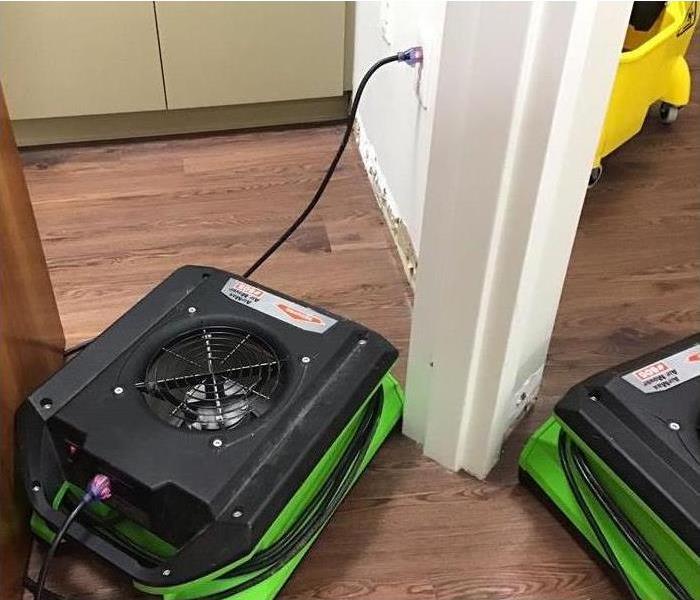 SERVPRO can get your business back to normal as soon as possible
SERVPRO can get your business back to normal as soon as possible
Anyone who has been dealt a blow to their business property in Doylestown, PA, due to a flood or other water disaster, is painfully aware of how traumatic the situation can become. The sheer number of decisions can seem overwhelming. To add to the stress, a water emergency must be dealt with quickly. Water absorbs almost immediately into flooring, walls, and even office furniture. Once that happens, the damage can be irreversible. That's why it is critical to contact a water restoration service within a 24-hour timeframe.
Water Damage That Can Occur Quickly
A fast response is essential. If you wait longer than 48 hours to seek help, the following damage can occur.
Mold and mildew begin to grow on surfaces, including carpeting and drywall.
Wood flooring, window frames, and furniture warps and swells.
Metal starts to rust.
Paint on walls and ceilings will blister.
Serious contamination can occur.
Professionals Who Can Help
SERVPRO is the restoration service of choice for many insurance companies because of the expertise of its employees. With franchises all over the United States, the company offers 24-hour service, 7 days a week. If you leave a message, someone will respond to your call within one hour, and a technician will be at your location within 4 hours.
Steps the Professional Will Follow
The expert will inspect the water damage to determine the cause and the extent of the damage.
The water is removed using pumps and vacuums. Air movers and dehumidifiers draw out the additional moisture.
The entire area is cleaned and sanitized using special cleaning techniques and antimicrobial treatments to remove odors and prevent mold growth.
Restoration takes place once the area is fully dried, cleaned, and sanitized.
In an emergency, make sure you contact a professional that is always open to serve your needs. With 24-hour service available, SERVPRO can get your business back to normal as soon as possible.
What Can Cause a Toilet To Leak?
6/4/2020 (Permalink)
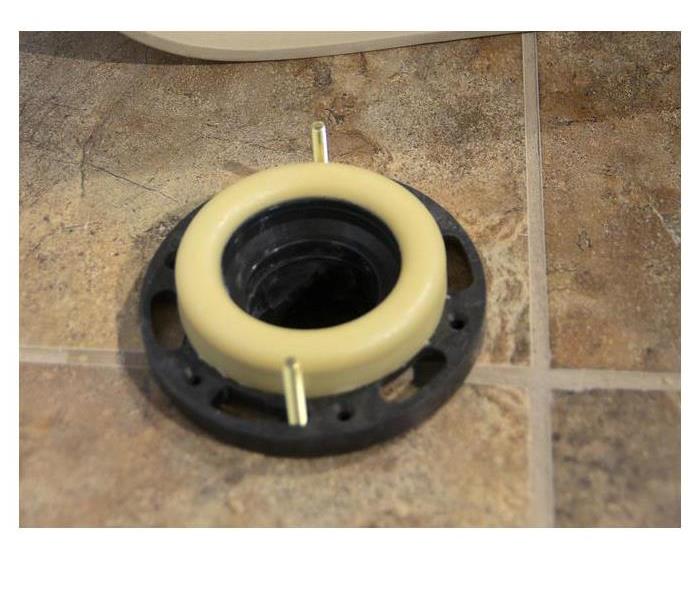 A wax ring around the toilet creates a seal that prevents leaking
A wax ring around the toilet creates a seal that prevents leaking
What Can Cause a Toilet To Leak?
If you have ever witnessed a leaking toilet in New Briton, PA, it can be a concerning sight to see. However, there may be a few simple reasons as to why you are experiencing this type of bathroom leak as well as a complex one. If the leaking becomes too severe, you will need to call in a water damage company to prevent further harm.
1. Wax Ring
A wax ring around the toilet creates a seal that prevents leaking. If this seal is dried out or improperly installed, it will cause a leak. Replacing the wax ring could resolve the problem.
2. Toilet Flange
The flange is what the base of the toilet sits on. Bolts are used to attach the toilet to the flange. If the bolts or flange are broken, this could cause a leaking toilet. To fix this issue, you will need to replace the flange or bolts.
3. Tank
A cracked tank can also cause a bathroom leak. If the crack is small, you might be able to fix it with waterproof epoxy. However, if the crack is large, you might have to replace the tank.
4. Pipes
Rusty pipes can also cause a toilet to leak. These pipes will have to be replaced to fix the issue. You will need to seek professional help.
5. Flapper
The flapper in a toilet tank opens when you press down on the toilet handle. A flapper that has seen a lot of wear and tear can stop working properly, causing water to continuously flow through when it is not supposed to which will create a leaking toilet. If this is your problem, the flapper must be replaced with a new one.
There are many reasons why you might be experiencing a toilet leak. This type of bathroom leak could be caused by a worn wax ring, a broken flange, a cracked tank, rusty pipes or a flapper that has seen far too many uses.
Home Fire Damage: What To Expect in the First Few Hours
6/4/2020 (Permalink)
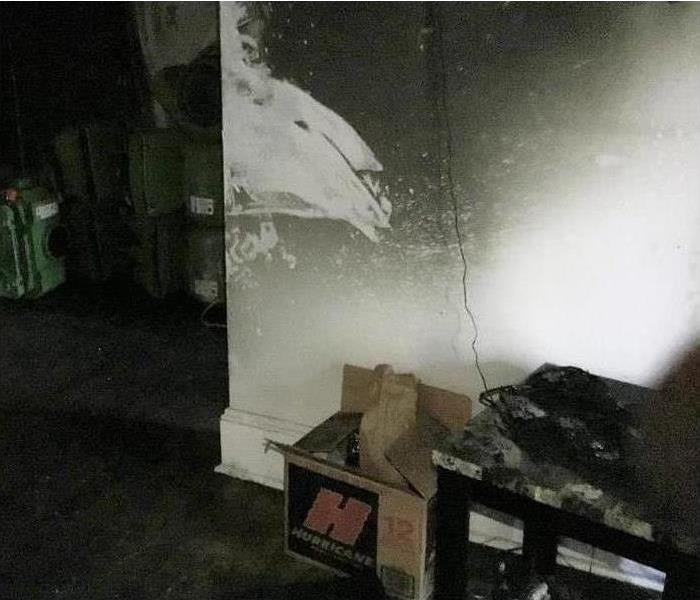 Fire damage in Doylestown, PA
Fire damage in Doylestown, PA
Recovering from a home fire is often a lengthy and stressful process. Fire and smoke damage can cause significant property destruction and inconvenience. This discussion may prepare you for what occurs once the fire is out.
Safety Inspection
When fire professionals determine the fire is safely extinguished, they will survey the damage to determine when residents can enter. The inspection will likely include these elements:
Electrical System – Your electrical panel will likely need to be disengaged until the damage is assessed and water is completely removed. When fire cleanup begins, a generator or other safe power source will be provided by fire restoration crews.
Hazards – Fires can create dangerous structural obstacles or chemical spills. These hazards will be cordoned off by fire professionals before you can enter the home.
Structural Damage – The structural integrity of your floors, walls, and stairways will be assessed. There may be areas of your home you are unable to enter right away.
The fire inspector will enter the home with you and will explain the scope of the damage. From there, you can begin gathering the help you need to for the fire cleanup and restoration phase.
Professional Assistance
Most fires cause enough damage that a fire restoration service is needed to perform the cleanup. Specialists are trained to safely clean, dry, and disinfect your property. Attempting the cleaning yourself is discouraged unless you have very minimal damage.
Insurance Consult
Once you understand the extent of the damage, it’s important to contact your homeowner’s insurance agent. They are a good resource and can answer many of your initial questions. They will outline the process for initiating a claim and explain the parameters of your coverage.
Experiencing a fire, followed by fire cleanup and property restoration is a disruptive experience for your entire household. It is helpful to allow fire inspectors, insurance agents, and fire remediation experts help you through the first few hours and days of the aftermath. They are your best resources for keeping the process moving as you return your Doylestown, PA, home, and household to normal.
How To Replace an Old Wax Gasket Under a Toilet
5/28/2020 (Permalink)
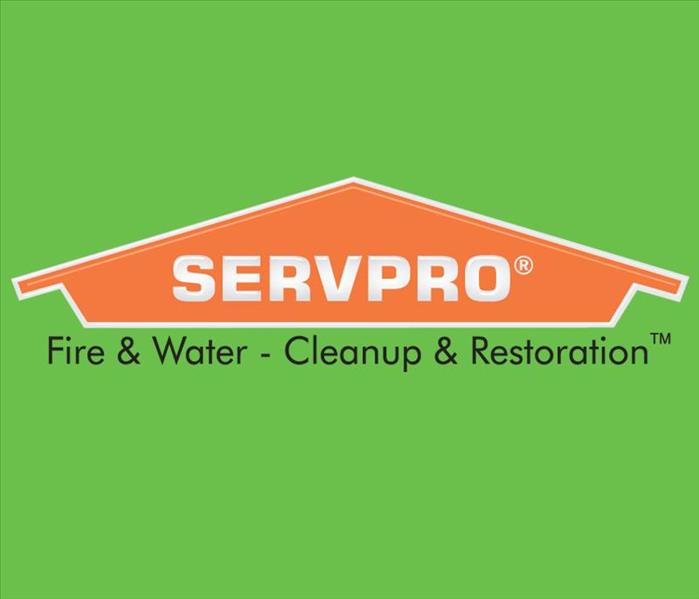 A leaking toilet is a common issue in homes. You can repair most problems alone, but professional help is useful.
A leaking toilet is a common issue in homes. You can repair most problems alone, but professional help is useful.
There are many reasons for a leaking toilet, but the explanation is typically linked to the location of the leak. For example, a leak from a tank likely relates to a loose connection, but a leak from the bottom of the toilet is most likely because of an old wax gasket. While there are several water mitigation companies in Buckingham, PA, you can replace an old wax seal by following a straightforward process.
Shut off the water supply
Remove the toilet
Remove and replace the wax gasket
Reseat the toilet
Shut Off the Water Supply
Before you even think about replacing the wax ring causing your bathroom leak, shut off the water supply at the back of the toilet. You may also want to empty the toilet tank by flushing it. However, water may still leak out, so mitigate this problem by placing several towels across your bathroom floor.
Remove the Toilet
With the leaking toilet deprived of water, you can disconnect it from the floor. You can find two bolts on either side of the toilet, securing it to the floor. Remove the nuts and washers on these bolts. You can also disconnect the supply line from the back of the tank. Once you remove everything, lift the toilet from its position and set it aside.
Remove and Replace the Wax Gasket
By removing the toilet, you expose the wax gasket. Use a tool, such as a putty knife or screwdriver, to get under the gasket and lift it free of the floor. After removing the old ring, inspect the pipe for damage. If everything looks OK, clean the area and place the new gasket, pressing down to secure it.
Reseat the Toilet
With the new gasket in place, you can reseat the toilet. Place it over the bolts, reattaching the nuts to the base, and securing the supply line to the tank. With everything secure, turn the water back on and flush the toilet, checking for leaks.
A leaking toilet is a common issue in homes. You can repair most problems alone, but professional help is useful.
Steps To Making a Water Damage Claim
5/26/2020 (Permalink)
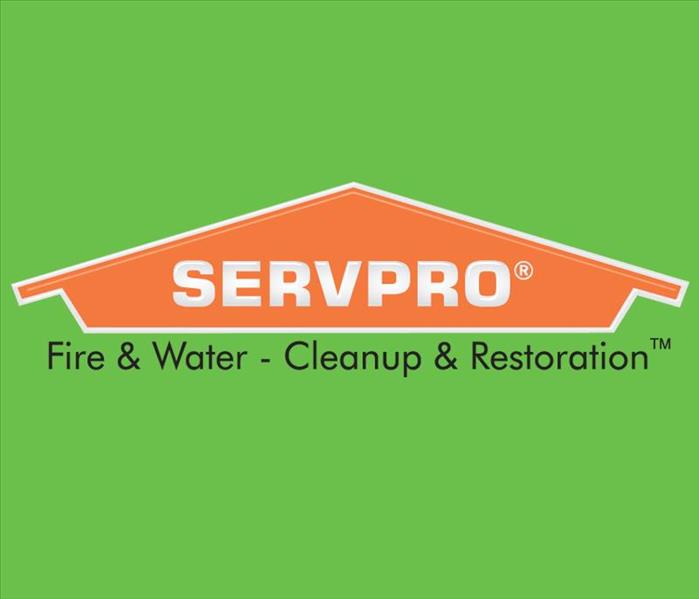 If you are careful and thorough, you should successfully make an insurance claim.
If you are careful and thorough, you should successfully make an insurance claim.
Some people may go years without having to make a homeowner's insurance claim. In fact, it may even seem frustrating to pay insurance premiums for something you don't use. However, if you experience a disaster such as flooding, you will be relieved to rely on your insurance plan to help with the cleanup and restoration process. If you have never made a water claim, it's helpful to understand what steps you should take to help this process go smoothly and successfully.
Understand Your Policy
Before you can make an insurance claim, you should know what your policy entails. Many homeowners in Chalfont, PA, have no idea what coverage limits exist in their plan and what levels of coverage are in the policy. Review yours by doing the following before filing a water claim:
Know what types of water damage your plan will cover and which it will not
Know what your deductible is for different claims.
Read the fine print so you understand any exclusions or exceptions.
Gather Information
Before you can talk to your insurance agent about filing a claim, you should be prepared to show the company the extent of the damage. Take pictures of the flood and the items it ruined or affected. Take photos of your damaged home and any ruined belongings you have. You should also write down details about the incident, including how it started and how severe it was.
Call Your Agent
Whether the flooding occurred because of a pipe burst, sewer backup, or bad weather, you should file a claim as quickly as possible. Get in touch with your insurance representative and provide him or her with the information you have assembled. You should hire a professional flood cleanup company and coordinate efforts with the technicians and your insurance.
If you are careful and thorough, you should successfully make an insurance claim. You shouldn't have to be stuck paying the bill to repair your home.
How To Handle Category 1 Water Damage Cleanup
5/10/2020 (Permalink)
 Category 1 Water Damage comes from a clean water source, a fresh water line for a refrigerator
Category 1 Water Damage comes from a clean water source, a fresh water line for a refrigerator
If you are dealing with water damage in your building in Buckingham, PA, it’s important to understand what type of water has caused the damage. Water from a clean water source, such as a broken pipe or a crack in the supply line, is called Category 1 water damage.
You may be tempted to think that you can clean up the damage without professional help. Granted, if the water is limited to a small area that is safe from electrical connections, you may be able to handle the situation yourself. If the water covers a large area, however, you need to call a water restoration service to assess the damage. Any pooled water that is not handled quickly can deteriorate into a more hazardous category.
How Do Professionals Handle Category 1 Water Damage?
The water restoration professionals can safely assess the situation and help you salvage as much as possible. They will:
- Locate all electrical and other safety hazards
- Find the clean water source and stop it completely
- Move small items out of the water and cover larger items to protect them
- Remove water using professional equipment
- Install fans to dry the area completely
Moisture can collect in drywall and plaster as well, so it needs to be inspected carefully for water damage before mold has a chance to grow.
After the area is completely dried and inspected, the restoration personnel will thoroughly clean the area and then apply disinfectants and deodorizers to all affected surfaces. Since mold and bacteria grow very fast in a wet and warm environment, it must be handled safely and quickly.
If carpeting, furniture, or equipment need to be disposed of, the professionals will discard it safely, being mindful of the environment.
You may think that clean water damage will not pose a threat to your business, but if it isn’t handled quickly and professionally, it can turn into a huge problem.
3 Ways To Discourage Mold Growth
5/10/2020 (Permalink)
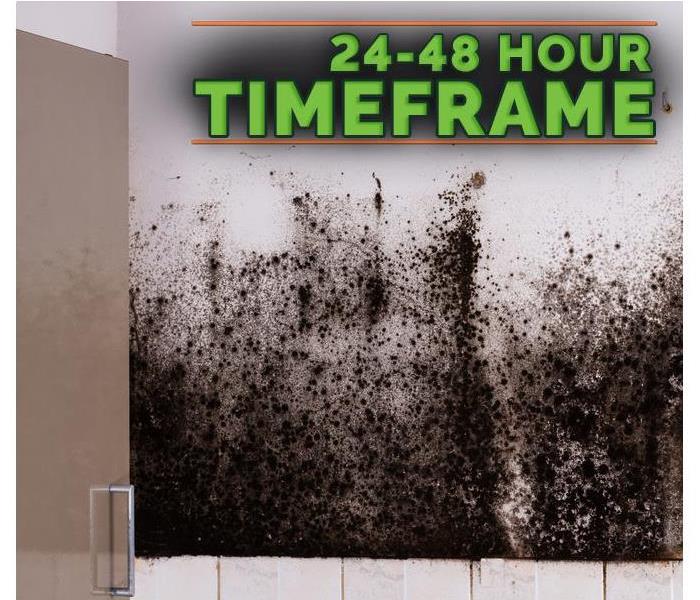 Mold may start to grow within just 24 to 48 hours after damage that involves water
Mold may start to grow within just 24 to 48 hours after damage that involves water
3 Ways To Discourage Mold Growth
Mold cannot thrive without moisture and nutriment. Properly mitigating damage caused by a broken pipe or leaky plumbing or roofing may prevent a mold problem. Limiting available moisture can keep spores from multiplying. Here are three ways for the owner or manager of a commercial building to discourage mold growth.
1. Mitigate Water Damage
Mold may start growing after building materials are exposed to water. A consistent supply of moisture is necessary for mold to grow. Airborne spores settle on damp surfaces and rely on cellulose in building materials or other organic substances as sources of nutriment. Quickly extracting standing water, encouraging fast-drying, and maintaining indoor relative humidity levels under 60% are effective mold prevention methods.
2. Maintain Low Moisture Levels
Even after water from a leak is no longer saturating surfaces, residual moisture can still support mold. Running a dehumidifier can draw moisture out of the air and porous materials. If mold is not yet a problem, providing additional ventilation with air movers or fans can also be useful for eliminating the last traces of water damage.
3. Monitor the Affected Area
Mold may start to grow within just 24 to 48 hours after damage that involves water. Regardless of whether professional restoration is necessary for primary damage, a building owner or manager should check on the condition of any materials exposed to moisture. If any signs of mold become apparent or a musty odor is detectable, he or she should arrange for expert inspection and remediation as soon as possible.
Fungi can become a problem in any building that suffers water damage. Fast mitigation followed by thorough restoration can reduce the likelihood that mold will become a major problem. If there are any indications of active mold growth at a building in Buckingham, PA, the property owner or manager should arrange for an inspection followed by remediation.
How To Protect a Damaged Roof
4/28/2020 (Permalink)
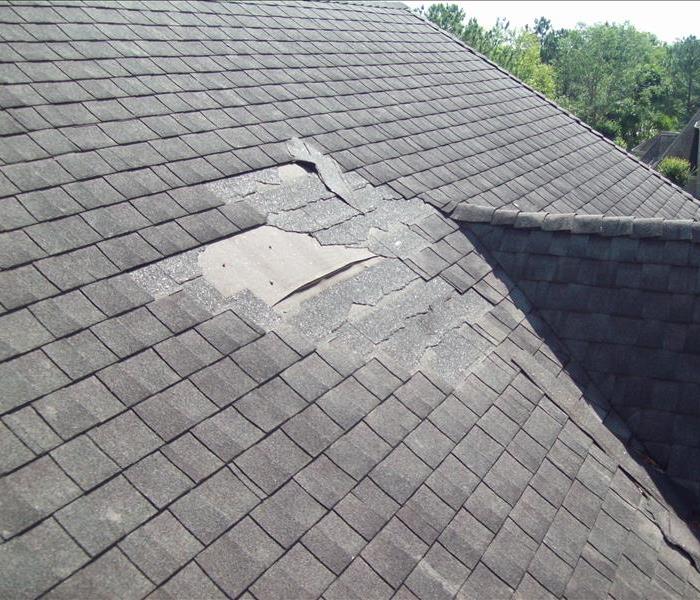 High winds can tear off shingles from your Chalfont, PA building
High winds can tear off shingles from your Chalfont, PA building
How To Protect Your Roof and Limit Secondary Damage
Severe weather is a leading cause of roof damage in Chalfont, PA. High winds tear off shingles or loosen flashing. Fallen tree limbs and flying debris can also damage materials and create punctures that lead to leaks. Homeowners should take the following measures as soon as possible to protect a damaged roof and limit secondary damage.
Determine the Extent of Damage
The first step toward protecting a roof is to identify the damage. While a homeowner may be able to perform a casual inspection, a roofing expert or residential storm damage specialist can point out signs that may be less evident. Here are a few of the most common types of damage caused by severe storms:
- Damaged shingles
- Missing shingles
- Loose or missing flashing
Shingles that are bruised, cracked, or ceased or show signs of granule loss may be more likely to leak. Wind damage may result in loose or missing shingles or flashing.
Tarp Over Holes or Punctures
Major roof damage can immediately result in leaks. Homeowners should hire professionals to tarp over any impact damage or damaged roofing materials. Performing this process successfully requires at least two people and supplies that may not be readily available at a residence.
Schedule Emergency Roof Repair
Homeowners should schedule roof repair as soon as possible. A professional tarp job should last up to 90 days. The sooner a roof is repaired, the lower the risk that a tarp will become loose or damaged during a storm.
Tarping over roof damage is the best way to keep water out until a repair can take place. If a roof has already started to leak, a homeowner should take steps to mitigate damage until the roof is fixed and storm restoration can begin. Regular roof inspections can minimize the risk of damage to the roof and structure of a residence in Chalfont, PA.
What To Know About Mold and How To Prevent its Growth
4/27/2020 (Permalink)
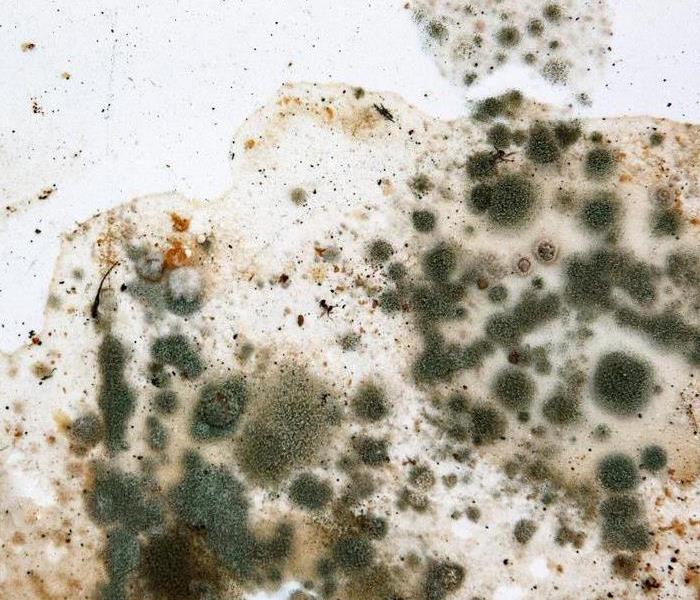 Mold is a fungus that grows best in dark and damp places.
Mold is a fungus that grows best in dark and damp places.
Performing a carpet cleaning at your Doylestown, PA, business is one way to help prevent mold problems. However, if removing mold is the aim behind the cleaning there are a few things you may want to understand about mold first.
1. What Mold Is
It’s important to note that mold is a fungus. This means that it grows by feeding off organic materials and water, in areas of dim or no light. Mold spores spread into colonies which can then take on a fuzzy or slimy appearance in a range of colors.
2. Where It Grows
Mold is commonly found in areas around easy access to water or water damage. This can include around plumbing, under the roof, basement areas, or spaces where water can be tracked in. Businesses with carpeting in their lobby may choose to have carpet cleaning done regularly as a preventative measure. Alternatively, the use of welcome mates can be used to keep water from being tracked through the company during wet seasons.
3. How To Remove It
If you think you may have mold at your place of business it’s highly recommended to contact a local remediation service. These professionals will have the tools and knowledge needed to contain the mold to prevent spreading, as well as the ability to remove any spores and make repairs. They can also help recommend mitigation measures such as cleaning regularly, repairing damage, and keeping water from collecting in places without appropriate drainage. Keeping gutters and drainage systems clear of debris can also help prevent water backup which has the potential to also lead to mold damage.
Carpet cleaning is one way to help prevent mold as the cleaners used may be able to deter growth. However, if you believe you have a mold problem at your place of business it’s best to contact a professional. Mold is a fungus that grows best in dark and damp places, and a remediation service will be best equipped to contain and remedy the problem before it spreads further.
Keeping Up With Your Plumbing Needs
4/22/2020 (Permalink)
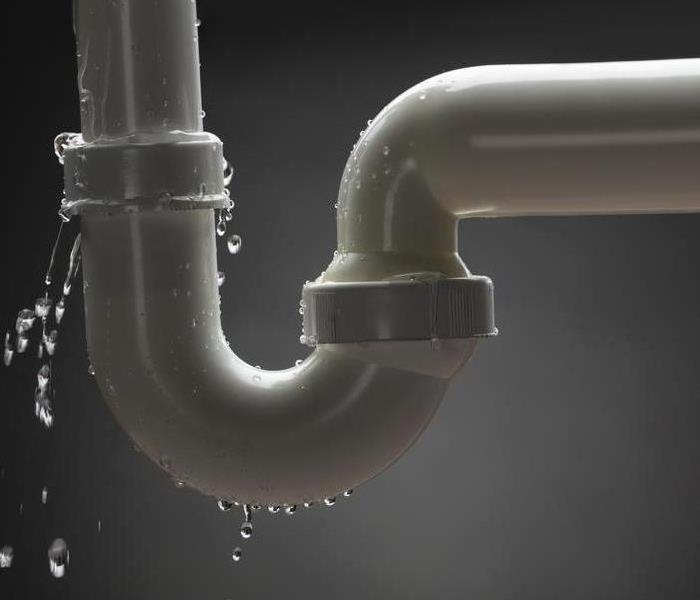 Take the proactive approach, locating trouble, and mending it as soon as possible.
Take the proactive approach, locating trouble, and mending it as soon as possible.
Like many things in life, nothing is full proof. You cannot block everything from happening. As a business owner in Doylestown, PA, you want to prevent your plumbing problems, avoiding major headaches, closures, and large claims. It's impossible to guarantee safety; however, you can make the choice to become actively aware of potential complications, reducing the probability of a major catastrophe.
1. Pay Attention to Your Monthly Statements
Find a leak before it becomes a broken pipe by monitoring how much you're spending on your company's utilities. Look at your bill, noting whether you're seeing an increase. It's best to observe changes in water usage over several months. If it's creeping up without a reasonable explanation, you may have water dripping somewhere. See a leak detection service to find your problem.
2. Be Cognizant of Your System's Condition
Often plumbing problems develop over time, starting off small. In the craziness of the day, it's easy to chalk something up to nothing, moving on to what you think is more important work. Don't brush off these minor observations. As you go about your day, note how your faucets and toilet are functioning. Are you noticing high levels of condensation? Do clogs happen quite frequently? Is something starting to rust? Anything out of the ordinary should be evaluated early on, hopefully, preventing a major break or repair.
3. Have an Experienced Plumber Look Over Your Pipes
Have a trusted, knowledgeable, plumber look over everything at least once a year. You may not think that paying a specialist to monitor is wise; however, you'll appreciate saving time down the road. After all, if a water main line busts, you'll need to call out a water restoration company to not only fix the piping but also to tend to the structural weaknesses. All of that could require shutting down the business. The team will get your place back up and running, yet this could be prevented with an early inspection.
Don't let plumbing problems exacerbate. Instead, take the proactive approach, locating trouble, and mending it as soon as possible.
Basic Services Offered by a Commercial Fire Restoration Company
4/19/2020 (Permalink)
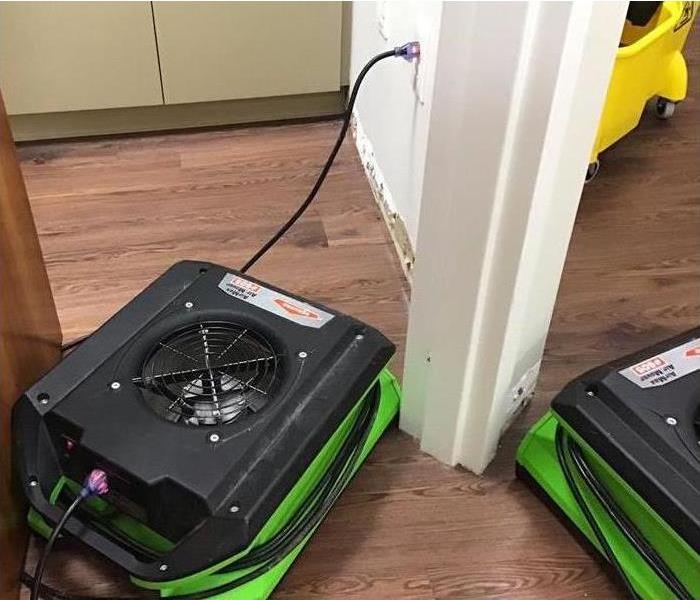 Cleaning after a fire in Buckingham, PA
Cleaning after a fire in Buckingham, PA
Make Sure The Technicians Provide The Following Services
When you contact professional fire damage restoration for your business in Buckingham, PA, you should expect some basic services as part of the process. Restoration involves several steps, some of which are crucial for a successful job. As you find the best company to handle the results of commercial fire, make sure the technicians provide the following services.
Damage Assessment
After a fast response to your call, the company's experienced workers will perform a fire damage assessment once it is safe to enter the building. This process allows them to investigate the exact damage done to the building and property, the extent of leftover smoke and soot and the impact on the location. By assessing the property, they can create a detailed, specialized remediation plan, as well as a project estimate.
Cleaning and Removal
After you see and approve of the assessment and estimate, fire damage restoration formally begins. Once the employees use tarps and boards to prevent future problems, they will clean the area and remove pollutants and leftover waste.
- Soot, dust and smoke cleanup
- Odor removal
- Water damage cleanup and drying
- Damaged object removal
- Intact object cleanup
The damage left behind endangers your property and the safety of your staff and clients. The remediation professionals ensure these contaminants are gone and everything is cleaned or replaced before reaching the repair and renovation stages.
Repair and Renovation
You will need to collaborate with the technicians to repair and replace walls, flooring, and other furniture and equipment. Whether each item is either fixed or changed depends on how much damage there is and whether it can be salvaged. Many providers also offer renovation. There might be improvements or additions you always wanted to make, so take the opportunity to inject new life into your establishment.
The process behind fire damage restoration is long and consists of multiple procedures. Always check that the people you hire offer them to guarantee a high-quality project.
3 Things To Know About Commercial Generators
4/3/2020 (Permalink)
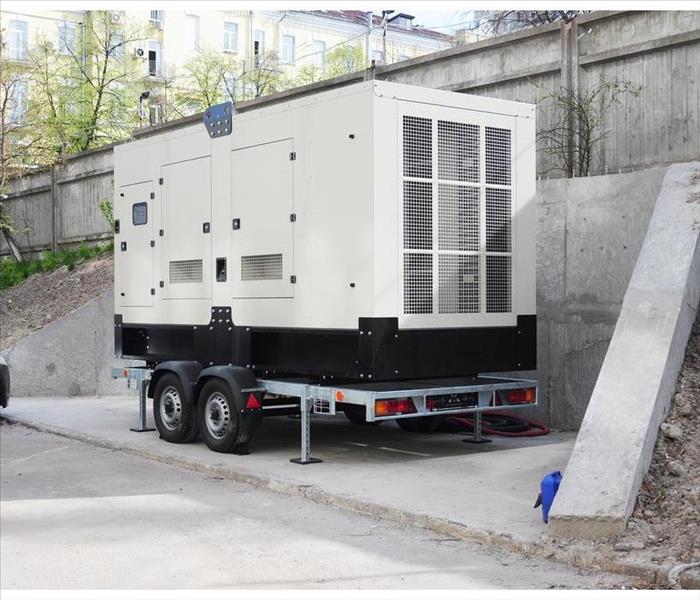 Having a generator for your place of business can be a good investment
Having a generator for your place of business can be a good investment
3 Things To Know About Commercial Generators
If you have a business in Chalfont, PA, you may want to look into investing in a commercial generator in case of a power outage. When choosing which model to use for your company, there are a few things you may want to consider.
1. How To Maintain the Unit
It’s important to properly maintain the unit to avoid generator problems. This may involve regular cleaning and inspections as recommended by the manufacturer. To ensure reliable operation it’s best to contact a professional for any service the unit may require.
2. They Can Be Used in a Variety of Situations
Choosing a generator for your business can be an important step as it can provide electricity in a number of circumstances that may cause a power outage. This can occur after heavy rains or flooding, or if the city grid begins to experience issues for any reason. Generators can also help provide power for a local damage restoration service as the work on restoring the property.
3. How Long To Run the Unit
Many generators are rated to run for up to 3,000 hours, however, you can find units designed with the ability to run longer. In most cases, this amount of time won’t be necessary as you will only need to use the machine for daily operations until the power can be restored to your building. This means you may be able to expect many, many years of operation life out of the unit you choose for your company.
Having a generator for your place of business can be a good investment. When you know how to properly maintain your unit, these tools can be useful in a variety of ways. They can provide power for restoration crews or business operations after a heavy storm, and depending on the unit chosen should be able to handle a whole day’s work.
How To Be Ready for Disaster in the Workplace
3/30/2020 (Permalink)
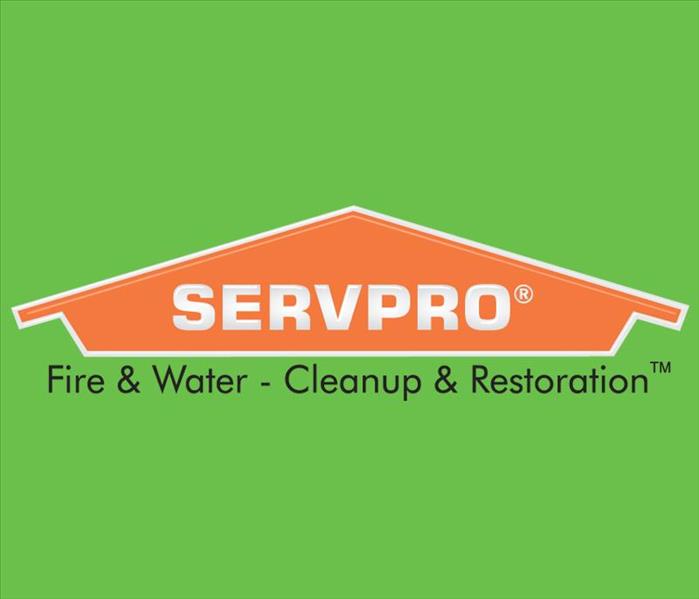 Follow these tips to guide you so you and your employees can be safe in the face of danger.
Follow these tips to guide you so you and your employees can be safe in the face of danger.
If you're a business leader, you have many responsibilities. You want to build a profitable company and take good care of your loyal customers, but you also should create a safe, comfortable environment for your staff. You also have supplies and materials to worry about. Emergencies in the workplace can threaten this security. It's no wonder why so many leaders stress disaster preparedness. If you're not ready for an emergency, now is the time to start.
Possible Events to Prepare For
You probably won't ever endure a disaster in your office. That does not mean challenging incidents can't arise. You may not be able to predict emergencies from occurring, but you can be aware of the possibilities, such as these:
Fires
Severe storms such as hurricanes, tornadoes or thunderstorms
Earthquakes
Water damage from a sewer backup or a broken pipe
Have a Continuity Plan
For effective business preparedness, you need to be ready to carry on your operations even if you can't be in the building. Make sure as many employees as possible could work remotely if necessary. Establish effective forms of communications and project management through software and online resources. Or, you could have an agreement with another office in Buckingham, PA, where you could temporarily relocate and share space.
Back up Your Data
A professional disaster cleanup team has the skills and equipment to salvage many items in your office and restore damaged materials. To be safe, however, you should back up important files and data on off-site servers and online storage drives.
Know How To Evacuate
One of the most important aspects of disaster preparedness is to develop an exit plan. Whether you're facing a flood, earthquake, fire or other emergencies, develop an effective way to safely get out of the building. Make sure everyone knows his or her role. Practice this plan at least once a year.
It may be too late to start disaster preparedness if you wait any longer. Follow these tips to guide you so you and your employees can be safe in the face of danger.
Techniques for Removing Mold From a Crawlspace After Storm
3/25/2020 (Permalink)
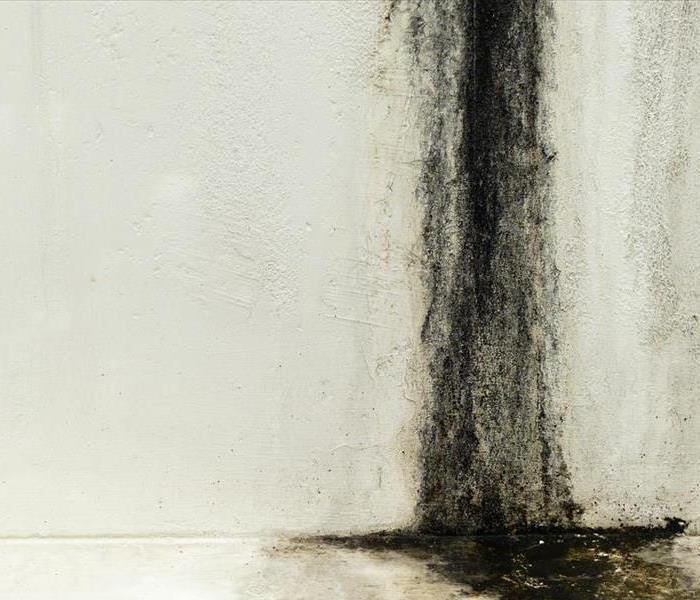 Contents of the home such as clothing, furniture, and other materials may have to be sanitized as well.
Contents of the home such as clothing, furniture, and other materials may have to be sanitized as well.
It's no secret that mold likes to inhabit the hidden, damp spaces of a home. This includes basements and attics, shower rooms and other nooks and crannies where moisture is more likely to be present. A home crawlspace is an area where mold can grow, often without the detection of the homeowner in Doylestown, PA. If you suspect mold in your home, because of a moisture problem or the presence of a musty odor, a mold remediation franchise can come to the property and conduct an inspection and damage assessment. Technicians will use special equipment such as infrared cameras to find mold growth that might not be visible.
Mold in a Crawlspace
This area of a home introduces a number of problems to the mold cleanup process. If left untreated, significant mold damage is likely to occur to the walls and flooring. One effective technique is known as mold soda blasting. Here's how it works.
The area is inspected to see if mold is present.
High-pressure soda blasting is used to clean the infected areas
The baking soda along with other chemicals thoroughly cleans the wood
The area is vacuumed and cleaned to remove mold spores
This method is faster than scrubbing the area clean by hand. It also uses chemicals that are safe.
Mold in Other Areas of the Home
If flooding has occurred in your home, the growth of mold is a possibility. It is a good idea to check in likely areas for the appearance of mold colonies or for the presence of a musty odor. If you cannot access your crawlspace, be sure to call in a company to do it for you if you suspect mold growth. If mold is found, the next step will be mold containment and then the cleaning of all infested areas. Contents of the home such as clothing, furniture, and other materials may have to be sanitized as well.
Disgusting Mold Growth Can Turn a Beautiful Bathroom Into a Repulsive Restroom
3/24/2020 (Permalink)
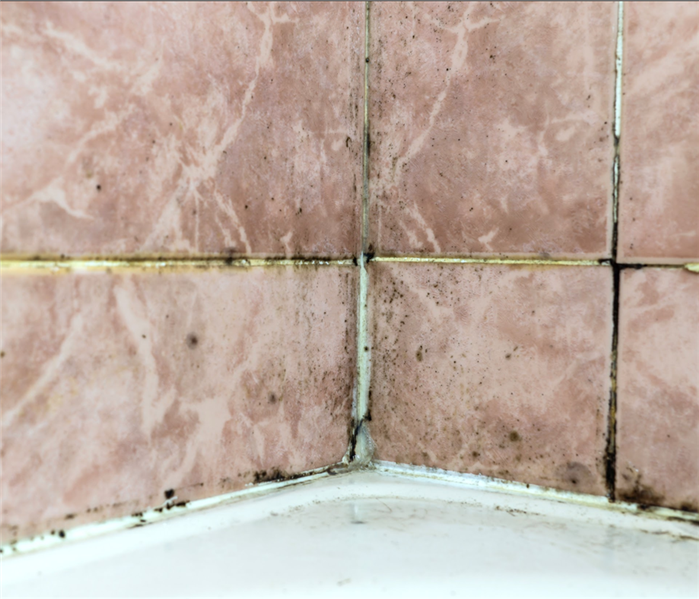 Mold damage in a Chalfont, PA bathroom
Mold damage in a Chalfont, PA bathroom
Many homeowners in Chalfont, PA, take pride in keeping a clean, inviting bathroom. A well-kept bathroom tells the world that you’re serious about property maintenance and personal cleanliness. Unfortunately, the bathroom is the leading place where fungus is likely to grow since it’s naturally more humid in there.
The grout between tiles is often the first place bathroom mildew will appear, and cleaning it is a big pain in the neck. Ideally, you can prevent mold growth in the first place by knowing the causes and taking preemptive steps to avoid the problem altogether.
The Battle Starts By Knowing the Causes of Mold Growth
Mold spores are literally everywhere most people spend their days. Outside of special environments, such as a tightly controlled laboratory, the invisible spores float around and are harmless in and of themselves. There are three basic situations that cause them to start developing into mold growth in the bathroom:
- A humidity problem
- Plumbing leaks
- Water spilling from a shower or off the shower curtain
1. Your Defense Against Mold Starts With Good Humidity Control
A steamy shower is a great way to start the day, but all that moisture has to go somewhere. If it’s trapped in the bathroom, eventually it’ll start growing mold. Make sure you have good ventilation to spread the humidity around the house, or else consider installing a dehumidifier to prevent bathroom mildew.
2. A Tiny Plumbing Leak Is a Big Deal
Even a tiny drip, if consistent, will damage building materials and cause explosive mold growth. Also, a cold water line to the toilet can cause serious condensation in a very humid environment.
3. Excess Water From the Shower Can Cause Mold
Bathroom mildew can grow in wet floor mats and drywall. If water is consistently being thrown from the shower, it’ll eventually grow mold.
Once the mold gets established, you may not be able to remove it yourself. At that point, call an experienced mold remediation company to evaluate how severe the infestation is and begin the cleanup process. Your bathroom deserves to look its best, and SERVPRO is Here to Help.
Basic Items for a Business First Aid Kit
3/23/2020 (Permalink)
 These are some of the necessary items to place in a company first aid kit.
These are some of the necessary items to place in a company first aid kit.
At your workplace in Doylestown, PA, it's a good idea to always be prepared. Thorough precautions pay off when an emergency or other urgent situation arises. For example, unexpected storm damage can cause injuries such as abrasions and lacerations to employees or other persons on the property. Minor injuries can even happen when carrying out everyday tasks. Keeping a first aid kit on hand can help treat less severe injuries and stabilize more serious ones until assistance arrives. Every business should keep some basic emergency items on the premises.
Bandages
One of the most important and useful things to have in your emergency kit is bandages. Since there are different types of dressings, include a variety of kinds and sizes:
First aid bandages for covering minor cuts
Butterfly bandages for deeper incisions
Large bandages for extensive wounds or deep cuts
These bandages should be sufficient to help with the majority of cuts. While deep or large wounds may require stitches, these dressings can help minimize bleeding until further medical care arrives.
Disinfecting Sprays or Creams
Including a disinfecting ointment in your first aid kit is important for treating cuts. Because lacerations have open skin, they can leave the victim susceptible to infection. Putting an antibacterial ointment on the cut before covering it with a bandage can help prevent infection. A spray may be more practical for a larger wound.
Cold and Pain Medications
While a cold or a simple headache rarely requires medical attention, it can make the day more miserable. Pain medications, as well as cold medicines, can prove useful when employees or other persons are feeling unwell. You may also want to keep antacids on hand for times when someone is experiencing an upset stomach.
These are some of the necessary items to place in a company first aid kit. Having this gear on hand can be particularly useful after experiencing a storm or flood damage. After the weather event has passed, you should contact a storm damage restoration team to assess and repair any destruction that your business sustained.
How to Handle Water Damage After a Fire
3/18/2020 (Permalink)
 Fire damage is undoubtedly the worst thing that could ever happen to any homeowner.
Fire damage is undoubtedly the worst thing that could ever happen to any homeowner.
Fire is a useful invention with the potential to create a complicated fire damage mess involving structural and water damage to a house. While both possibilities pose a significant threat to your property, it’s water damage you should be worried about. Moist conditions encourage rot, and can even lead to severe mold growth in hard to reach areas.
Common causes of fire in Doylestown, PA, include:
Unattended cooking equipment
Heating
Smoking in bedrooms
Electrical malfunction
Handling Water After Fire Damage
After the flames finally die down, shut off the power and water lines running to the house. That will cut off supply to the fire hose, but it will also mitigate the risk of electric shock and more fire damage. With that out of the way, call insurance and start the water removal process immediately.
There’s no doubt firefighters use a lot of water to put out fires. This water can cause flooding and threaten the wood as well as your wallet. To get rid of it, start by removing any salvageable items from the house then use a sump pump to get rid of excess water from the floor.
However, avoid using a vacuum cleaner for water removal as it presents a surprisingly high risk of electric shock. Remember that you can never be 100% sure there’s no electricity in a water-logged house, even when the main circuit breaker is off.
Document the Damage During Cleanup
Take a video of the cleanup process for documentation purposes. That will act as your evidence to the insurance provider, making the claim process easier. Also, please make a list of all the damaged items, as seen on video, so you’ll be ready to hand it over when asked.
That said, fire damage is undoubtedly the worst thing that could ever happen to any homeowner. It occurs more often than most people might think, and that’s why you need to know what to do if it happens to you.
What to Do When Your Business Is Impacted by Smoke Damage
3/15/2020 (Permalink)
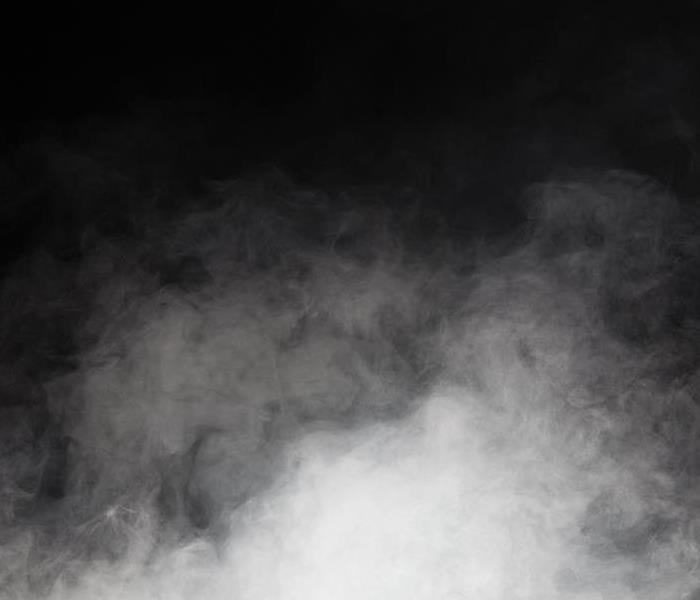 Your business can return to normal in no time when you trust smoke damage experts to do the job.
Your business can return to normal in no time when you trust smoke damage experts to do the job.
No business owner wants to discover that his or her building has been affected by smoke damage. However, it’s important to take action as soon as possible to prevent the smoke from spreading to other parts of your business. While you’re waiting for commercial building restoration services to arrive, be sure to take the following steps to mitigate further damage and keep your Doylestown, PA, business safe.
Direct Smoke Away From the Building
The first thing you should do when dealing with smoke or soot damage is to direct it away from your building. Be sure to do the following to prevent smoke from continuing to spread through your business:
Turn off your air conditioning unit
Open all the doors and windows in the building
Turn on fans and point them towards the open windows and doors
These steps can help to ensure that the smoke damage stays under control. In addition, you can keep your business well ventilated by opening doors and windows and keeping your fans running.
Wipe Down Surfaces
By leaving traces of smoke particles in your building, they run the risk of spreading throughout your business. Use a rag to thoroughly wipe down any surfaces in your building that have been affected by smoke, such as countertops and desks. This can help to keep further damage at bay until help arrives.
Remove Valuable Items
If any valuables that belong to you or your employees are found in a smoke-affected area, be sure to remove them right away. This prevents the items from sustaining further damage as a result of smoke or soot. After you’ve moved your valuable items elsewhere, be sure to contact an expert to handle them properly.
With the help of a professional smoke cleaning, your commercial building and its contents can be taken care of appropriately. Your business can return to normal in no time when you trust smoke damage experts to do the job.
Top 3 Roof Maintenance Tips For Commercial Buildings
3/14/2020 (Permalink)
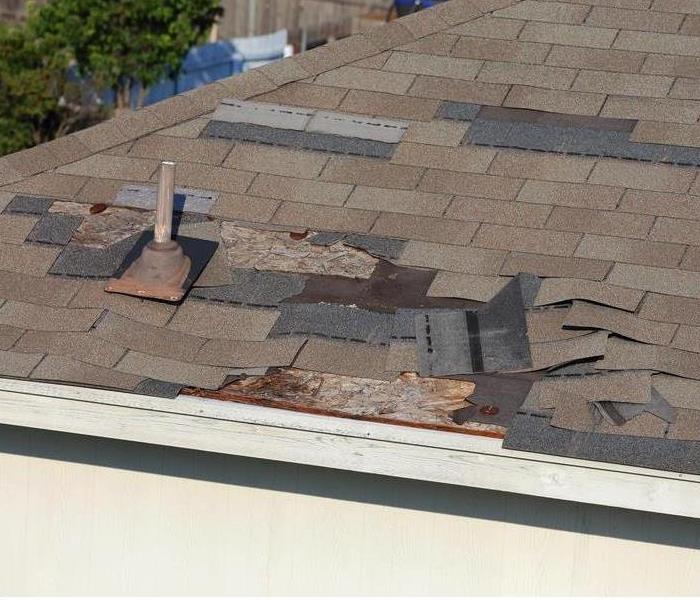 A roof leak is, undoubtedly, one of the most annoying things you can deal with as a business owner.
A roof leak is, undoubtedly, one of the most annoying things you can deal with as a business owner.
The roof is one of the most expensive parts of any structure for a good reason. It plays a big role in protecting your stuff from the elements while adding aesthetics to the overall design. That's why you need to show it some love to avoid a roof leak and other nasty surprises.
Here are the top 3 roof maintenance tips for commercial buildings in Doylestown, PA:
Clean gutters
Clear drains
Have regular inspections
1. Clean Gutters
Gutters are supposed to direct stormwater away from the building to prevent water damage and flooding. If the fixture is blocked, you run the risk of having a nasty ceiling leak or water-logged walls. That can escalate to a flooded electrical system, and things could head south from there. The water could also seep to the foundation and threaten the building's structural integrity. Therefore, cleaning the gutter will help prolong the life of your house.
2. Clear Drains
After cleaning the gutters, head straight to the drain and make sure the system delivers water to the waterway flawlessly. That will make sure the water gets off your roof shortly after landing there, minimizing the risk of leaking. The last thing you want to is to experience a drain backup on a flat roof in the middle of a torrential downpour.
3. Have Regular Inspections
A roof leak is a professional level problem that should never be attempted by an inexperienced DIYer. Walking on an old roof can be quite dangerous, and you also risk worsening the situation. For these reasons, it is advisable to have a roofing expert inspect the wind damage and fix any problems before they get worse.
A roof leak is, undoubtedly, one of the most annoying things you can deal with as a business owner in Doylestown, PA. It can cause water damage that could cost thousands of dollars, and that is never a good thing for a small business. Luckily, these tips will help you avoid this disaster.
Things Every Property Manager Should Know Before the Big Storm
3/11/2020 (Permalink)
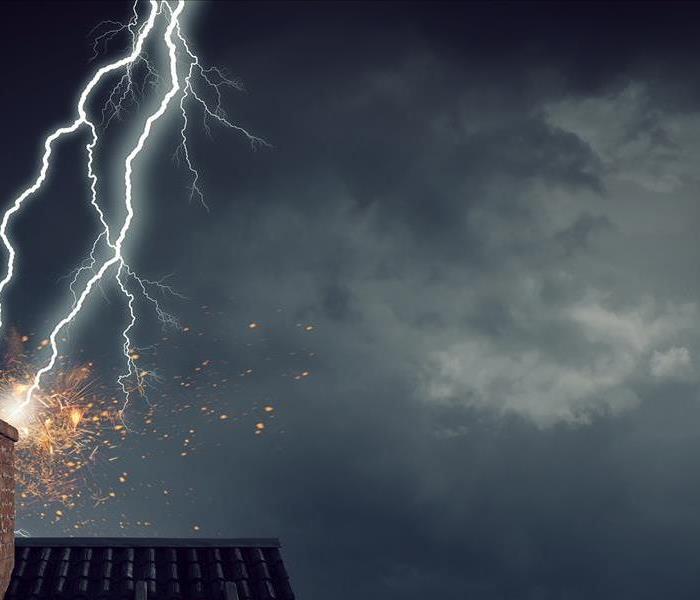 Storm preparedness is an essential part of a property manager's job.
Storm preparedness is an essential part of a property manager's job.
After hurricanes or severe weather, people are used to seeing the calamity and the storm restoration companies from Doylestown, PA, attending to the cleanup. However, as a property manager, your job is about storm preparedness and how to minimize damage and risk. There are five areas that every property manager should be familiar with.
Personnel safety and preparation
Building preparation
Emergency contacts and responsibilities
Data and files
Reports
Personnel Safety and Preparation
Every property manager is responsible for the care and safety of the employees and clients under their roof. You must have or develop evacuation and shelter-in-place plans for your building. Also, it is a good idea to run routine drills, so everyone in the company and facility is aware of storm and disaster protocols.
Building Preparation
Property management is also about building preparation before a storm, ensuring minimal damage. If hurricanes or other high wind events are predicted, then board up windows and vulnerable doors.
Emergency Contacts and Responsibilities
Also, having a list of emergency contacts and delegating responsibilities is part of storm preparedness. For example, managers of each department should be charged with counting heads before, during and after an event. Also, each manager should have a list of contacts for people that need to be notified after a company disaster.
Data and Files
Data and files are often overlooked during the panic of storm preparations, but this information is vital to the sustainability of a company. Make sure that you or someone on staff is responsible for backing up all critical data and files.
Reports
Once the storm is over and panic subsides, you will likely need to create several reports. For example, inventory may need to be checked and reported to execs and insurers. There are likely to be other reports about damages and emergency response as well.
Storm preparedness is an essential part of a property manager's job, as is the care and safety of those who work under you. If you need assistance in developing storm preparations, contact your local first responders or a storm mitigation company.
Remove Odors After a Storm
3/9/2020 (Permalink)
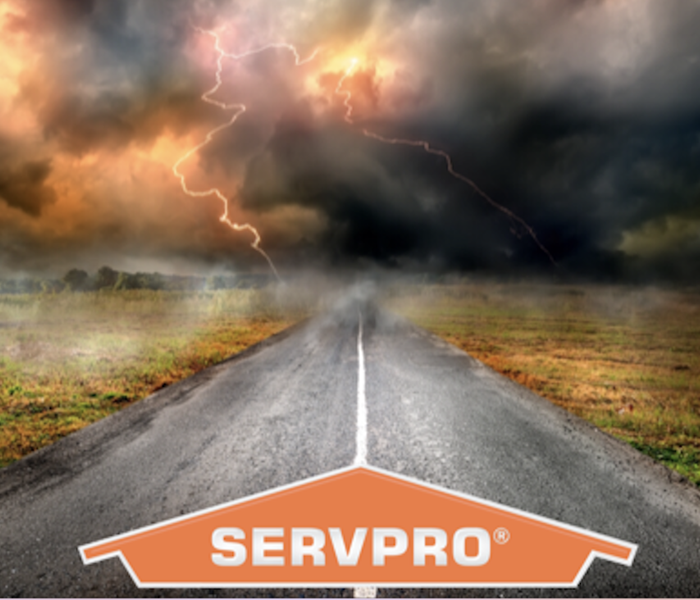 Effective cleaning, sanitizing and deodorizing are the hallmarks of cleanup that has been well done.
Effective cleaning, sanitizing and deodorizing are the hallmarks of cleanup that has been well done.
A big storm is likely to result in a number of problems for your company. It happens just about every day somewhere in the U.S., and at some point Doylestown, PA, it will face its day of reckoning. One sure side effect of a major storm is a number of unpleasant odors, caused by a number of things. In fact, your nose will often lead you somewhere that needs attention. For example, mold growth, a common occurrence after a storm, usually gives off a musty unpleasant odor. This is a situation that demands immediate attention. Mold containment and cleaning and deodorizing will be needed as soon as possible.
Other Odors
In addition to mold growth, a medley of smells often plagues a commercial building after a storm. Here's a shortlist of a few smells that may be present in the hours, days or weeks after a damaging weather event:
The bathroom smell from a sewage loss
The musty odors of wet furniture
The stale aroma of wet paper products
The offensive odor of spoiled food
Improper or insufficient cleaning simply mask smells, and this course of action is doomed to failure. The smells will return. With the right equipment and methods, a professional storm damage team is able to remove odors from floodwaters without a trace. The key is attacking the source of the smell.
Additional Issues
A big storm has the capacity to wreak serious havoc. Each situation is different, and it's hard to say exactly what problems will crop up. It could be electrical damage, plumbing issues, property damage, mold growth, or water damage. If unsavory odors remain long after the storm, this is an indication something is not right. Everyone wants to work in a clean and healthy environment.
Effective cleaning, sanitizing and deodorizing are the hallmarks of cleanup that has been well done. Afterward, the only odors that should remain are pleasant ones.
Fire Restoration Process
3/8/2020 (Permalink)
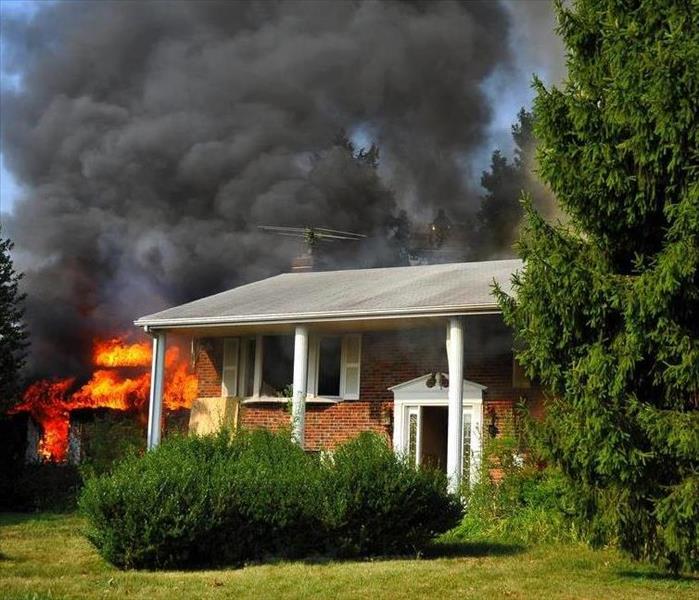 A house fire in Doylestown, PA, can be a very distressing experience.
A house fire in Doylestown, PA, can be a very distressing experience.
A house fire in Doylestown, PA, can be a very distressing experience. However, it is important to begin the fire restoration process as soon as possible to prevent further damage. The following outlines the steps to take after the fire has been extinguished and everyone is safe:
1. Call the insurance company. If you have fire insurance, let your insurance company know about the situation so that they can begin the claims process. They will also let you know of any special requirements for documenting the damage and send an agent to assess your property.
2. Temporarily cover openings. The fire-extinguishing efforts may have damaged windows, doors or the roof. If there are any holes, it is important to tarp or board over them to keep out wildlife, criminals and bad weather during the fire restoration process.
3. Dry out the structure. The water from the fire-extinguishing efforts can begin to grow mold in as little as 24 hours. You may need to use specialized pumps or vacuums to remove the standing water. If there is still moisture present, you can use fans or a dehumidifier to speed the drying process.
4. Clean up smoke and soot. Smoke and soot will have gotten everywhere affected by the fire. There are special cleaners designed to remove this residue. Even after removing all the visible soot, you will have to do further smoke cleaning to eliminate the smell. Run air filters, ozone machines or thermal foggers to remove the particles from the air and deodorize the area.
5. Repair and replace damaged items. After everything is clean and dry, you can begin restoring the damaged items. Some repairs you may be able to do yourself, but others might require specialized techniques.
Fire restoration can be a very intensive process. If you feel overwhelmed, you may wish to hire a certified restoration team to help you get your home back to normal.
How can I protect myself, my family, my employees, and my customers?
3/6/2020 (Permalink)
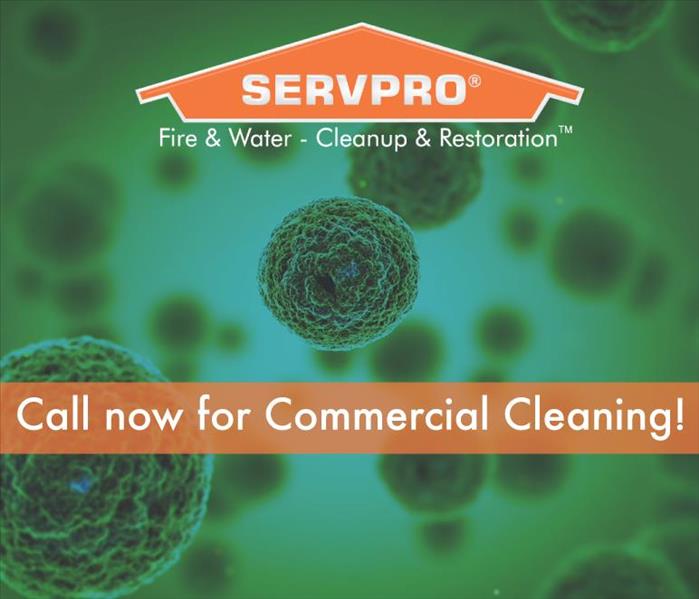 Call SERVPRO of Doylestown today to ensure you have a proper disease control prevention strategy.
Call SERVPRO of Doylestown today to ensure you have a proper disease control prevention strategy.
People all across the country are scrambling to ensure that their property is sanitary and protected with viruses going around. Business owners, homeowners, and parents all around the country are interested in taking steps to ensure that facilities are taking every precaution to prevent any widespread outbreaks. In this article, we will cover how viral strains spread, how you can protect yourself, and how SERVPRO of Doylestown can provide assistance with residential and commercial cleaning and disinfection.
How can I protect myself, my family, my employees, and my customers?
There are several things that can be done to protect yourself and others from a virus or outbreak. Most importantly, it is crucial to make sure you are washing your hands regularly, covering your mouth when you sneeze or cough, and ensuring that the meat and eggs you consume are fully cooked. It is also important to avoid close contact with people who might display symptoms of respiratory illness. It is important to schedule commercial cleaning to further prevent the spread of the virus on high touchpoints. Surfaces, toys, furniture, and doorknobs are several areas that often carry communicable diseases. It’s important to call on a professional that is trained & certified in biohazard remediation including the disinfecting of infectious disease. Surface cleaning is not enough these days, and unfortunately, the average consumer does not fully understand the products and the chemical components behind the product's intended usage. So many products we use and are familiar with are not used properly and thus get rendered ineffective which is not the case.
How can SERVPRO help during the viral outbreaks?
SERVPRO of Doylestown offers thorough cleaning and disinfection services for schools, hospitals, and commercial properties in Doylestown, PA, and surrounding areas. Our team is always ready to go with their PPE to ensure that your building and other buildings in our community are safe to enter. Our disinfectants & virucides are EPA, FDA, and OSHA compliant, they have a very low toxicity rating, and are effective against the most common disease and odor-causing organisms.
Call SERVPRO of Doylestown today to ensure you have a proper disease control prevention strategy moving forward to help support a healthy and safe atmosphere. We are available 24 hours a day, 7 days a week, 365 days a year.
What Property Damage Is Tax Deductible?
3/4/2020 (Permalink)
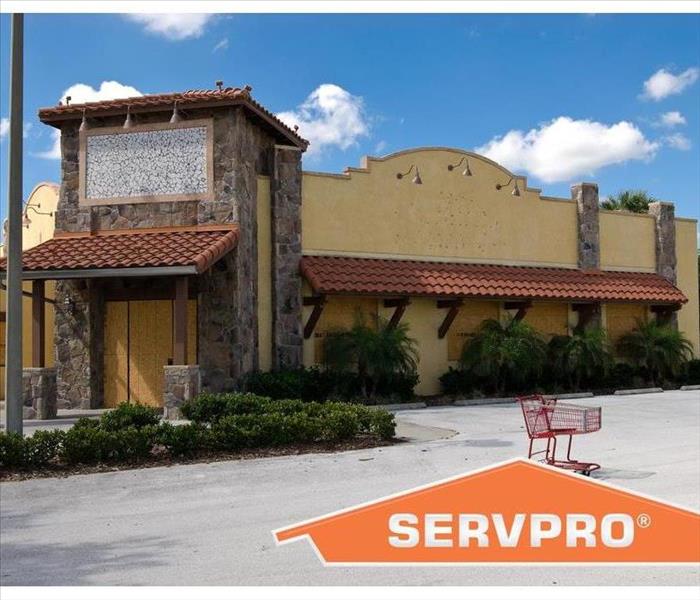 As a business owner, you should be prepared for all situations
As a business owner, you should be prepared for all situations
If you have sustained storm damage following a tornado, hurricane, or other severe weather event, you may qualify for tax deductions that can help you offset losses that aren’t covered by your insurance policy. Some insurance policies don’t cover all forms of property damage, such as losses due to floods. Other insurance policies may have a cap on the benefits they provide, which can leave you on the hook for the rest of the costs. In this situation, tax deductions can help you offset some of the costs of repairs.
Covering Losses From Natural Disasters
Some forms of property damage may be tax deductible. A few of the most prominent examples include:
- Earthquakes
- Floods
- Blizzards
- Tornadoes
- Hurricanes
- Wildfires
In contrast, losses that develop due to accidents and deterioration in Buckingham, PA, are not eligible for a deduction.
In addition, if your property is covered by an insurance policy, you cannot claim a tax deduction, even if you do not file a claim. Therefore, if your insurance company covers the cost of repairs, you should take the reimbursement allowed under your policy. Do not forgo this reimbursement in favor of the tax deduction. This is not allowed.
Claiming Deductions for Property Damage
If your insurance policy does not cover your property damage, you may be able to claim a tax deduction. This damage needs to be itemized. Additionally, the rules for claiming commercial storm damage are different from residential damage. In general, the guidelines are more lenient for commercial property destruction. For starters, there is no limit to what you can claim for commercial damage. Some of the most common deductions include the cost of commercial building restoration services, mold remediation, and water damage repair.
Planning Appropriately for Storms
As a business owner, you should be prepared for all situations. The first step may be creating a plan for how to deal with property damage in Buckingham, PA, that isn’t covered by your insurance policy.
3 Reasons To Board Up Your Home After a Fire
2/28/2020 (Permalink)
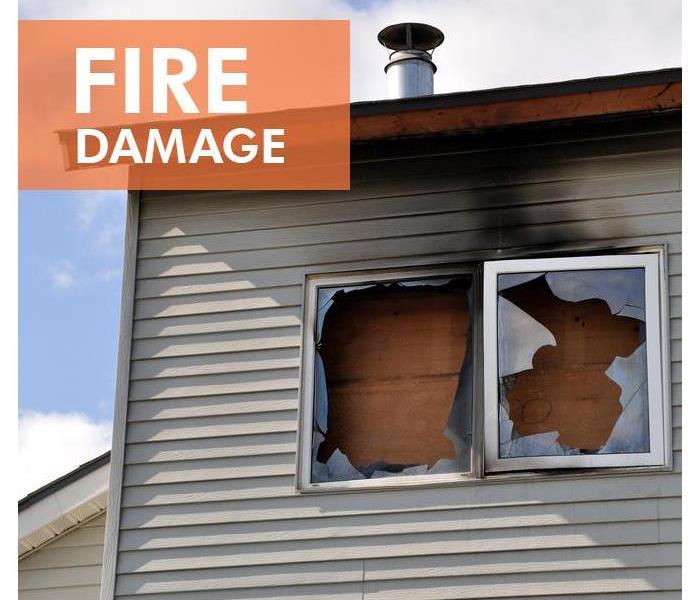 Board up to avoid more trouble
Board up to avoid more trouble
Three Reasons To Let The Specialists Help You
It's hard to see the soot and ash of the place you call home. Within minutes, you went from having a roof over your head to feeling at a loss for where to go and what to do. Before you head over to stay with family or friends, contact a fire restoration company in Chalfont, PA. Experts know how to handle your property. They can board up your home, offering you peace of mind. Here are three reasons to let the specialists help you.
1. It Keeps Out Intruders
As the fireman leaves, the restoration team can work on your emergency board up needs. The experts should assess vulnerable zones, particularly windows, the roof, and walls. Any sections with gaps or cracks should have something placed over them. If left open, animals could enter, seeking residence in your place. In addition, thieves may see this as an opportunity to look for belongings, sneaking inside and taking what they like; therefore, boarding up is the first step in post-fire security.
2. It Avoids Additional Damage
Your insurance agency most likely requires you to board up immediately, safeguarding the structure from further destruction. After all, the company wants to minimize the overall cost and prevent even more disaster. For example, should a storm come when the roof is exposed, rain could infiltrate through the burned shingles, saturating the ceiling and walls as well as ruining your valuables. Tarps would keep this from happening; thus, swift protective actions secure your insurance claim and avoid more headaches.
3. It Protects You From Lawsuit
When fire damage occurs, your land becomes easier to access. After all, you are likely staying elsewhere during construction, and cracks, holes, and tears simply scream easy access to both curious children and nosy adults. During their unwelcome exploration, someone could become hurt. If you haven't boarded up, you could be liable. Taking the steps to cover everything up and seal off the place is an extra step in guarding you from legal action.
Be proactive. You have enough to deal with now. Board up to avoid more trouble.
Tips for Filing a Fire Damage Claim
2/26/2020 (Permalink)
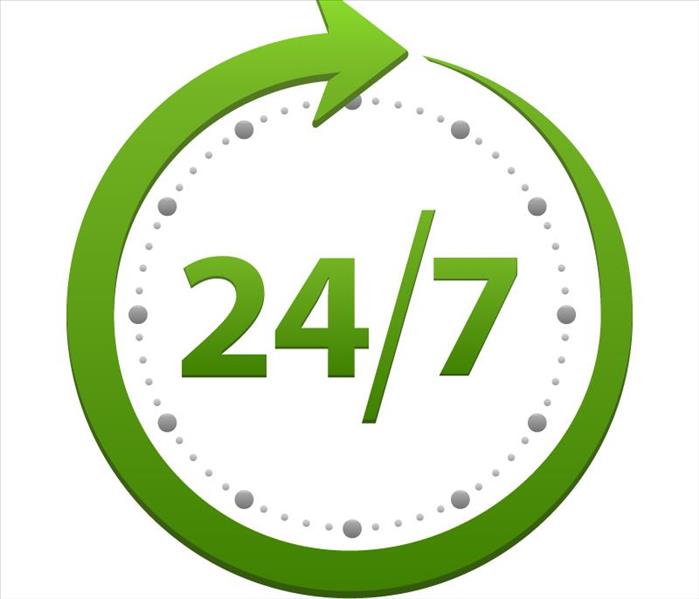 You can then focus on getting your business running again.
You can then focus on getting your business running again.
If a blaze destroys your Doylestown, PA, commercial building, you can file a fire claim with your insurance provider. Below are some tips for handling this process.
Contact the Insurance Company
Nowadays, there are several ways to contact your insurance provider. You can use the internet, a mobile app, or a traditional telephone. Tell the insurer where the fire was and provide both primary and backup contact information. You should then arrange to meet the adjuster at your building once it is safe to enter.
Photograph the Fire Damage
Avoid throwing out any items until the insurance adjuster has come to inspect your property. If you do have to discard some assets, be sure to take pictures of them to show them to the adjuster or upload online.
Don’t forget that your fire claim likely covers smoke damage, too. Photograph any belongings that have been harmed by soot or smoke, as well.
Secure Your Property
The last thing you want after a fire is for looters to come and steal your remaining belongings. Be sure to secure any broken roofs, windows or doors before the adjuster arrives. You can also make any temporary repairs that will limit additional fire or water damage.
Keep Track of Your Expenses
A commercial fire can be costly in several ways. Not only could you sustain harm to your property, but you may also have to temporarily run your business from a new location. You may also lose trucks or vans that you use to run your company. In addition, you might decide to hire a fire restoration company to assist with the cleanup. Be sure to document these expenses, as insurance money can help you pay for them.
By following the above steps, you can make the fire claim process go as smoothly as possible. You can then focus on getting your business running again.
4 Essential Components of a Fire Escape Plan
2/26/2020 (Permalink)
 A plan can only work if it clearly communicated and tested.
A plan can only work if it clearly communicated and tested.
Businesses in Doylestown, PA, know to protect their main asset—their employees— is a top priority. If a fire breaks out, fire damage professionals can get the physical structure back to working order. When it comes to employees, clients, vendors, and visitors, having a fire escape plan is essential to safety. Below are four key components every emergency escape plan should include.
1. Risk Assessment
Understand what kind of fire risks may affect your business. Even if your business operates out of an office, risks exist. A kitchen with a stove, space heaters or hot plates could all cause a fire. Older buildings could have faulty wiring unable to withstand the numerous devices plugged in.
A fire escape plan should clearly establish leaders to direct the evacuation and the other roles necessary to assist with the situation. Defined roles should include someone responsible for performing headcounts at a safe location and ensuring doors is closed, a person designated to sound the alarm and call 911, route guides to ensure a clear path, and monitors to check that every area is clear.
2. Plan Routes
Every plan should have a primary and secondary evacuation path. A map should be drawn up that shows both routes and posted throughout a facility. Additionally, a location should be designated as a safe place where everyone meets. Once at the safe location, have a plan in place to account for everyone’s safety.
3. Tool Use
Along with regularly testing fire alarms, sprinkler systems, extinguishers, and fire ladders, ensure employees know how to use them. Discuss other ways your team members can use everyday supplies to assist with a safe evacuation, such as using a chair to break a window.
4. Testing
A plan can only work if it clearly communicated and tested. Like students at school, going through a fire drill can help adults understand what an emergency situation may look like and help keep the evacuation more calm and smooth.
While hopefully your business never has to enact a fire escape plan, having one in place is vital for everyone’s safety.
Dealing with Black Water After a Flood in Your Building
2/21/2020 (Permalink)
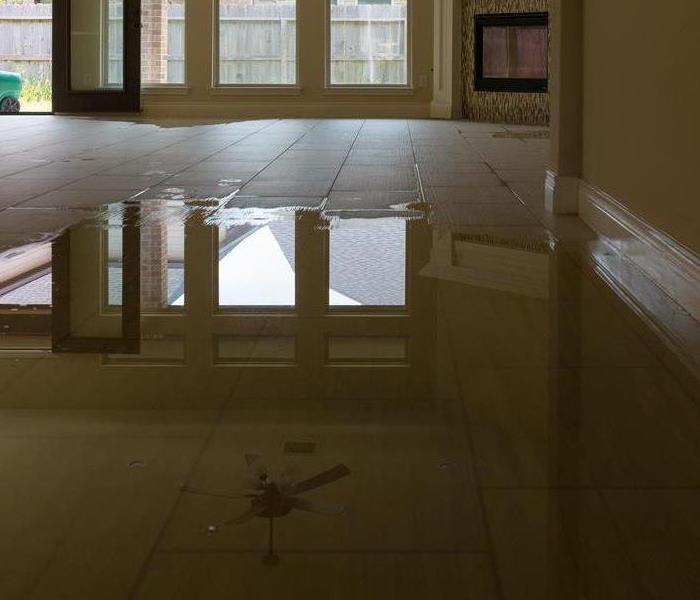 Get the help necessary to ensure a healthy restoration and you can be up and running again.
Get the help necessary to ensure a healthy restoration and you can be up and running again.
When you have water damage in your commercial building in Doylestown, PA, due to a storm flood or sewer backup, you have to be especially careful due to the possibility of contamination. Black water is among the most serious flood cleanup to deal with. It carries with it a greater need for proper cleaning and more serious risks.
What is in Black Water
Water that comes in from storm flooding or a sewer problem carries contaminants that can cause great harm and poses health risks. Anything it touches is considered as having storm damage. Here are a few of the possible threats contained in black water.
Raw Sewage and anything that may have been flushed down a toilet
Cysts
Bacteria
Industrial chemicals and fertilizers
Toxins
Black Water Cleanup
Clearly, there is no place for any of these elements inside your building. You should make sure all employees, customers, and others stay well away from the water damage. Rubber boots and special suits and gloves must be worn during storm cleanup to prevent the spread of contamination. That is why it is necessary for a water remediation and flood damage company to undertake the cleanup.
Industrial cleaners and disinfectants must be used and any porous materials, such as carpet or furnishings will likely need to be discarded.
Non-porous surfaces may be cleaned and disinfected even with flood damage, and possibly reused. Building materials such as sheetrock will likely need to be torn out and replaced. Wooden studs will need to be evaluated and may either be cleaned or may need to be torn out. Regardless of the contamination factor, the subfloor will need to be replaced.
Water damage is hard enough to deal with, even when it is a clean water flood, but when it comes from dirty water, care should be taken with the storm cleanup to ensure it is clean and disinfected. Get the help necessary to ensure a healthy restoration and you can be up and running again.
How Is an Estimate Developed Following Fire Damage?
2/18/2020 (Permalink)
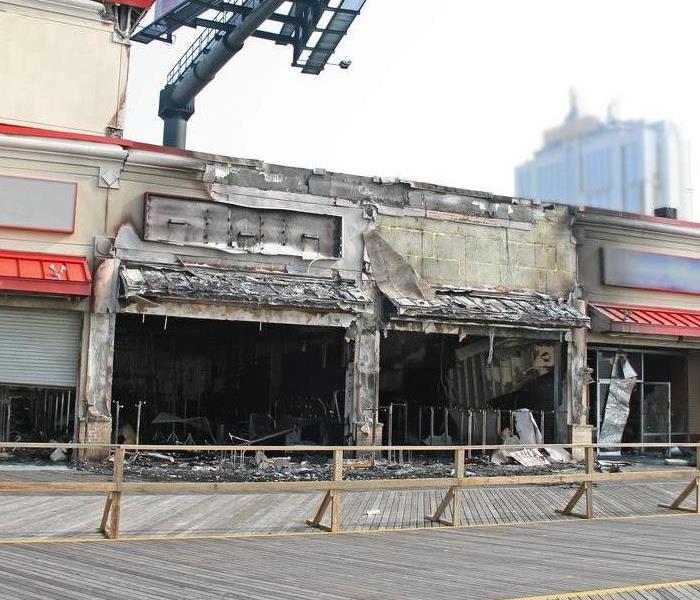 When it's time to get an estimate for fire damage cleanup costs, remember there are many factors involved.
When it's time to get an estimate for fire damage cleanup costs, remember there are many factors involved.
The cost of rebuilding and full recovery is one of your main concerns after a fire burns through your commercial property. After the emergency personnel leave and before Doylestown, PA, fire damage cleanup professionals arrive, you should have some idea of what to expect as an estimate is developed:
Several Factors Are Considered
The estimate you receive covers much more than cleaning up and new construction. The figure should also include the costs related to
Board up and security services such as tarping and temporary fencing
Live security guard on-site, if necessary
Content storage and removal of debris
Risks associated with hazardous chemicals or substances you have on-site
Depending on your business practices, there may be other elements to consider.
Several Professionals May Be Involved
Representatives from the fire department may visit the site of the commercial fire from time to time to make sure there aren't any new flareups. An inspector from your insurance company may also want to assess damages. If you've hired a third-party to assess damages, representatives from that firm will need to walk through your property. Of course, technicians from the fire and smoke damage cleanup company will also complete a thorough evaluation.
Lowball Quotes May Be Given
It isn't uncommon for some companies to give you a really low quote. When this happens, move on to a different contractor. Those low compilations of costs are just the beginning, and you're likely to be charged with several additional costs as the work progresses. This is a common occurrence when the contractor you hire subcontracts portions of the work.
Services May Be Covered by Your Insurance
In fact, some insurance companies prefer that you work with professional cleanup and restoration contractors. Contact your insurance agent to find out if there's a preferred company to contact for fire and water damage repairs.
When it's time to get an estimate for fire damage cleanup costs, remember there are many factors involved, several professionals may show up, avoid contractors with lowball quotes, and check with your insurance company. Be confident that you're getting great services by understanding how the estimation process works.
Caring for Wet Valuables After Water Damage
2/18/2020 (Permalink)
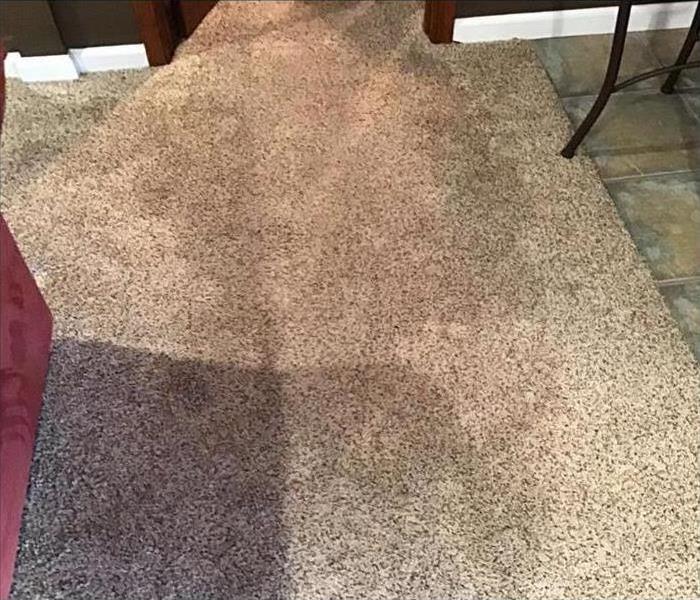 Wet carpet on a Chalfont, PA home
Wet carpet on a Chalfont, PA home
If your home in Chalfont, PA has sustained water damage from flooding or perhaps a broken pipe, you will need to replace the flooring and maybe even furniture and drywall. But what about those irreplaceable family heirlooms and other valuables? Water in your home can be devastating, but there are some great tips to help you restore the items you thought were lost.
Tips to Save Valuables
Rinse each object with clear water. Make sure to remove any dirt or other debris using a damp washcloth or soft-bristle brush, being careful not to rub the dirt into your valuable item. Many cloth items can be restored with dry cleaning. Consult with your neighborhood dry cleaner to make sure.
Water in your home increases humidity that can wreak havoc on your valuables. Reduce the humidity using fans and dehumidifiers. Open the windows, if the weather permits, to air-dry each valuable. This will help to prevent mold from growing.
Books and photos can easily tear when wet, so be careful when handling them. Any photos in frames should be loosened carefully at the edges to allow them to dry successfully. Putting books in the fridge or the freezer can help them dry while retaining their shape.
If an item has been broken, it is a good idea to wait until all of the pieces have completely dried before you try to glue them back together. Keep all of the pieces in an open container to allow the air to dry them out faster.
Any metal valuables contaminated with mud or silt should be rinsed carefully with clean water and then dried using a soft cloth.
Wet paintings should be removed from the frame. Always air-dry paintings facing up and keep them out of the sun.
Following a few simple steps can save your family's valuable heirlooms from being damaged by water in your home.
Things to Avoid After Significant Flooding
2/15/2020 (Permalink)
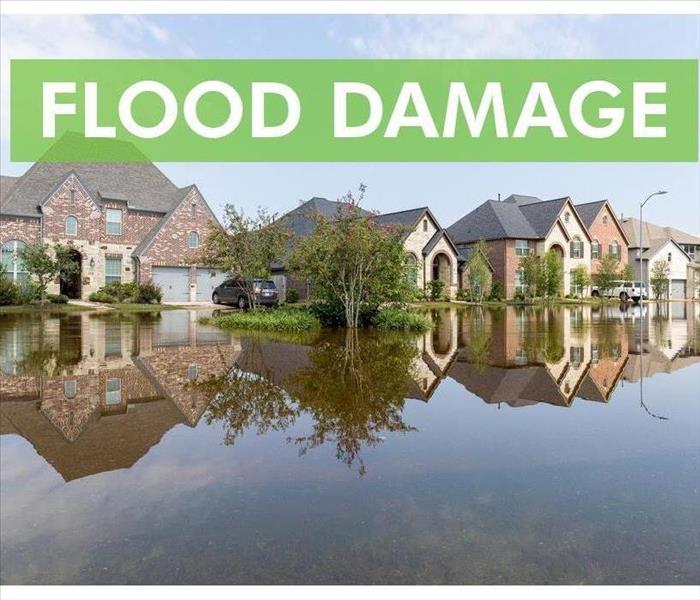 Professional mitigation and restoration companies are ready and willing to help return your home to normal.
Professional mitigation and restoration companies are ready and willing to help return your home to normal.
Whether flooding is caused by a broken pipe or a backed-up sewer, you must take certain precautions before entering the affected area. The potential risks are likely the reason that most insurers and homeowners prefer professional mitigation companies in Doylestown, PA, perform the property assessment, walk-through and cleanup. However, if you insist on entering the affected space, then there are a few things you should know to avoid.
Standing water
Electricity
Disturbances
Standing Water
Standing water in home can come from a variety of sources, and not all of them are sanitary or safe for you to touch. For example, while away on vacation, it is possible that your sewer backed-up into your basement. This water is considered black water, and it should be avoided at all costs. However, even water that stems from a clean source can become contaminated if left to stand for some time.
Electricity
Next, while you might have noticed a broken pipe soon after the break and stopped the water before flooding was too bad, you don't know if electrical outlets, appliances or plugs were compromised. Therefore, before you walk into a flooded area, make sure that the power to that space is turned off. If you cannot reach the breaker box to turn the power off safely, then wait for a professional to assist you.
Disturbances
Flooding and floodwater might stem from contaminated sources or evolve into such sources themselves. Therefore, it is necessary to reduce the number of surface disturbances of the water. Harmful bacteria can transfer from the water to the air and the skin if not careful. Also, reduce movement of objects that might be contaminated with mold, as slight movement can cause mold spores to spread.
A broken pipe or backed-up sewer can lead to extensive in-home flooding. While the initial damage might seem manageable, know that there are things you should avoid. Professional mitigation and restoration companies are ready and willing to help return your home to normal.
4 Steps to Take When Filing a Water Damage Claim
2/15/2020 (Permalink)
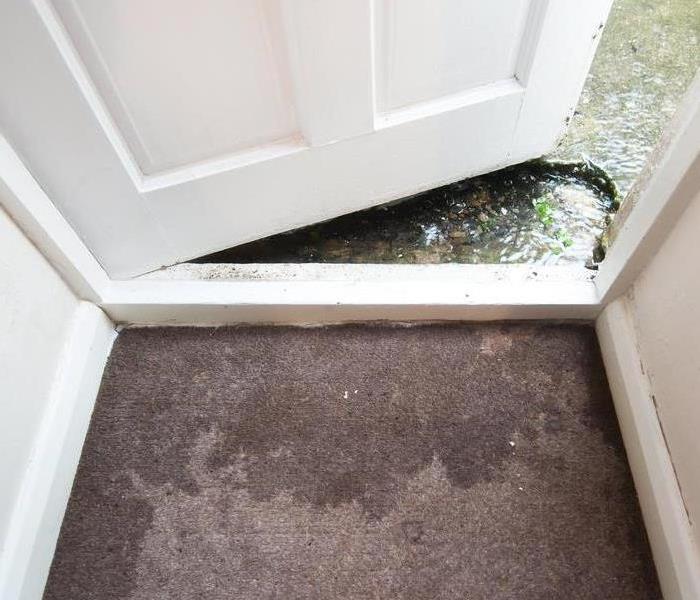 When damage occurs, you should always start filing your insurance claim as soon as possible.
When damage occurs, you should always start filing your insurance claim as soon as possible.
If something has caused water damage to your Doylestown, PA, home, then it is a good idea to start filing an insurance claim right away. If you have never had to do this before, you might not know exactly where to start or what you should be doing during the process. If this is the case, you should take the following steps.
1. Call Your Insurance Agent
Of course, the first thing you should do is call your insurance company to report the damage. The sooner you do this, the sooner the insurance claim process can be finished. Many companies require you to contact them within a certain period after the damage has occurred, and if you fail to do this, your claim can be denied.
2. Review Your Policy
If it has been a while since you purchased your insurance policy, the details might be a little fuzzy. While you are waiting for an adjuster to arrive, it is a good idea to read over it. Familiarize yourself with the requirements and terms to help the process move along more smoothly.
3. Document the Damage
Something else you might want to do while waiting is to begin documenting any damage that has occurred. Take pictures of damaged belongings and areas of the house, and make a list of everything that has been affected. Your adjuster can use this while filing your claim. If a pipe bursts, make sure to document this as well.
4. Begin Mitigation
Whether it is from a flood, damaged plumbing or something else, water should not be left in your home for an extended period. Building materials can absorb the water and begin to rot or warp, and the moisture can cause mold to grow. Remove the water from the building and move items to a dry location.
When damage occurs, you should always start filing your insurance claim as soon as possible. You will likely need to hire a cleanup and restoration service to make repairs on the house, and the money you receive can help you pay the costs.
How To Unclog and Maintain Your Pipes
2/9/2020 (Permalink)
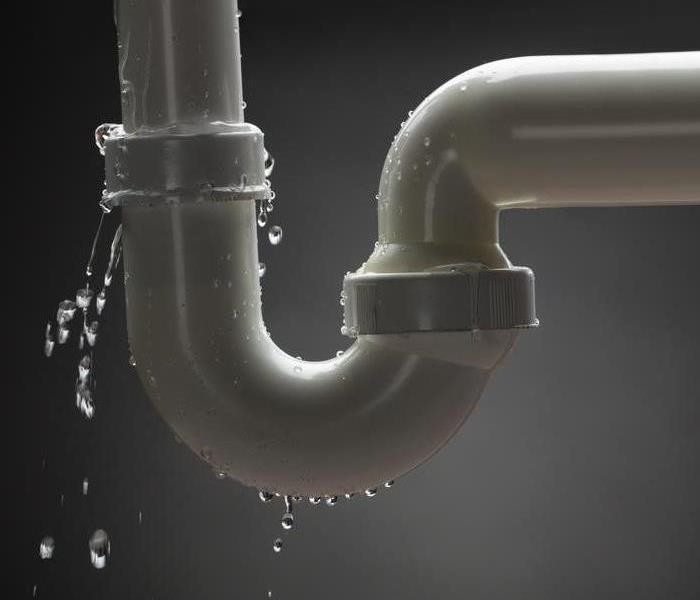 If ignored, a clogged pipe can lead to a major disaster in your home. Luckily, the issue can be resolved fairly easily.
If ignored, a clogged pipe can lead to a major disaster in your home. Luckily, the issue can be resolved fairly easily.
A clogged drain doesn’t just slow down or stop the flow of water in your Doylestown, PA, home. It can also lead to a buildup of water pressure within the pipes. This, in turn, can cause the pipes to rupture.
Water damage repair specialists can help in this situation. However, if you want to avoid pipe break entirely, you can use a snake to clear a clog. Below is a quick tutorial.
How To Fix a Clog in 3 Steps
Push the End of the Snake Into the Drain
Turn the handle of the drum as you push the auger into the stopped drain. Continue this cranking process until you meet resistance.
Rotate the Snake
When you rotate the snake, it should either chop up or entangle the clog. If that doesn’t work, try pulling the snake out of the drain to see if the clog comes with it.
Run Water Through the Drain
To make sure the clogged drain is fixed, try running the water at its maximum force. This should push any remnants of the clog through the pipes.
Preventing Clogs
If you want to avoid having to unclog pipes in the future, there are some simple preventative measures you can take. Kitchen pipes are a frequent source of clogs due to food or garbage going down the drain. A sink strainer can capture these foreign objects, allowing you to dispose of them appropriately.
Ideally, your garbage disposal should help you eliminate kitchen waste without clogging up your pipes. While the disposal is eating up your trash, turn on the sink and let the cold water flow into the disposal. Keep the water running for another minute after the disposal turns off. This will guide the trash to the main drainpipe, where it is less likely to cause a clog.
If ignored, a clogged pipe can lead to a major disaster in your home. Luckily, the issue can be resolved fairly easily.
The Main Steps of the Water Restoration Process After an Interior Flood
2/3/2020 (Permalink)
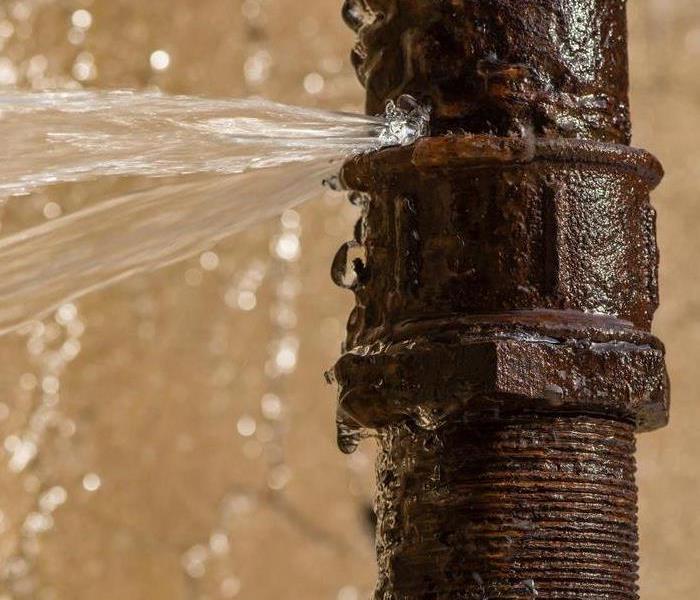 A pipe burst or sewer backup is devastating for any homeowner.
A pipe burst or sewer backup is devastating for any homeowner.
A pipe burst or sewage backup is two in-home disasters that almost every homeowner dreads. Depending on the extent of the damage, a water damage restoration company in Doylestown, PA, need to be called as well as your insurer. One thing that can help a frustrated homeowner through the flood recovery process is to know and be aware of the remediation steps.
Removal of excess water
Discarding of debris
Drying the space
Disinfecting and cleaning the area
Restoring to pre-flood conditions
Removal of Excess Water
A busted water line can quickly develop into a full-blown flood, especially if you are away on vacation when the break occurs. The first goal, then, of any remediation company is to stop the source of the flooding and remove the excess water. They will accomplish this task by using water pumps and shop-vacs.
Discarding of Debris
Once the flooding is controlled and the water removed, the company will begin removing debris and personal items from the space. In most instances, these items will be brought to a dry location where the family will be allowed to sort through things. However, in cases of sewer backups, that might not be the case as items are too contaminated to salvage.
Drying the Space
After every that was damaged by the pipe burst is removed, the crew will begin drying out the affected area. They will most likely use a combination of fans, dehumidifiers and air movers to speed the process along.
Disinfecting and Cleaning the Area
When the area has had time to thoroughly dry, the remediation service will use commercial cleaners and disinfectants to clean and sanitize all surfaces. Wall cavities that have been stripped of insulation and drywall will probably be soaked in a bleach solution to reduce the risk of mold.
Restoring to Pre-Flood Conditions
Finally, when all the removal and cleaning is finished, the team will begin the restoration process. The goal of any restoration is to restore a property to pre-flood conditions.
A pipe burst or sewer backup is devastating for any homeowner. However, with the assistance of a trained group of professionals, the process is both manageable and recoverable.
Everything You Need To Know About Category 2 Water Damage
1/31/2020 (Permalink)
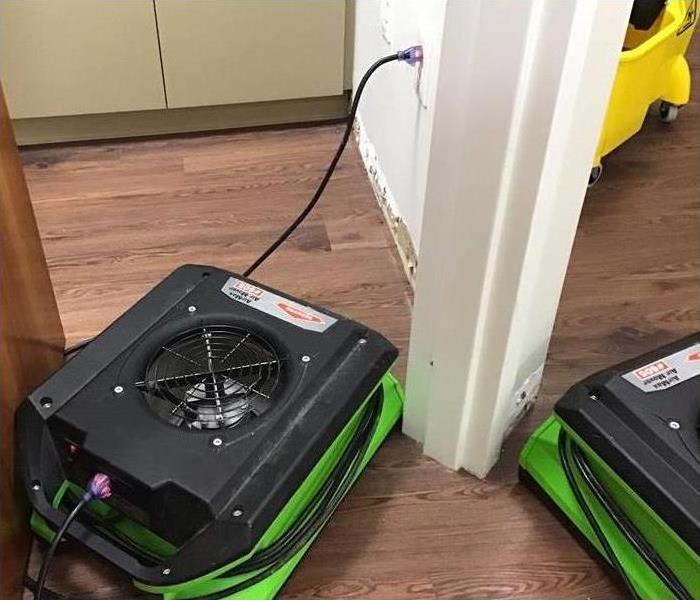 Water damage in Chalfont, PA
Water damage in Chalfont, PA
When a commercial remediation company is working with your business after water pipe repair, its specialists may use terminology that can help them better identify the damage. One of these measures includes classifying the water into three different categories. Depending on the circumstances, they may refer to your situation as Category 2 Water Damage. You can assist these professionals by learning more about these classifications.
What Is Category 2 Water?
Unlike Category 1 water damage, which is caused by pure water with no known pollutants, Category 2 damage is caused by water that contains a certain amount of bacteria, chemicals or other contamination. Consumption or exposure to this water can lead to a range of symptoms, from discomfort to mild illness. As a result, remediation workers use special clothing and protective gear when navigating areas flooded with Category 2 water.
Where Does It Comes From?
Category 2 water can have multiple sources. These locations often pollute what could have been pure water into grey water.
- Toilet water with no feces
- A broken pipe
- Laundry machines and dishwashers
- Sump pump failure
- Clean, but standing water
- Leakage from upper floors
Remember that even after water pipe repair, the standing water is still contaminated by contact with these sources, so different protective methods from Category 1 must be used. At the same time, it does not contain highly toxic pathogens from sources such as dirt and raw sewage, which is considered Category 3 water.
How Is Category 2 Water Treated?
When remediation specialists arrive to your Chalfont, PA, location, they will generally use protective equipment to avoid direct contact. They will disable safety hazards and work with plumbers to stop the source. Afterwards, they will remove water with vacuums and other powerful drying tools. Depending on the damage, items will either be disposed or decontaminated with antibacterial products and dried.
While Category 2 damage is nowhere as serious as Category 3, it can still endanger your property and your business. Consider learning about this loss and summon professional assistance after a commercial water pipe repair.
Why Are the Pipes in My Home Noisy?
1/29/2020 (Permalink)
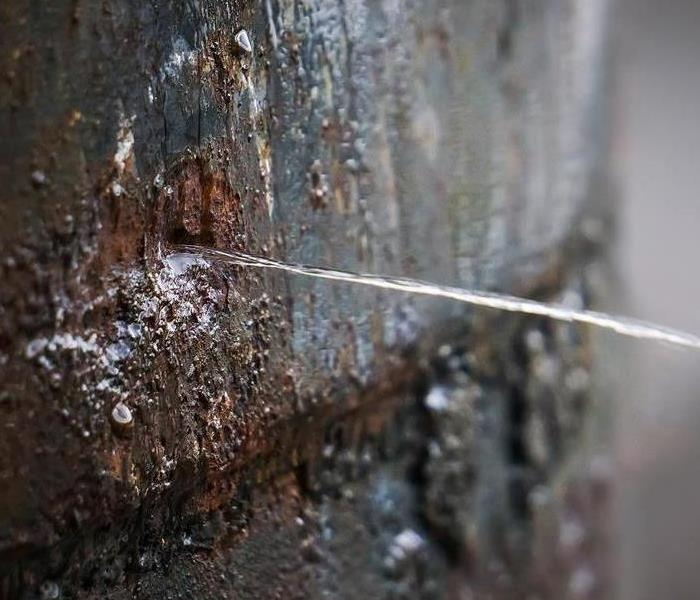 Strange noises in the plumbing of your home could be a clue that major issues are developing.
Strange noises in the plumbing of your home could be a clue that major issues are developing.
Have you noticed a loud rumbling noise or other strange sounds every time you turn on the kitchen or bathroom faucet? Not only could this be annoying, but it could be the sign of an upcoming pipe break or other significant plumbing problems in your Doylestown, PA, house. You can fix some of these issues on your own, while others may require the help of an experienced plumber. Understanding what causes these noises can help you identify the culprit and help you know how to repair it.
Water Hammer
Perhaps the most common, this noise occurs because there is too much water pressure in the pipes, which could eventually result in having to fix a broken pipe. The water will search for somewhere to go and will bang against the pipes or shut-off valve. You will not hear this sound constantly--only when the faucet it on. You can resolve it by doing the following:
Turning off the home's main water source
Resetting the system's air chambers
Opening all faucets to let all water out
Turning the water back on
Vibrating Pipes
Another high-pressure problem can cause a vibrating or thrumming sound in the pipes. This may occur simply because the pressure is above 80 pounds per square inch. You can test the water pressure in your home by calling a plumber or purchasing a threaded pressure gauge. If you don't address this noise, you could be dealing with a pipe break.
Whistling Pipes
Excessive mineral buildup in the pipes could cause this noise. Other reasons could be a worn-out mainline pressure valve or a deficient pressure regulator. Rather than face the prospects of a pipe burst, call a professional water damage cleanup team to inspect your water system.
Strange noises in the plumbing of your home could be a clue that major issues are developing. Before it's too late, follow these guidelines so you can address the matter before it gets too severe.
How a Fire Restoration Company Keeps Your Commercial Property Safe After a Fire
1/27/2020 (Permalink)
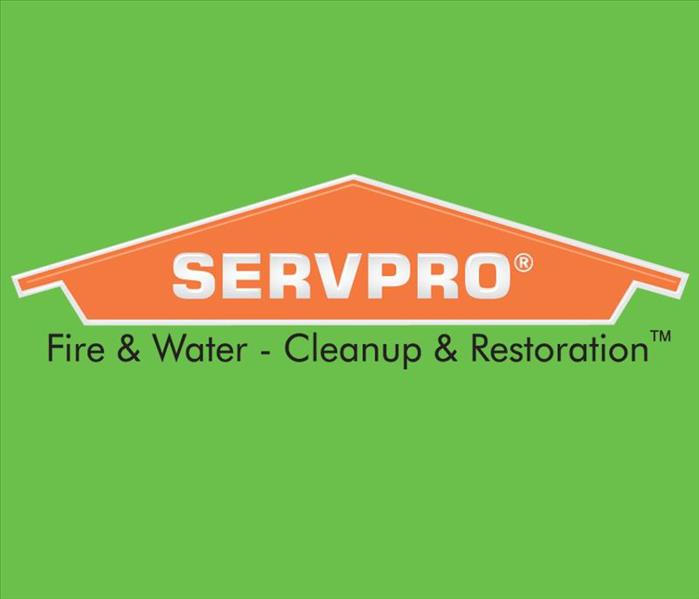 f your building was damaged in a fire, or if you are just trying to stay prepared, contact a local restoration company, and discuss your situation.
f your building was damaged in a fire, or if you are just trying to stay prepared, contact a local restoration company, and discuss your situation.
Fire restoration companies in Doylestown, PA are more than just fire cleanup specialist. While removing fire damage and restoring your commercial property to predisaster condition is their objective, they are also focused on protecting your property and your insurance claim. There are at least three services that these companies offer to ensure that your property is protected during the remediation process.
Board up and tarp services
Fencing
Security
Board Up and Tarp Services
Weather damage and looting are both potential concerns for property owners. When fires happen, especially substantial fires, your building can be left with several holes and vulnerabilities. Therefore, a restoration company should be one of your first calls after the fire is put out. They will arrive on the scene quickly and can begin boarding up doors, windows and other holes in the structure to prevent vagrants and animals from entering the premises. Also, they can put tarps over the roofline to prevent any further water damage from the weather.
Fencing
Next, if fire damage has left your property particularly vulnerable, then most companies will offer to fence off your property. The fencing is temporary and can usually be put up within a day, depending on the size of the property. Fences provide an extra deterrent to unwanted trespassers.
Security
Lastly, some mitigation companies will provide security guards or cameras for a fee. Cameras may be placed around the perimeter of your property, and guards will likely be set at main entry points, walking the property occasionally to ensure no one has entered without permission.
Fire damage is a hassle, and business owners are right to worry about further loss or damage to their property after such a disaster. However, with fast action, a property owner can have a restoration company on the premises, quickly securing the area and protecting the future insurance claim. If your building was damaged in a fire, or if you are just trying to stay prepared, contact a local restoration company, and discuss your situation.
3 Tips for Troubleshooting a Slow Drain
1/25/2020 (Permalink)
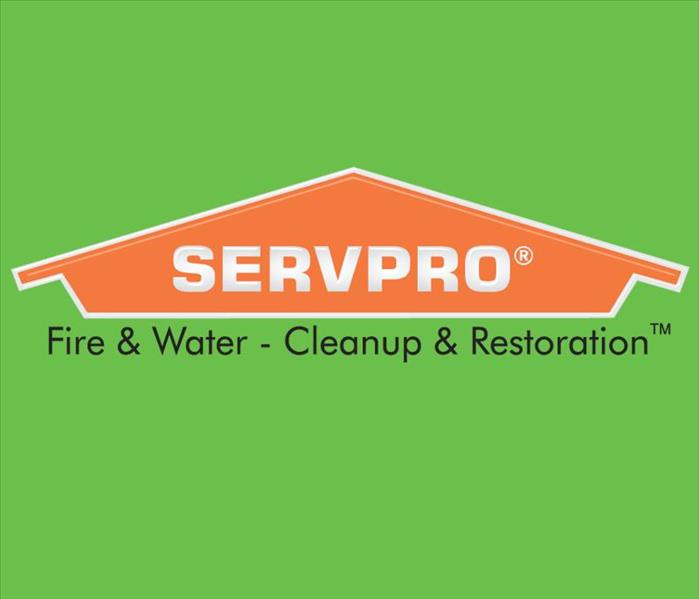 Most of the time, a clogged drain can be a simple repair you can do yourself.
Most of the time, a clogged drain can be a simple repair you can do yourself.
A clogged drain can be an inconvenience, particularly if it is in a busy area such as a public restroom or the break room. If left unchecked, it can develop into a larger problem that ultimately requires sewage cleanup experts to remedy. Here are three ways you can troubleshoot a slow drain.
1. Clean Drain Stopper
If it seems like a little water is getting through, you may be able to fix the problem by just cleaning the gunk out around the drain stopper. The stopper is the first line of defense against a clog, as it blocks larger debris from getting down the drain. Regularly cleaning helps you clear out the smaller particles that build up and keep water from getting down the pipes. In addition to the stopper, you may consider a strainer for drains in areas where items other than soap and water are likely to enter the sink, such as the kitchen or break room. This can prevent clogs as well.
2. Use a Plunger
When cleaning the stopper doesn't work, the clogged drain may need a little extra help. A plunger forces air through the pipe, pushing out tougher clogs so that water can drain more freely. Keep any area in your building in Doylestown, PA, that has a sink stocked with a plunger so that you can access it easily when you need it.
3. Pour Unclogging Agents
Depending on the nature of the clog, there may be cleaners that can help you unclog a slow drain. If you suspect the clog is a buildup of grease, hot water, and a little dish detergent may do the trick. If the clog is more likely to be skin cells or hair, or if you are uncertain about what is causing the clog, try using an industrial drain cleaner. If this doesn't solve the problem, you may need a plumber to assess and take care of the issue.
Most of the time, a clogged drain can be a simple repair you can do yourself. For more serious problems, you are better off calling a professional to help.
24 Hour Restoration Services
1/22/2020 (Permalink)
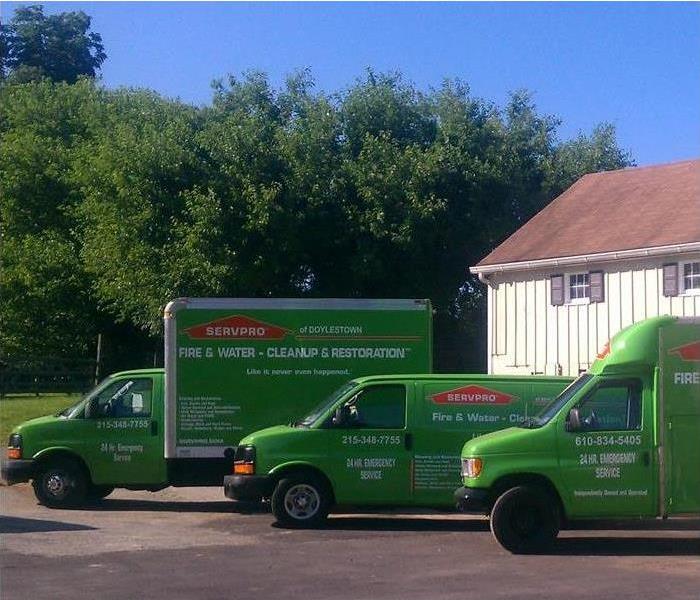 SERVPRO of Doylestown will make fire, smoke, soot, water or mold disasters "Like it never even happened".
SERVPRO of Doylestown will make fire, smoke, soot, water or mold disasters "Like it never even happened".
24 Hour Restoration Services
A 24-hour restoration company can save you significant heartache and money. The sooner you get someone onsite, the less time water and other elements have to damage your structure. If you have experienced a disaster in Chalfont, PA, you can decrease the time it takes to return your business to normal by working with a responsive and professional restoration company. Speed is critical when dealing with water damage.
1. Almost Immediately When water invades an area, it does not stop until the source of the problem is fixed. As it leaks, it saturates everything it encounters. Soaked paper items and furniture may begin to bleed. If dyes are released from these items, they can spread through the water and stain other areas.
2. Within the First Day As the water continues to sit, drywall and furniture can begin to crack or swell. A musty odor may appear and metal surfaces could start to tarnish. A company with a fast response time may be able to stop the water from spreading and begin the drying process the very same day.
3. After Two Days In as little as 48 hours, mold may begin to grow and spread. At this point, the water is usually considered hazardous and unsafe to enter. Furniture, doors, and windows could begin to warp. By working with a 24-hour restoration service, you may be able to stop the process before mold ever has a chance to develop.
4. After a Week If water is left to sit inside a property for a week or more, it can pose extra hazards and it becomes likely that the whole area will need to be decontaminated. At this time, additional damage will have occurred and the chance of structural rebuilding is increased.
To minimize damage, you need to work with a 24-hour remediation company that is always open. They are trained to use advanced technology and are experts at responding to emergencies and restoring properties.
3 Reasons Your Water Heater May Make Noise
1/20/2020 (Permalink)
 There are a number of reasons that your water heater may be making noise.
There are a number of reasons that your water heater may be making noise.
A homeowner in Doylestown, PA, with a water heater might notice the occasional noise coming from the heater itself. Some noises are normal in the course of use, while others may indicate a problem. Here are three of the most common reasons such a heater may be making noise.
1. Sediment Collecting
It’s possible that sediment can gather in your heater and collect around the heating element. This can often result in a crackling, rumbling or popping sound. This is more likely to occur with older units but can be fixed with a water heater flush. This process involves draining the water tank and rinsing it with water until all the sediment has been removed. If you notice damage to the heater during this process, it’s best to have it repaired or replaced. Water damage from a tank leak can be handled by a water damage restoration service.
2. Valve Closed Partially
When a valve is partially closed on the water heater, you may hear a screeching sound. When the water is forced through a small opening, these sounds can occur. If the valves on the heater are fully open, you may also want to check the valves on the faucets in your home.
3. Water Heating the Pipes
Hot water travels through the pipes and causes them to expand. If the water is suddenly turned off, the pipes may shift and create a knocking or hammering sound. There are wall hammer arrestors, which are fittings that can help correct this problem when they are installed in the connection between the tank and the pipes in question.
There are a number of reasons that your water heater may be making noise. They can range from sediment in the tank to a loose heating element or just general sounds of the pipes as they expand with hot water. Most of these sounds can be managed with regular maintenance. If you do notice damage, it’s best to contact a professional.
How To Remove Mold From Air Conditioner Ducts
1/8/2020 (Permalink)
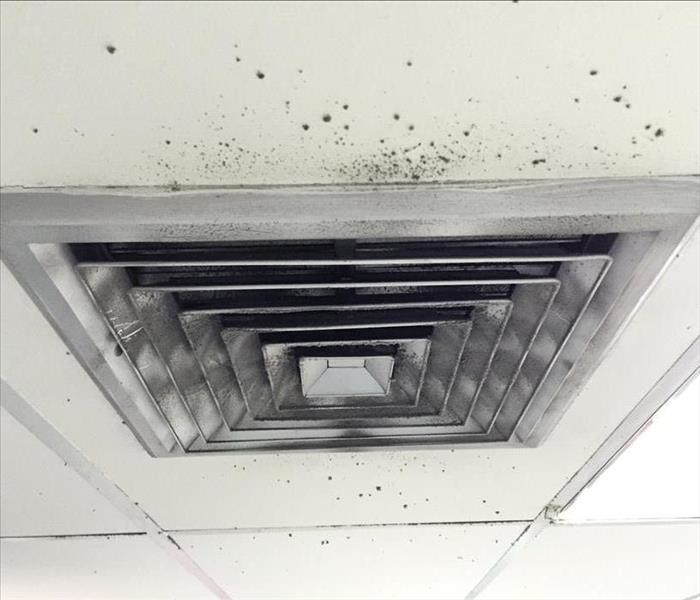 Dust that accumulates in your air ducts can lead to microbial growth
Dust that accumulates in your air ducts can lead to microbial growth
How To Remove Mold From Air Conditioner Ducts
If you believe your building in New Briton, PA, has black mold circulating in the ventilation system, it is important to have the situation assessed as quickly as possible. Left unchecked, mold spores may continue to spread and the problem could get worse. Luckily, by working with a professional mold remediation company, the air inside your building can be restored. There are several steps to take if you suspect mold.
1. Look for Clues
There are clues to look for that can signify a mold problem. If you notice a musky smell or experience allergy-like symptoms while inside, it could indicate that mold is circulating within your air ducts. You can also check the walls near vents for a black substance. If it is mold, it will not easily wipe away.
2. Inspect the Area
If you found any of the warning signs of black mold, you should have the area assessed by a certified mold inspector. They have the tools and skills necessary to check the inside of the ductwork. If mold is found, they will determine the extent of the problem by checking inside insulation and other materials.
3. Clean and Disinfect
Clean ducts may require that the mold spores be eradicated. Special killing agents and disinfectants will likely be applied as part of this process.
4. Remove the Source of the Problem
The source of the problem must be identified and removed. If left unchecked, more mold spores may be released, which could cause the mold to get back into the ventilation system.
Returning your business to normal after identifying a black mold problem involves more than just cleaning the areas you can see. It could be circulating within the vents and spreading spores throughout the building. By working with a professional mold remediation service, you can benefit from their expertise and special equipment that can rid your building of its mold problem.
Restoring Office Contents After a Fire
12/29/2019 (Permalink)
 Cleaning electronic after fire
Cleaning electronic after fire
Restoring Office Contents After a Fire
After a fire at a Buckingham, PA, business it may be necessary to restore multiple office items. Fortunately, a local fire damage restoration service has the resources and knowledge to salvage various types of items with processes such as dry-cleaning. Repaired items can then be moved to content storage until any building repairs are complete. Here are a few item types that may need repairs, and what you can expect to see in that process.
1. Electronics
One of the hardest aspects of content cleaning is determining what to do with any damaged electronics. Fortunately, many restoration services include professionals will have the tools necessary to make these types of repairs. In the event that a device such as a computer can not be repaired, these professionals may still be able to save the data.
2. Cloth Items
In many cases cloth items, such as chairs, curtains, carpeting, and curtains will hang onto residual smoke odor. Fortunately, these items can be cleaned with special solutions. Some items can be washed while others will need to go through a dry-cleaning process. This will depend on the item type and fabric material.
3. Hard Items
In most cases small hard items can be submerged in a cleaner if they are neither mechanical or electronic in nature. Large items will need to be washed with a cleaner instead, while electronics should be sent to a professional. For solid surface mechanical items it’s best to consult a professional for cleaning recommendations. In some cases a spray on and wipe off solution will be used instead.
Electronics will need to be handled carefully by a professional with special tools, while upholstery may require dry-cleaning, depending on the cloth type. Hard items can be wiped off with a solution. Once cleaned these items should be stored elsewhere until any building repairs are finished. If you have any questions a professional can help.
Preparing Your Company Property for a Storm
12/23/2019 (Permalink)
 Building in Chalfont, PA
Building in Chalfont, PA
Preparing Your Company Property for a Storm
Owning a business in Chalfont, PA means you may have to deal with the possibility of storm damage resulting in the need for exterior maintenance on the property. Fortunately, preparing for the inclement weather beforehand may help you avoid costly damages. Here are a few tips you may want to consider.
1. Know the Weather
Knowing the weather in your area is one of the first steps to protecting your company property. If you’re aware a storm may be coming, you can begin making preparations beforehand. This will allow you the time you may need to make a building inspection, as well as perform any repair jobs that may be required.
2. Inspect the Property
Inspecting the property should be a regular part of your company's exterior maintenance routine. This way, if you know there is a potential for certain types of problems, you can stay up-to-date on the building's upkeep. Keep an eye out for overhanging tree branches, clogged gutters, cracks in any siding, and weathering on the roof. It may be helpful to make a list of any problems you find so that they can be handled quickly before a storm arrives.
3. Take Mitigation Steps
If the property does suffer storm damage, it’s best to contact a storm damage restoration service. However, keeping the building maintained may help you avoid worse damage. During the inspection, take note of any repairs that may be needed, and have these done as soon as possible. This may include cleaning gutters to prevent water back-flow, trimming dead branches so that they don’t fall, and fixing any windows that may leak. If you don’t have time to make repairs before a storm, consider tarping or boarding over the affected area to prevent further damage.
Keeping up with your company building’s exterior maintenance may also help you stay ahead of the storm. Stay aware of any approaching storms, look over the property before the storm arrives, and make any repairs you may need quickly. Remember, if the company building does suffer storm damage, a restoration professional may be able to help.
Ideal Mold Growth Conditions
1/24/2019 (Permalink)
Although we all hate to admit it, we all have found mold in our showers or on our shower curtain at least once in our life. You may wonder what are the exact conditions that mold needs to grow? Here are the 4 critical requirements mold needs to grow.
What are mold spores? Mold spores are the very tiny reproductive units of mold and fungi and vary in size from 3 to 40 microns. These mold spores are everywhere, both inside buildings and outside as well and it is perfectly normal! That is why there is no true way to eliminate these.
What does mold feed on? Basically any organic substance can be a food source as they contain carbon molecules. The most popular mold food in homes are wood, paper and organic fibers.
Unfortunately for us humans, mold prefers the same temperatures we do! This means that mold growth can occur in many places in a building, even the fridge!
Many of us know mold thrives in moist areas, preferable in places with a relative humidity of 70%. Areas in homes where water can gather or pool will provide an even better place for mold growth.
Content by: http://www.fsec.ucf.edu/en/consumer/buildings/basics/moldgrowth.htm
Pet Fire Safety
1/24/2019 (Permalink)
Prevent Your Pet from Starting Fires
- Extinguish Open Flames
Animals are generally curious beings and have a tendency sometimes to explore household items, such as a lit candle, that can put both them and your family in danger. Be sure to put out all candles if you will not be nearby.
- Remove Stove Knobs
It is important to remove or cover stove knobs that pets could potentially turn on while you are out of the house.
- Invest in Flameless Candles
As discussed above, candles can be a dangerous item to have lit when pets are around. Investing in flameless candles can be a much safer option and save you from worrying about blowing out candles before leaving a room.
- Secure Young Pets
Puppies and kittens are some of the most curious animals when they are babies so take extra precautions if you have a young pet to avoid potential dangers.
Content By: https://www.redcross.org/get-help/how-to-prepare-for-emergencies/types-of-emergencies/fire/pet-fire-safety.html
How to Help Firefighters Help Your Pets
1/24/2019 (Permalink)
If you have a pet, you know the amount of unconditional love you have for them. Here are some precautions you can take to ensure your pet is safe if an emergency does occur.
- Keep pets near entrances when away from home. Keep collars on pets and leashes at the ready in case firefighters need to rescue your pet. When leaving pets home alone, keep them in areas or rooms near entrances where firefighters can easily find them.
- Affix a pet alert window cling and write down the number of pets inside your house and attach the static cling to a front window. This critical information saves rescuers time when locating your pets. Make sure to keep the number of pets listed on them updated.
Content By: https://www.redcross.org/get-help/how-to-prepare-for-emergencies/types-of-emergencies/fire/pet-fire-safety.html
Winter Storm Harper
1/18/2019 (Permalink)
Winter Storm Harper is predicted to pile on snow and ice from Friday well into the weekend to areas that have, up until now, only experienced some mild winter weather, according to Weather.com.
Winter Storm Harper’s trajectory is still uncertain at this point, however, predictions have the storm moving through the central states and into the Northeast, bringing heavy snow to the Plains, New England, Pennsylvania and New York State in particular.
There will also be a small, weak weather system on Wednesday that will bring some rain and light snow to the Midwest and Northwest, according to Weather.com. But after this system clears, Winter Storm Harper will bring much more extreme conditions.
Here’s what to expect, according to Weather.com:
On Thursday, Harper will bring snow into the Rockies, Sierras and Cascades, then spread into the Northern Plains by nighttime. On Friday, the Rockies will continue to have snow, but so will the Plains — possibly even escalating to blizzard conditions.
By Friday night, the lower Great Lakes, Kansas, parts of Oklahoma and the Texas Panhandle may see some snow, or possibly a snow/rain mix, Weather.com reported. Sleet and freezing rain should be expected for northern Missouri and southern Illinois.
On Saturday, the Northeast gets its fair share of the storm. Heavy snow will be falling in some areas of the Plains still, plus the Midwest and Northeast. People in the Midwest should hunker down for possible blizzard conditions, as strong winds may also be present, said Weather.com.
Be sure to keep an eye on your local weather to ensure a safe weekend!
Content by: https://www.travelandleisure.com/travel-news/winter-storm-harper-heavy-snow-northeast
National Blood Donor Month
1/16/2019 (Permalink)
This January, the American Red Cross celebrates National Blood Donor Month and recognizes the lifesaving contribution of blood and platelet donors. As we begin the New Year, the Red Cross encourages individuals to resolve to roll up a sleeve to give this month and throughout 2018.
National Blood Donor Month has been observed in January since 1970 with the goal of increasing blood and platelet donations during winter – one of the most difficult times of year to collect enough blood products to meet patient needs. During the winter months, inclement weather often results in cancelled blood drives, and seasonal illnesses like the flu may cause some donors to become temporarily unable to donate.
Blood donation appointments can be made by downloading the American Red Cross Blood Donor App, visiting redcrossblood.org or calling 1-800-RED CROSS (1-800-733-2767) to make an appointment or to receive more information. All blood types are needed to ensure a reliable supply for patients.
A blood donor card or driver’s license or two other forms of identification are required at check-in. Individuals who are 17 years of age (16 with parental consent in some states), weigh at least 110 pounds and are in generally good health may be eligible to donate blood. High school students and other donors 18 years of age and younger also have to meet certain height and weight requirements.
Content By: https://www.few.org/national-blood-donor-month/
Associated Builders and Contractors
1/9/2019 (Permalink)
Founded in 1950, Associated Builders and Contractors (ABC) is a national construction industry trade association which represents almost 21,000 chapter members. The goal of ABC is to help its chapter members develop, win work and deliver said work in a safe and ethical manner that creates profit for all parties involved. ABC works hard to better the communities in which they and their members live and work. ABC’s primary activities include but are not limited to; government representation, legal advocacy, education, workforce development, communications, technology, and business development. ABC offers endless opportunities for its members to develop professionally, network and get involved through various committees and events.
SERVPRO of Doylestown saw the benefit in joining such a prestigious association and garnered excitement among a few other SERVPRO affiliates and collectively joined as a group. We have representatives from SERVPRO who are apart of the workforce development committee as well as the young professionals committee. We take advantage of utilizing ABC East’s beautiful facilities to host our meetings and in the future, continuing education classes.
The ABC Easter PA Chapter, of which we are a part of, represents more than 14,000 construction employees who work for more than 450 member companies. SERVPRO saw this as an excellent opportunity to partner with ABC East and offer our Emergency Ready Profiles, free-of-charge, to the many members and businesses.
Content & picture by: https://www.abc.org/ABC/About-ABC
National Law Enforcement Appreciation Day!
1/8/2019 (Permalink)
Tomorrow, January 9th is National Law Enforcement Appreciation Day! We, at SERVPRO value all of our first responders and look forward to celebrating them tomorrow.
History
National Law Enforcement Appreciation Day was founded in 2015 to thank officers across the country for all the daily sacrifices they make for their communities. Concerns of Police Survivors, the FBI National Academy Associates, the Fraternal Order of Police, the International Association of Chief of Police, the Officer Down Memorial Page, Law Enforcement United, the National Law Enforcement Officers Memorial Fund, International Conference of Police Chaplains, National Troopers Coalition only name a few of the long list of organizations supporting inaugural day of National Law Enforcement Officers Appreciation Day. Since then, nationwide many more organizations have joined forces to support National Law Enforcement Appreciation Day (L.E.A.D.) to spread encouragement and respect to these dedicated men and women.
How to Observe
- Change your profile picture on social media to the .jpg image provided at.www.facebook.com/nationalcops
- Wear blue clothing in support of law enforcement.
- Send a card of support to your local police department or state agency.
- Share a story about a positive law enforcement experience on social media.
- Ask children in your community to write letters in support of law enforcement.
- Participate in Project Blue Light - Proudly display your blue light in support of law enforcement.
- Organize an event or a rally in support of your law enforcement officers.
- Advertise your support through local media outlets/billboards.
- Post the public service announcement supplied by C.O.P.S. to your organization’s webpage or social media pages
Content by: http://hopatconglakeregionalnews.com/index.php/news/all-regions/2424-national-law-enforcement-appreciation-day-january-9-2019
Picture by:http://www.michaelmcauliffe.org/2017/01/thank-police-officer-today-is-national.html
Mold, Mold & More Mold!
1/8/2019 (Permalink)
Mold is everywhere.
No, that is not an exaggeration. Spores of mold are microscopic entities floating in the air which can enter your home or business through a cracked window, open door, AC/heating systems and possibly on your pet.
These facts are not meant to scare you. Not all molds are dangerous and it is important to understand that mold can be present without causing harm. Mold remediation is useful for those who are prone to allergies or when discovered in a heavily populated building such as a school.
There are, however, certain types of mold that must be removed immediately.
Toxic Black Mold also emits an indistinguishable, fowl smell that will lead you right to its location.
Due to the potential dangers toxic black mold poses, it is important to begin the remediation process quickly. SERVPRO follows a strict process to effectively remove mold from an affected area.
The process:
- Mold Containment-the affected area is sealed shut as to not release spores
- Air Filtration-cleaning the air of spores
- Removing Mold and Mold-Infested Materials-some materials must be thrown away
- Cleaning Contents and Belongings
- HEPA processes -used to remove mold/mold spores, clean and seal.
For more about our mold remediation process and about mold in general, visit our mold page.
Content & picture by:https://www.oldhouseonline.com/repairs-and-how-to/mitigating-mold
Ultrasonic Cleaning!
1/8/2019 (Permalink)
How does the cleaning work?
It's all about bubbles!! According to Morantz, "These bubbles are created by sound waves as those waves move more water. This is known as Cavitation." Cavitation is the formation of bubbles in water.
With the Cavitation process, the bubbles collapse which happens a million times per second (AKA A LOT). This heat & pressure is what gives the machines such cleaning power.
What can you clean?
The beauty of Ultrasonic Cleaning is how much we can actually clean! Examples of what we can clean lists as follows:
- Content Restoration (stuffed animals, toys, knickknacks, mold remediation)
- Medical Cleaning & Infection Control (trays, bed frames, keyboards, surgical equipment)
- Electronics (computers, tvs, telephones)
- Parts (automotive parts)
- Janitorial & Maintenance (chandeliers, oriental rugs)
We want to make sure your belongings are properly taken care of, so we want to make your time of stress as painless as possible. It's as easy as letting your Lead Crew Chief know you want items cleaned!
If you want anything cleaned, call us at (215)-348-7755!
Content By:https://www.google.com/search?q=Morantz,+These+bubbles+are+created+by+sound+waves+as+those+waves+move+more+water.+This+is+known+as+Cavitation.+Cavitation+is+the+formation+of+bubbles+in+water.&source=lnms&tbm=isch&sa=X&ved=0ahUKEwiwh5Kg8t7fAhWBTd8KHUFABegQ_AUIECgD&biw=1831&bih=909
Biohazard Cleanup!
1/8/2019 (Permalink)
Do you ever stop to wonder who has to clean up the scene after a chemical spill or a death/suicide accident?
If not, you are probably like most and lucky enough to not have needed to consider this type of work. However, if you fall into the other category, you know very well that a hazardous scene must be left to the professionals to clean.
Blood borne pathogens, disease, risk of infection and chemical burns are a just a few items to consider when dealing with a biohazard clean-up. Luckily, our team is highly trained and well prepared to protect both themselves and you from any potential harm.
Our team also fully understands that these situations are often extremely difficult and sensitive times in a person's life and therefore demonstrate compassion and empathy while completing the work in a timely fashion.
For more information on biohazard clean-up's, please check out the BIO/Hazmat section of our website.
Frozen Pipes!
12/27/2018 (Permalink)
4 Signs of Frozen Pipes
With the weather continually dropping, frozen pipes become a concern that all homeowners should be aware of. Aside from the lack of running water, frozen pipes are dangerous because of their potential to burst. If they do burst it will create a larger ,more dangerous problem. Here are four signs that your pipes may have frozen:
- Low Temperature: Obviously the weather must drop low enough for water to freeze. When the temperature drops below 32 degrees Fahrenheit is when you should start to take precautions to avoid freezing pipes.
- Frost on the Pipes: This one may seem obvious as well but you should always be checking your pipes when it gets colder.
- No Water is Coming Out of the Faucet: If the water from your faucet is running low, just dripping or is completely dry then your pipes may be frozen.
- Strange Smells: When a pipe is frozen there is nowhere for the odor to go other then back where it came from. This is why you may be smelling an odd smell from your drains when your pipes are frozen.
Content by: https://www.thebalancesmb.com/how-to-tell-if-your-pipes-are-frozen-2124985
Cleaning Puff Backs: A Cold Weather Dilemma
12/27/2018 (Permalink)
The colder weather is upon us and your heaters are soon going to be roaring back to life. For many of us, our heating systems will turn on flawlessly and get to work toasting our freezing feet. But for many others, the consequences of having left your heater sit unattended and inactive throughout the warm-weather months; can leave you with a costly and time-consuming mess.
Puff Backs are a result of a misfiring in your furnace. This misfire causes an explosion of soot and debris that shoot back into your home leaving your walls, furnishings, carpets and many other household items, coated in a difficult-to-remove film. The explosion of soot brings to the forefront an underlying, usually simple, problem with the mechanics of your furnace such as a valve or filter in need of replacement.
However, even though the mechanical fix may be relatively simple, you won’t realize just how many things can be affected in your home by a puff back until you have one happen. The soot somehow finds a way into the smallest nooks and spaces of your home leaving you with a very difficult mess to clean up.
The best thing for you to do in this situation is to call in the professionals. The soot and debris are not only hard to clean up but may be dangerous without the proper knowledge due to the chemicals released during the explosion.
SERVPRO has a very unique, hands-on approach to dealing with puff backs which we tailor to every incident. If a puff back occurs on a porous material/surface, for example, then we are able to perform a more abrasive wet-cleaning process. However, if the soot has landed on a non-porous material/surface, then our highly-trained techs will spend the time strenuously cleaning your walls and surfaces with a dry sponge ensuring that everything in your home returns to its pre-damage condition.
Some things you may be able to do to prevent a puff back include;
Ensuring your oil-heating system is free of dust and debris
Inspect and provide service to your heating system before you need to use it
If you hear strange noises or begin to see any soot residue around your furnace, call your heating company immediately
If you are unable to perform those steps or if you find yourself standing in an inch-deep pile of soot and debris, call SERVPRO today and we’ll send our crews out to make it, “like it never even happened!”
Content by:https://inspectapedia.com/heat/Oil_Burner_Puffbacks.php
Firefighter Crisis: Townships Urge Governor, Lawmakers to Take Action
7/13/2018 (Permalink)
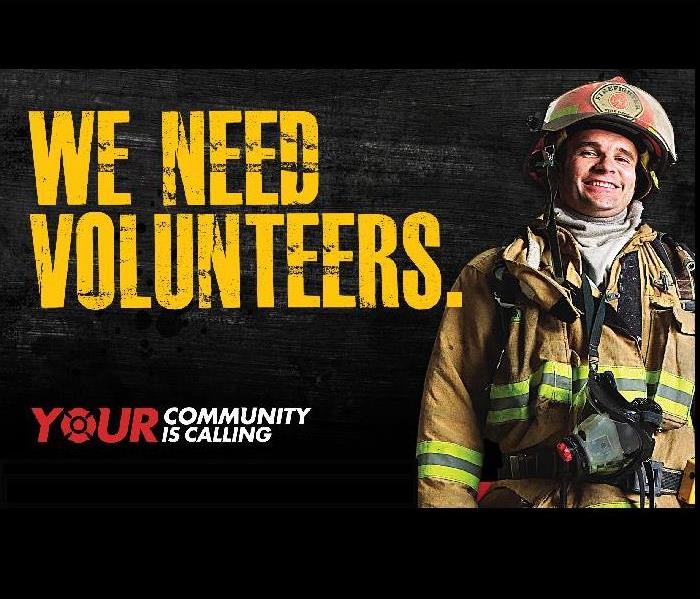 Become a Volunteer Firefighter
Become a Volunteer Firefighter
The volunteer fire company is a long and cherished tradition in our commonwealth, dating back to 1736 when Ben Franklin founded the nation’s first all-volunteer force to fight blazes in Philadelphia. For nearly three centuries, communities have relied on volunteer fire companies to protect property and save lives. Today, this volunteer model is in jeopardy. Across the state, local fire companies are struggling. Volunteers are dwindling. Costs are soaring. Training requirements have intensified. With donations and volunteers harder to come by, the future of the local fire company, long intertwined in the fabric of a community, looks grim. Without real, viable solutions to address this volunteer shortage, many local stations may be forced to close their doors. That means one thing: Pennsylvania is on the verge of a public safety crisis.
Time for action
Recently, township officials from across the state passed a resolution at the 96th Annual Educational Conference of the Pennsylvania State Association of Township Supervisors (PSATS) demanding that Gov. Tom Wolf call a special legislative session immediately to address the volunteer crisis facing local fire and emergency management services. Rep. Steve Barrar, chair of the state Veterans Affairs and Emergency Preparedness Committee, has embraced this call for a special session. Recent initiatives to tackle the crisis, including the bipartisan Senate Resolution 6 Commission, which has been tasked with studying issues affecting first responders, are a good step but they’re not enough, said Shirl Barnhart, PSATS immediate past president and a member of the SR 6 Commission. He noted that the deadline for the commission’s report is November 30, which coincides with the end of the legislative session.
“Instead, local leaders are imploring the legislature to act now, before General Election Day, and give this crisis the attention it deserves,” Barnhart said. “We’ve ‘talked the talk’ for long enough; it’s time to ‘walk the walk.’”
Consider these sobering facts:
Volunteers at fire companies across Pennsylvania have dropped from 300,000 strong in the 1960s and ’70s to below 50,000 today.
At least 75 percent of fire companies are struggling with manpower at a time when the state’s population is aging. The average age of a firefighter is 50-something, and people are busier today than they were decades ago.
Communities would have to raise taxes almost $10 billion a year to switch to a paid model for fire service, according to the office of the state fire commissioner.
Gov. Tom Wolf recently declared the opioid abuse problem in Pennsylvania an emergency disaster. Programs and funding have been dedicated to ending this deadly epidemic.
“As local officials who are witnessing the lethal consequences of opioid addiction in our communities, the members of PSATS support this commitment,” Barnhart said. “However, we also believe we have been dealing with the volunteer fire and EMS crisis for far longer. It’s time that our hard-working fire companies and volunteers receive the same attention and recognition from Harrisburg.”
This call for action isn’t intended to distract from the current opioid crisis. Instead, it is related. First responders are on the front lines of the opioid battle every day. If communities expect emergency personnel to respond to overdose calls, they can’t afford to lose any more foot soldiers in this war.
Too important to lose
Whether it’s helping at the scene of an overdose or putting out a house fire, volunteer fire and emergency responders keep the commonwealth’s communities safe. While local leaders are doing their best to keep this volunteer model alive, Barnhart said, they need help from the leaders in Harrisburg. PSATS and its members are urging the state legislature to immediately enact real and feasible solutions, such as allowing variable training standards for rural, suburban, and urban areas; granting a tax incentive for employers who permit employees to respond to calls while at work; and providing a fix for out-of-control insurance rates at the State Workers Insurance Fund (SWIF). If Pennsylvania doesn’t find real remedies soon, the day is not far away when someone calls 911 for help, and no fire company responds.
“We must make sure that never happens,” Barnhart said. “Our volunteer fire companies are simply too important to lose.”
(Excerpted from a Townships Today Newsletter)
SERVPRO becomes big around the nation in disaster restoration
7/3/2018 (Permalink)
 Members of the SERVPRO of Whitemarsh/Doylestown franchise. Photo by Gene Walsh / Times Herald Staff
Members of the SERVPRO of Whitemarsh/Doylestown franchise. Photo by Gene Walsh / Times Herald Staff
Copied from an article in the Times Herald Newspaper
By GARY PULEO
gpuleo@timesherald.com">gpuleo@timesherald.com
Posted: 09/07/11, 12:01 AM EDT | Updated: on 09/07/2011
WORCESTER - When it comes to “Dirty Jobs,” Mike Rowe has nothing on Andreo DiPrinzio. He may not be the star of his own TV show, but the owner of SERVPRO of Whitemarsh/Cheltenham gets a major rush from diving in to the muck and the mold when a large-scale cleanup job is in order. Clearing the decks after one of Mother Nature’s virulent tantrums is what brought DiPrinzio and his “minutemen” to the Poconos in late August. Lightning had severely damaged the roof of Swiftwater Elementary School, and SERVPRO’s job was to reinstate a normal environment in time for the first day of School on Aug. 29. It was the kind of disaster restoration that DiPrinzio thrives on, he admitted by phone after a few days of being knee-deep in the wreckage. “I love this stuff,” DiPrinzio said. “I got the call on Monday from the host office, so you just have to react. We call ourselves the “minutemen’ at times like that. You tell your wife and kids, I don’t know how big the project is or how long I’ll be gone. In my industry you have to take these things when you can because you’ll be lucky to go on two of these a year. Last year alone I worked in six states and was personally on the road for two months. We’re working against the clock to get this Swiftwater job done,” he added, “And if we have to ramp it up to a third shift, we will.”
SERVPRO of Whitemarsh/Cheltenham, which DiPrinzio launched 15 years ago, is part of a nationwide system of more than 1,500 franchises, which includes DiPrinzio’s second location, SERVPRO of Doylestown. Though the Whitemarsh/Cheltenham designation signifies SERVPRO’s geographical territory, DiPrinzio runs his flagship operation from a family property in Worcester called Abruzzi Farm. “If the host office gets a job, no one can handle a big job with 200 people that you need done in five days, so they call in the franchises,” DiPrinzio said. “It looks like all the work here is being done by SERVPRO of Monroe County, but technically there are close to nine franchises all working together on this building.” The Swiftwater project, which DiPrinzio estimated would cost $1 million, was not the typical “bread and butter” job that SERVPRO deals with on a regular basis, he noted.
“A typical job is between $3,000 and $5,000,” said DiPrinzio, who also owns DiPrinzio Building & Development Co. “A pipe breaks in your house from the hot water heater and pours water all over the floor. We’ll come in and cut up the carpet and spray for mold and mildew. Most other outfits just come in and suck water and don’t get involved in the construction, but because of my home building I contract out other repairs to my own company to take care of the whole job.”
Besides fixing up monumental messes, SERVPRO is also cleaning up in the numbers game as well. The company was recently recognized at a national convention for hitting the million-dollar mark in revenue. “It was the third time we went to a million dollars,” said DiPrinzio, a Bishop Kenrick graduate. With the Swiftwater Elementrary School project still in full swing, his services were being booked to mend destruction in the wake of Hurricane Irene. “I got an email from an insurance company that said we will pay you to mobilize so that once the hurricane hits you can start serving us exclusively for any damages that we have,” he said. “After 15 years my back is broken, and you won’t see at a small $2,500 job. I’m personally committed to going to the large losses now. It’s what I give to my company, for lack of a better word.”
Fireworks on the 4th: Celebrate Safely
7/2/2018 (Permalink)
Fireworks are synonymous with our celebration of Independence Day. This is the first Fourth of July in Pennsylvania since the laws governing the purchase of fireworks have been relaxed. Currently, any adult with a PA driver’s license can purchase some pretty high powered and dangerous fireworks. Yet, the thrill of fireworks can also bring pain. On average, 280 people go to the emergency room every day with fireworks-related injuries in the days surrounding the July 4th holiday.
Remember, fireworks can be dangerous, causing serious burn and eye injuries. You can help us prevent fireworks-related injuries and deaths. How? Follow these safety tips when using fireworks:
- Never allow young children to play with or ignite fireworks.
- Avoid buying fireworks that are packaged in brown paper because this is often a sign that the fireworks were made for professional displays and that they could pose a danger to consumers.
- Always have an adult supervise fireworks activities. Parents don't realize that young children suffer injuries from sparklers. Sparklers burn at temperatures of about 2,000 degrees - hot enough to melt some metals.
- Never place any part of your body directly over a fireworks device when lighting the fuse. Back up to a safe distance immediately after lighting fireworks.
- Never try to re-light or pick up fireworks that have not ignited fully.
- Never point or throw fireworks at another person.
- Keep a bucket of water or a garden hose handy in case of fire or other mishap.
- Light fireworks one at a time, then move back quickly.
- Never carry fireworks in a pocket or shoot them off in metal or glass containers.
- After fireworks complete their burning, douse the spent device with plenty of water from a bucket or hose before discarding it to prevent a trash fire.
- Make sure fireworks are legal in your area before buying or using them.
Remember that fireworks have caused a lot of household fires. If you have a fireworks mishap resulting in fire damage, call SERVPRO of Doylestown for fire restoration services. SERVPRO of Doylestown wishes everyone in the area a safe and fun Fourth of July!
Hurricane Preparedness in Our Area
5/30/2018 (Permalink)
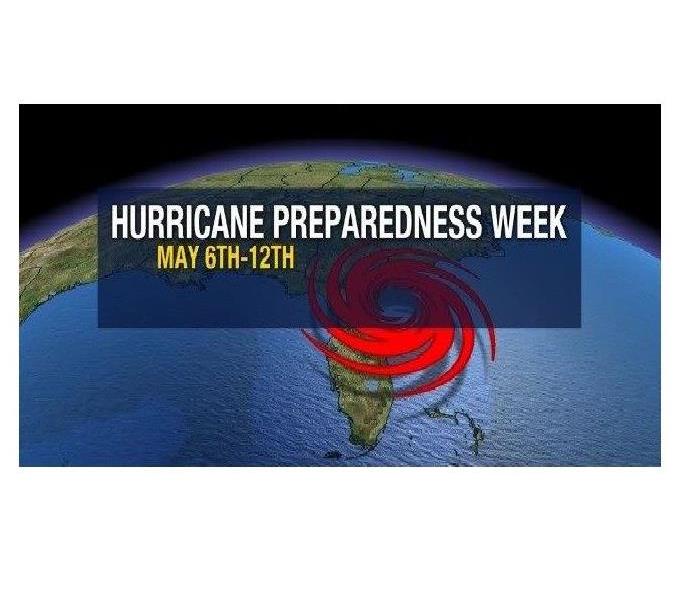 National Hurricane Preparedness Week May 6-12
National Hurricane Preparedness Week May 6-12
Hurricane Preparedness - Be Ready
While we are not located close enough to the ocean to feel a hurricane’s full effect on a regular basis, hurricanes always pose a wind and water damage threat to our property. Two keys to weather safety are to PREPARE for the risks and to ACT on those preparations when alerted by emergency officials. According to the FEMA, we can prepare for a hurricane by following this four stage guide:
Gather Information
Know if you live in an evacuation area. Assess your risks and know your home's vulnerability to storm surge, flooding and wind. Understand National Weather Service forecast products and especially the meaning of NWS watches and warnings. Contact your local National Weather Service office and local government/emergency management office. Find out what type of emergencies could occur and how you should respond.
Contacts
Communications is important during a weather emergency. Keep a list of contact information for these resources:
Emergency Management Offices, County Law Enforcement, County Public Safety Fire/Rescue, State, County and City/Town Government, Local Hospitals, Local Utilities, Local American Red Cross, , Local TV Stations, Local Radio Stations, Your Property Insurance Agent
Plan & Take Action
Everyone needs to be prepared for the unexpected. Your friends and family may not be together when disaster strikes. How will you find each other? Will you know if your children or parents are safe? You may have to evacuate or be confined to your home. What will you do if water, gas, electricity or phone services are shut off?
Supplies Kit
Put together a basic disaster supplies kit and consider storage locations for different situations. Help community members do the same.
Emergency Plans
Develop and document plans for your specific risks. Protect yourself and family with a Family Emergency Plan. Be sure to plan for locations away from home. Pet owners should have plans to care for their animals. The Centers for Disease Control & Prevention offer information on animal health impacts in evacuation shelters.
Evacuation
Review the FEMA Evacuation Guidelines to allow for enough time to pack and inform friends and family if you need to leave your home. FOLLOW instructions issued by local officials. Leave immediately if ordered!
Consider your protection options to decide whether to stay or evacuate your home if you are not ordered to evacuate.
When waiting out a storm be careful, the danger may not be over yet. Be alert for Tornadoes, as they are often spawned by hurricanes. The calm "eye" of the storm – it may seem like the storm is over, but after the eye passes, the winds will change direction and quickly return to hurricane force.
Recover
Wait until an area is declared safe before returning home. Remember that recovering from a disaster is usually a gradual process.
Resources
Here are some additional resources for Hurricane Preparedness
- Refer to the Federal Emergency Management Agency's (FEMA) gov/hurricanes for comprehensive information on hurricane preparedness at home and in your community.





 24/7 Emergency Service
24/7 Emergency Service

































































































